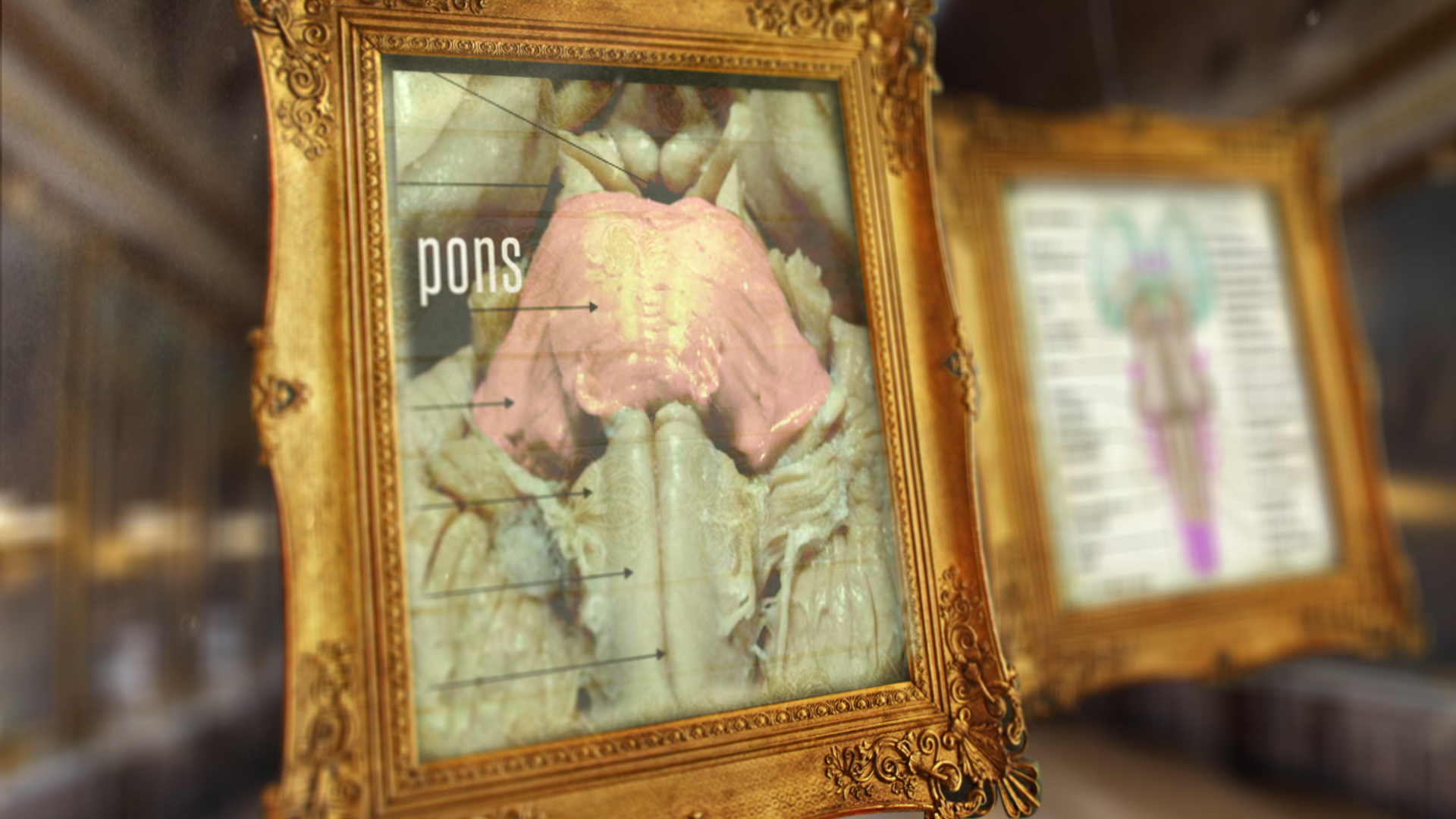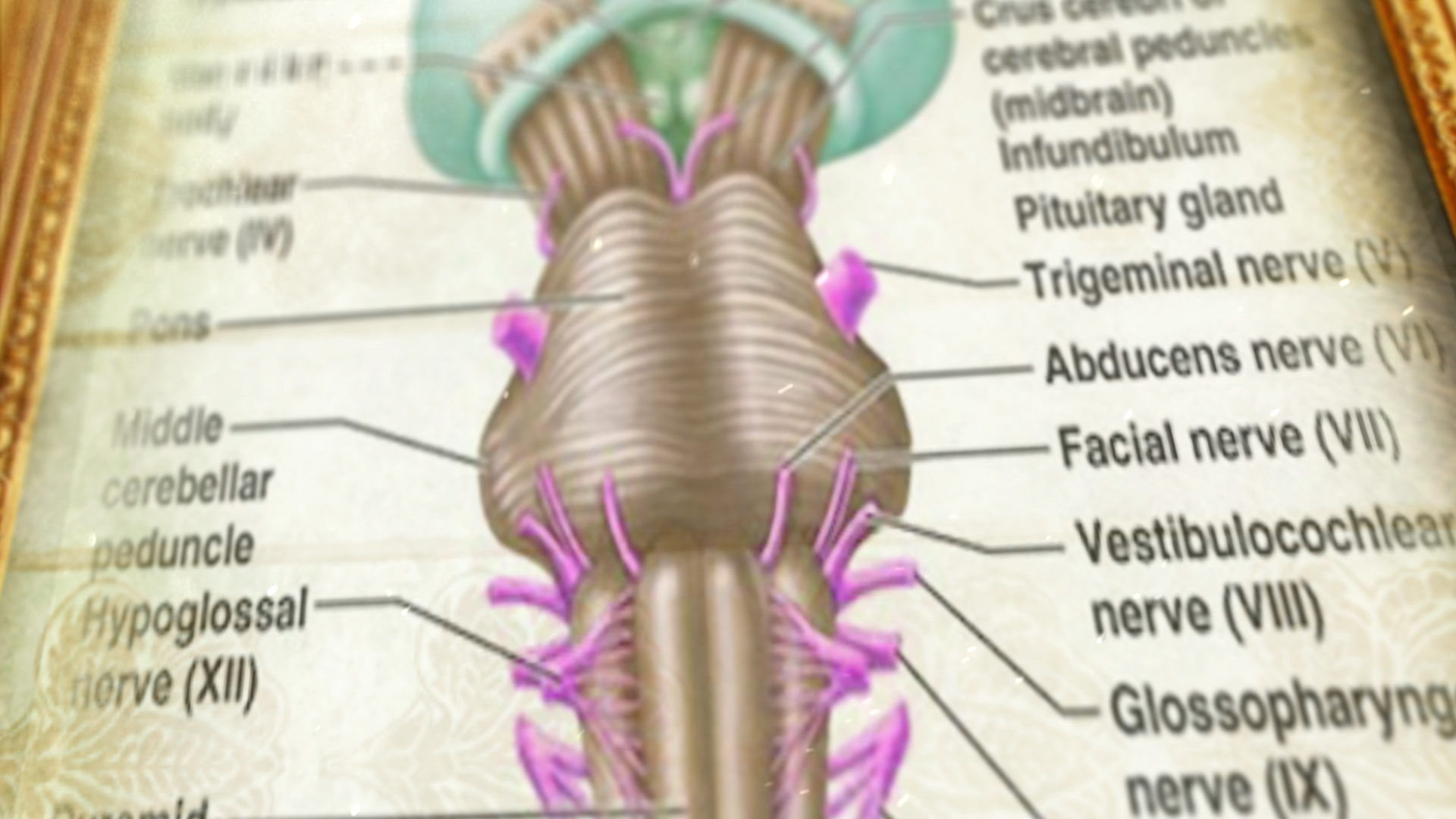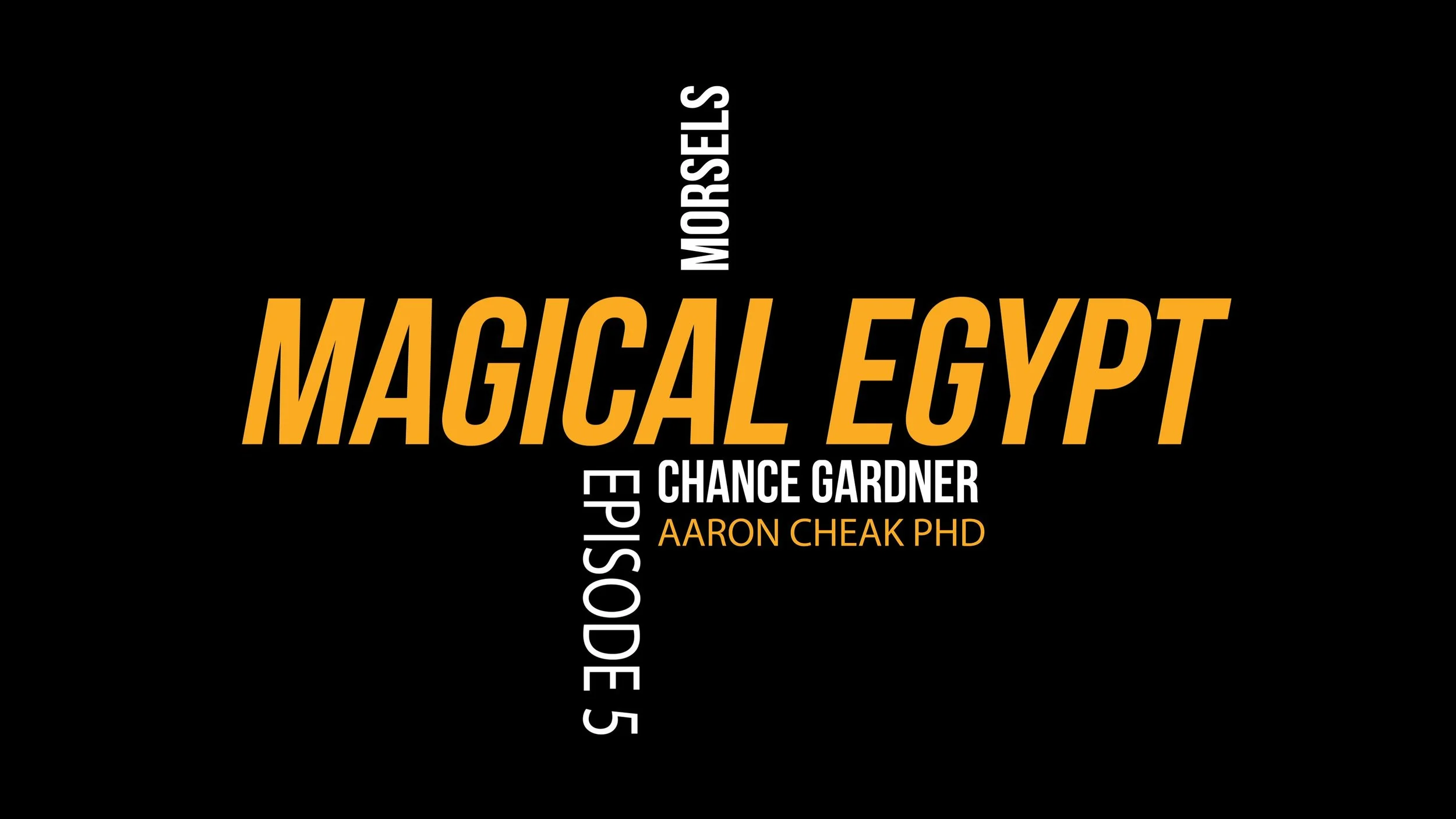


Discoveries
Discoveries
New Discoveries in Magical Egypt 2
In 2008 a team of career artists, art and architecture historians, and comparative mythology scholars began a ten-year research project to study ancient aesthetic canons and related forms of visual expression used in Ancient Egypt. “Magical Egypt” presents the results of the project in the new season of the documentary series.
The team has discovered a previously unrecognized visual language, a type of visual cipher, hidden in the hieroglyphic reliefs, statuary, and architectural motifs of ancient Egypt. The message encrypted in this visual language is scientific. It records and transmits the core principles of a very sophisticated ancient science.
The discovery holds severe implications for art history as well as scientific history. These discoveries show an unprecedented marriage of art and science that allows central scientific principles to be communicated visually, in a trans-lingual mode of transmission.
These discoveries stand at odds with the generally held view that the ancient Egyptians did not know what the brain was for, and are confrontational to the generally agreed-upon picture of the ancient psyche and the level of scientific sophistication in place in the ancient world.
Just as surprising as the sophistication of the ancient science is its focus - the artwork transmits beautifully encrypted schematics of brain architecture and other biological systems: most having to do with either the mystery of consciousness or the mystery of reproduction.
The more examples the team compiled, the more it seemed that the entire culture was a giant expression of an ancient story told through art and symbol. The story serves as an allegory, or to use a more modern term, a dynamic model of the mysteries of consciousness itself. First, it schematizes the vital biological systems that are involved with consciousness. Then, through the use of mythos, legend, and symbol, it ascribes to them an array of descriptors, specific behaviors, tendencies, affinities, and other operational, functional information making for a brilliant transmission of both the form and function
Chance Gardner and Brad Klausen Discuss their Findings
Historical Precedent For Biological Correspondence in Art
A precedent for biological correspondence in art was set in the Oct 10th, 1990 Issue of JAMA when Dr. Frank Meshberger published the theory and the visual proofs that Michaelangelo had depicted a brain in his painting “The Creation of Adam” on the ceiling of the Sistine Chapel. When the painting is compared with or overlaid upon its “biological correspondence”, in this case, the human brain in sagittal view, we see that not only does it demonstrate a sophisticated knowledge of the physical attributes of the brain, but it marries symbolism to each location to suggest the function of the various physical systems. A particular emphasis is placed on Sophia, goddess of divine knowledge, emerging from the midbrain, diencephalon complex at the area where the thalamus, third and fourth ventricles, and choroid plexus are located. This seems to be the juncture of our circulatory, nervous, and endocrine systems, that is repeatedly pointed to in the ancient science. Thus in these artistic traditions, it is associated with a specific kind of divinity.
Another precedent for biological correspondence in art was set in Dec 2007 when Alessandro Paluzzi, Antonio Belli, Peter Bain, and Laura Viva published Brain ‘imaging’ in the Renaissance discussing several examples of hidden symbolism in Renaissance paintings including Gerard David's painting of the ‘Transfiguration of Christ’ resembles a coronal section of the brain.
You can find the complete text and other examples here ( https://www.ncbi.nlm.nih.gov/pmc/articles/PMC2121627/)
Once we were alerted to the presence of this technique, it became visible in the sacred art of other cultures as well, eventually leading to recognizing this ancient scientific message in use from the very earliest expressions of sacred art.
A new kind of Rosetta Stone: The decoder ring of “biological correspondence.”
The discovery of the Rosetta Stone was a profoundly significant discovery for early Egyptologists who were trying to understand how to read hieroglyphics. Because the Rosetta Stone duplicated an identical message in three languages, it eventually gave linguists the ability to cross-analyze and compare an Egyptian text with the better understood Greek and Hieratic writings, whose meanings were known. It also alerted linguists and Egyptological researchers to the fact that the hieroglyphs and reliefs can hold multiple registers or layers of meaning at once.
The discovery of a hidden visual encryption technique that the team refers to as Biological Correspondence is significant in a very similar way to the Rosetta Stone because it allowed for the discovery of a layer of communication, as well as an unrecognized message. This message was hidden in plain sight, radiating through the art, statuary, and architecture of Ancient Egypt, expressing the most central scientific principles known to the ancient culture.
One of the biggest initial surprises was that the message is not theological - it is scientific. And perhaps more interestingly still, the science it expresses is an anomalously sophisticated one that calls into question everything we thought we knew about the ancient intellect. The message may go a long way towards answering some of the biggest mysteries of Egyptology and human history.
Below is a presentation of some of the significant discoveries presented in the Magical Egypt season 2 documentary series..
DISCOVERY #1 Eye of Horus correlation with the human limbic system.
Author Gary Osborn discovered the earliest of the visual correspondences at the end of 1997. Gary had been researching the unusual layout and geometric measures encrypted in the great pyramid of Giza, especially the odd arrangement of the interior chambers known as the kings and queens chambers. With the suspicion that their odd placement in the structure was meaningful, Gary had the epiphany of overlaying a sagittal view outline of the human brain upon a schematic of the pyramid interior. He found that the spacial relationship between the inner structure of the pyramid and the brain were related, particularly the architecture of the chambers in the great pyramid and that of key structures of the brain.
As Gary began checking other significant hieroglyphs and architectural structures, he compared the iconic eye of Horus to the sagittal view of the human brain. The correlation was immediately apparent. Not only was there a direct correspondence between the eye of Horus symbol and the human limbic system, but it was so specific as to render the image a perfect diagram or schematic of this key conjuncture of brain systems. It not only demonstrates a very sophisticated understanding of brain structure but seems to be hinting at the actual function of each of the components that make up the central limbic system of the brain.
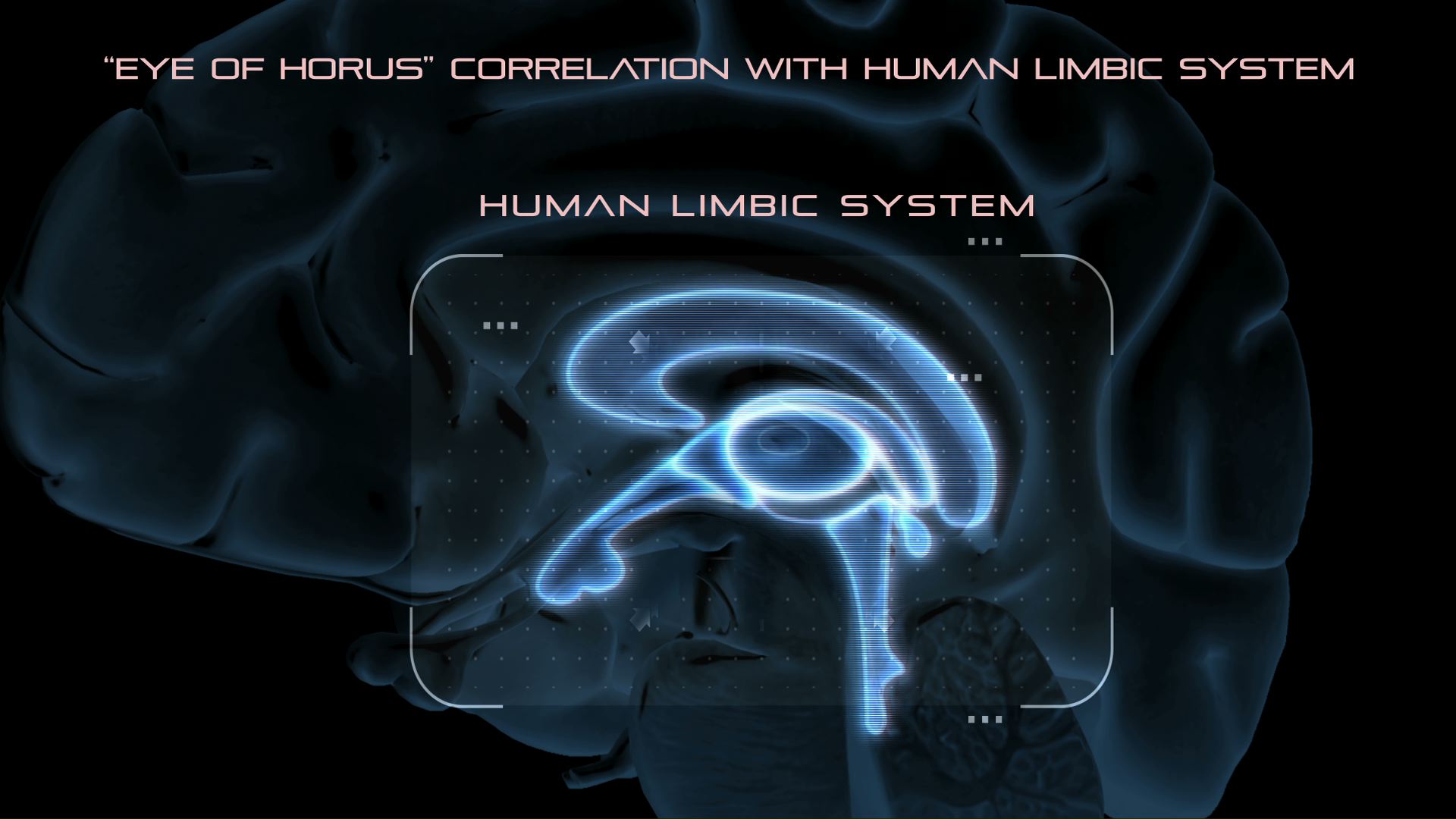
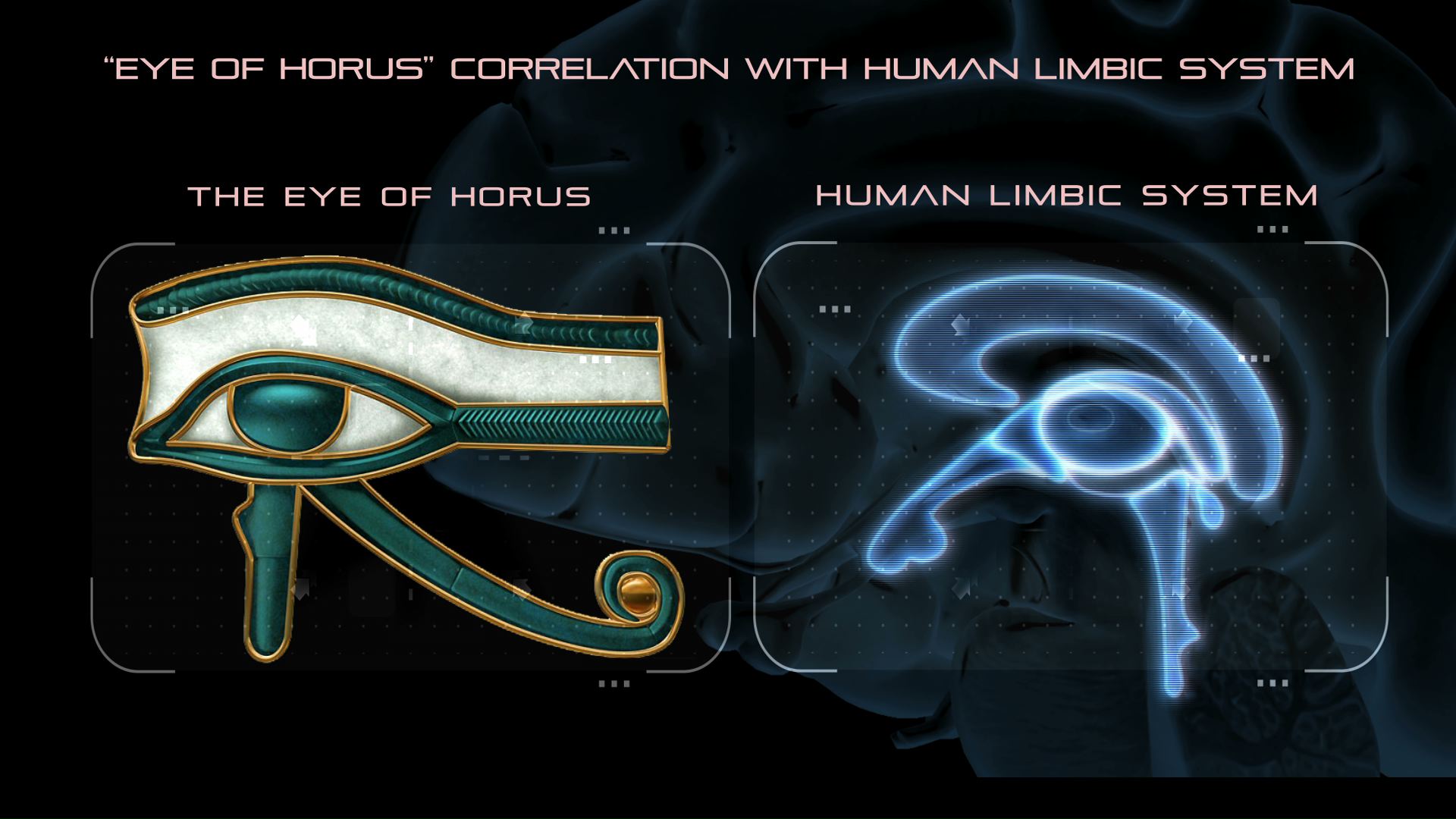
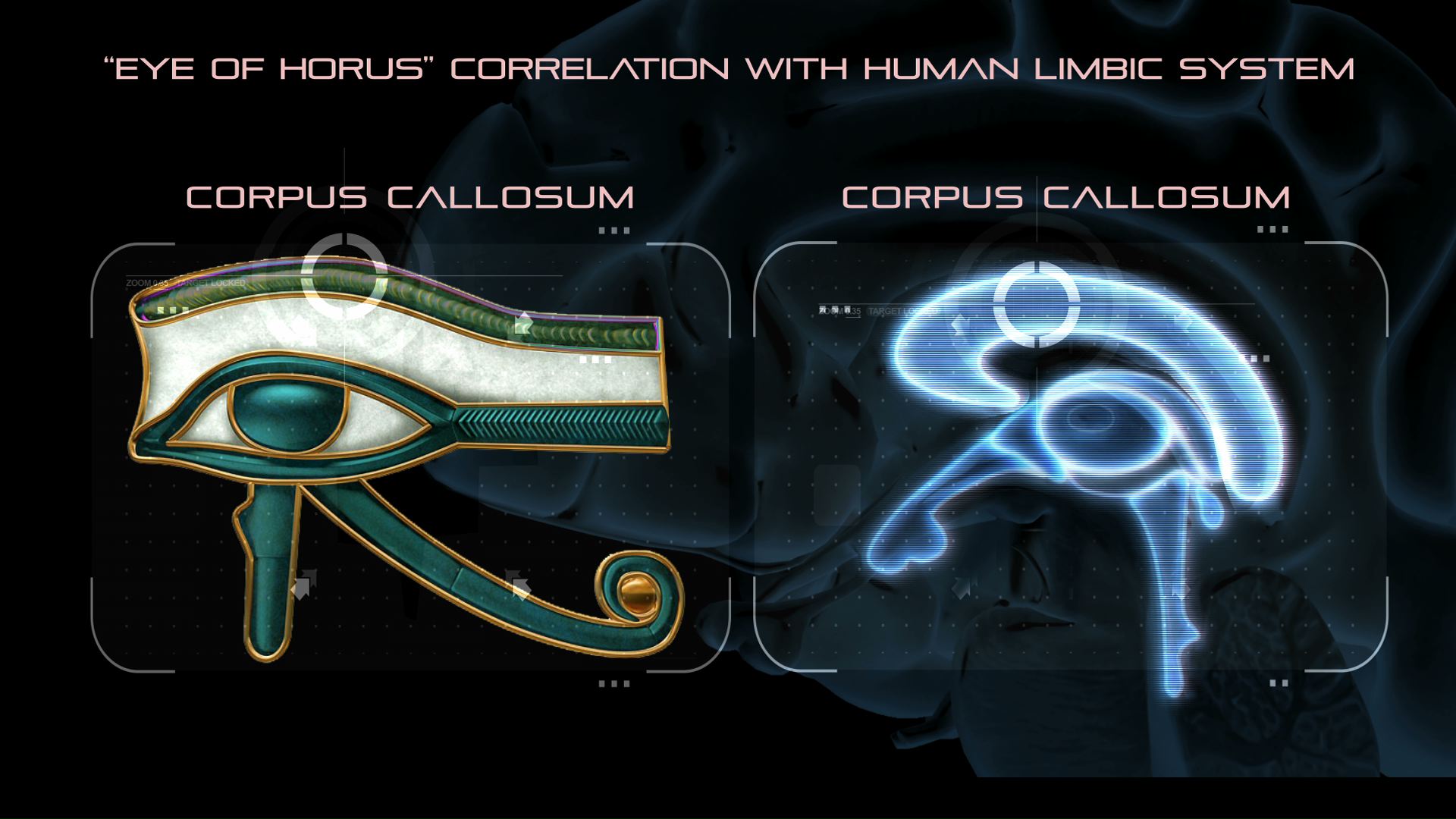

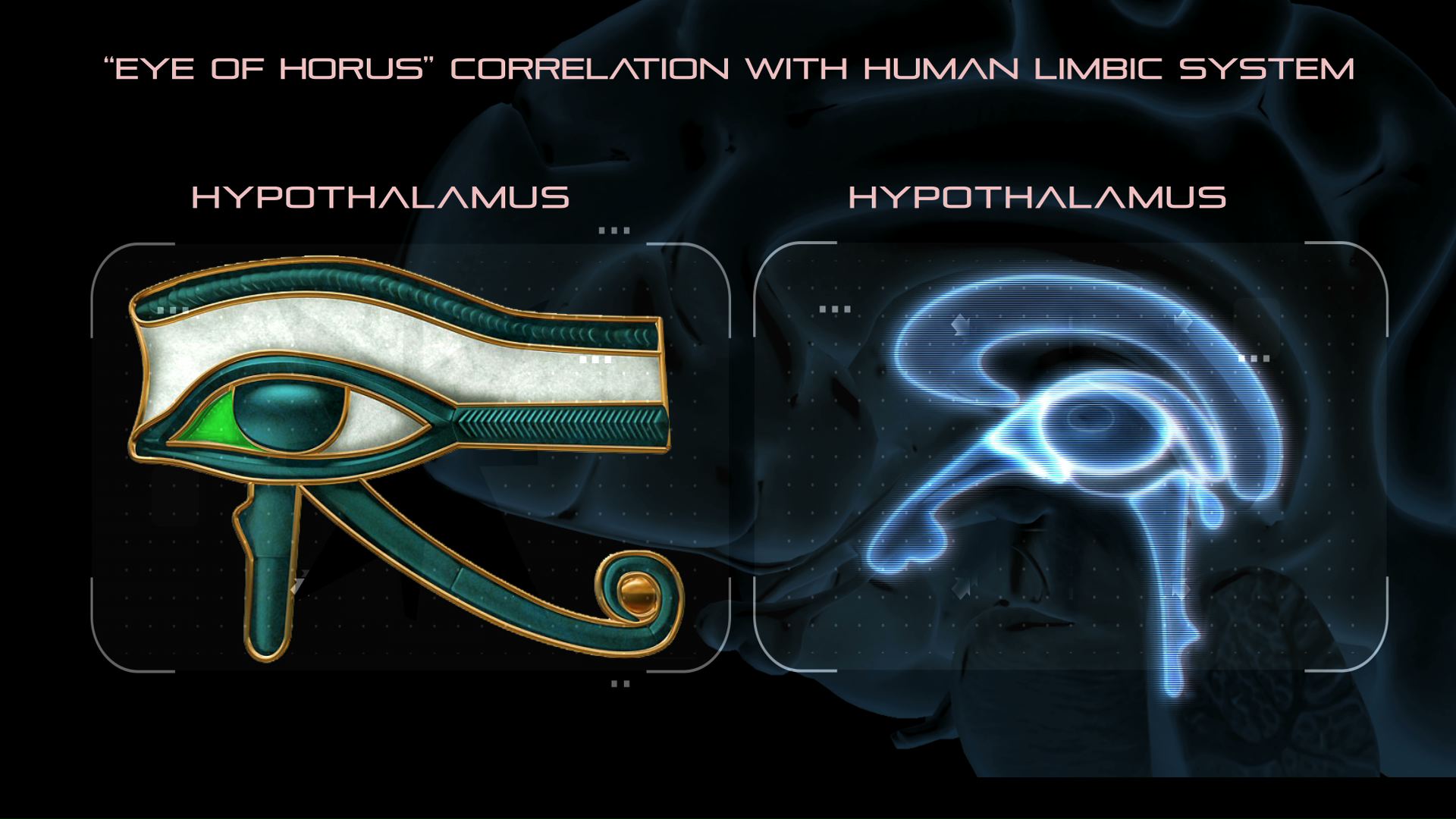
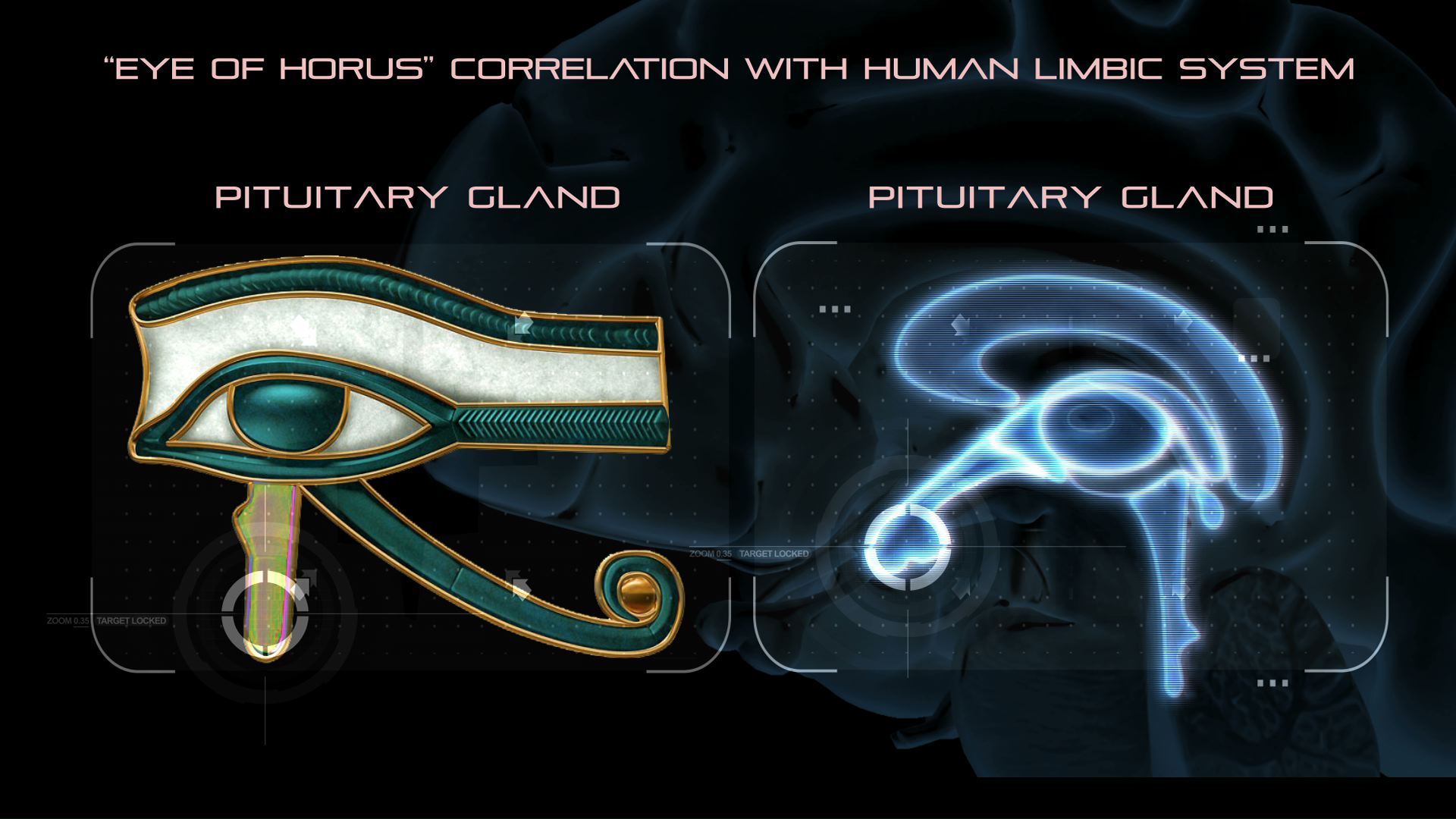
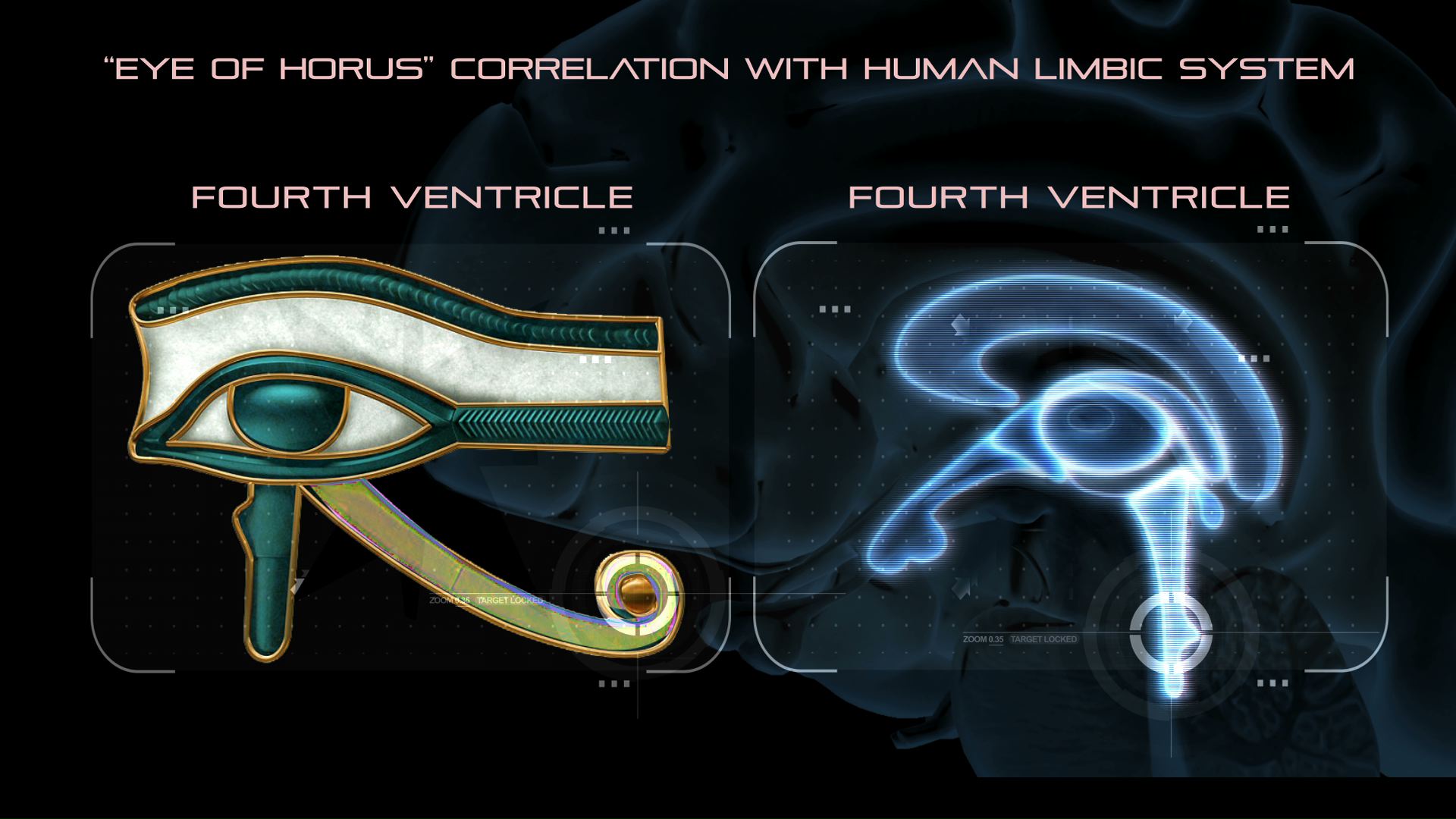
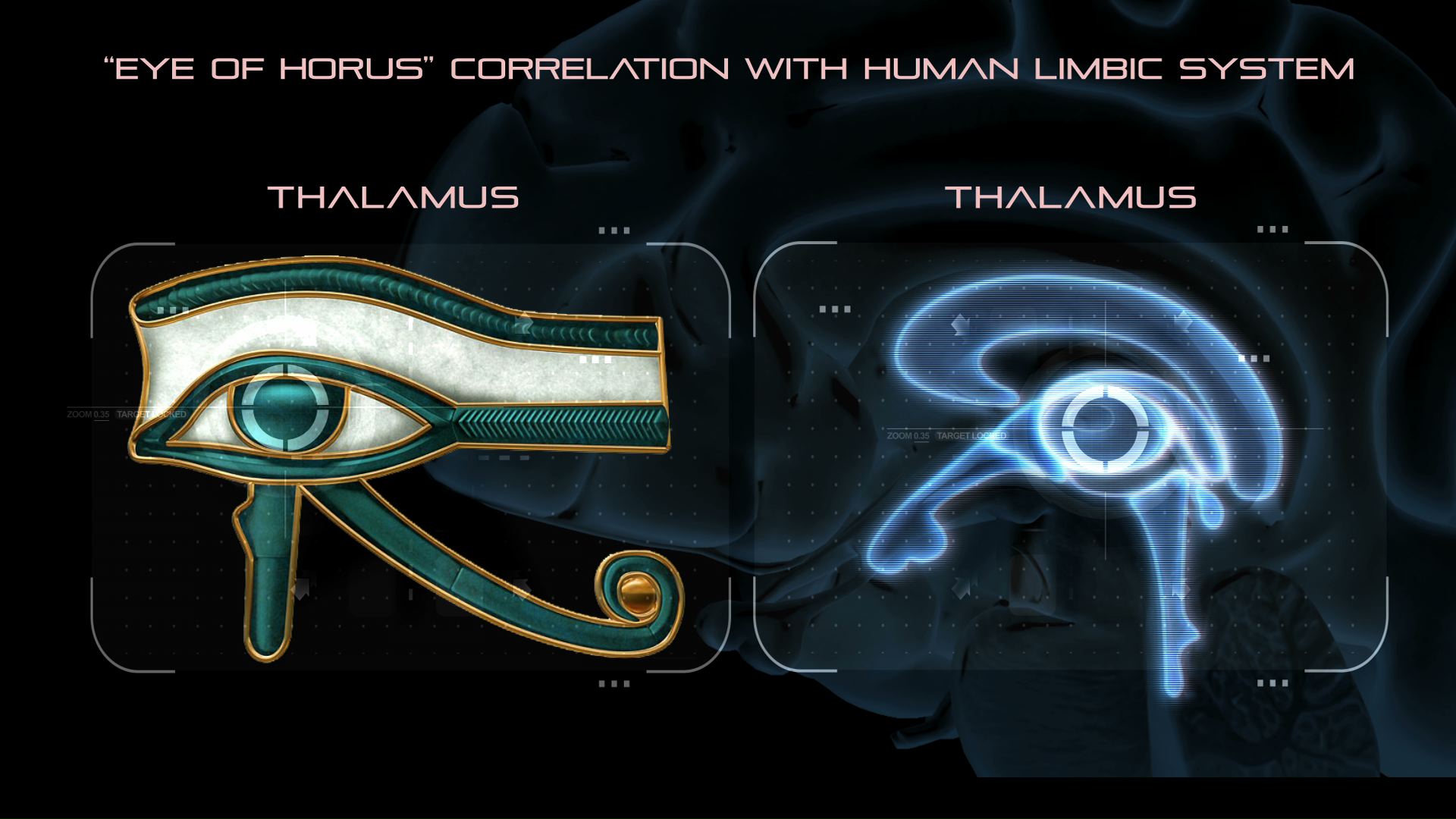
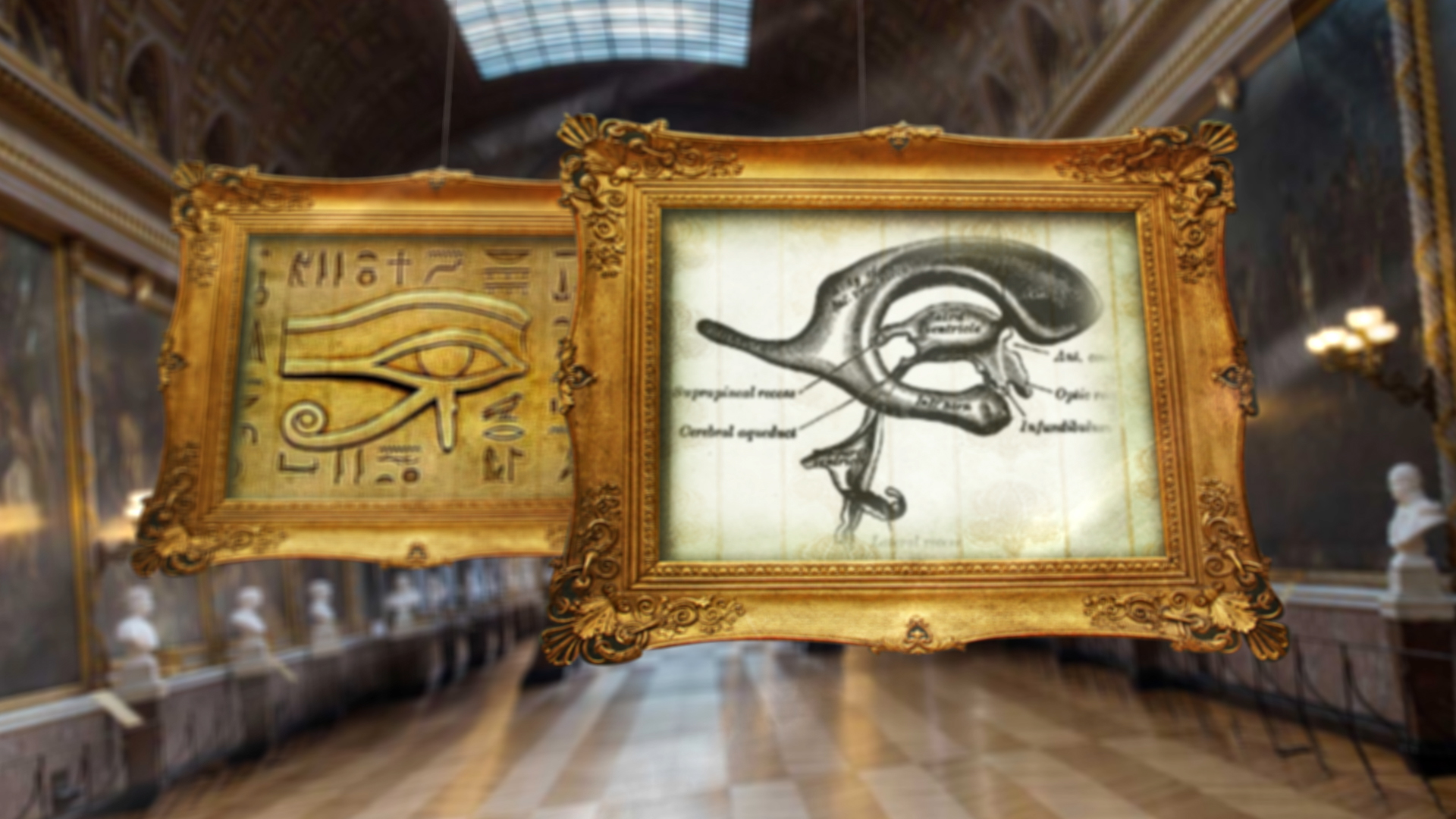
Here the technique allows the transmission of both the form and function of components of the brain. In this case, the iconic image of the Eye of Horus is mythologically associated with “mind,” or “mind’s eye,” and shares many similarities and parallels with the concept of the Third Eye from Vedic tradition, while at the same time serving as a sophisticated and accurate map of brain structure. In this way, the thalamus, pineal, pituitary gland and the 3rd and 4th ventricles are accurately schematised and symbolically associated with an emergent property of consciousness or awareness, beautifully encrypted into the hieroglyphic symbol known as the Eye of Horus.
Notice the close parallel between the third and fourth ventricles and the shape of the eye of Horus. Another example of the breathtaking genius with which the ancients synergised art and science to transmit the deepest secrets of the universe.
This correlation was first presented in 2003 at: http://garyosborn.moonfruit.com/#/eye-of-horus/4573273634
Great Pyramid alignments; http://garyosborn.moonfruit.com/#/chamber-gland-theory/4573544142
DISCOVERY #2: Ram sphinx terminals correlate to coronal view of human brain stem:
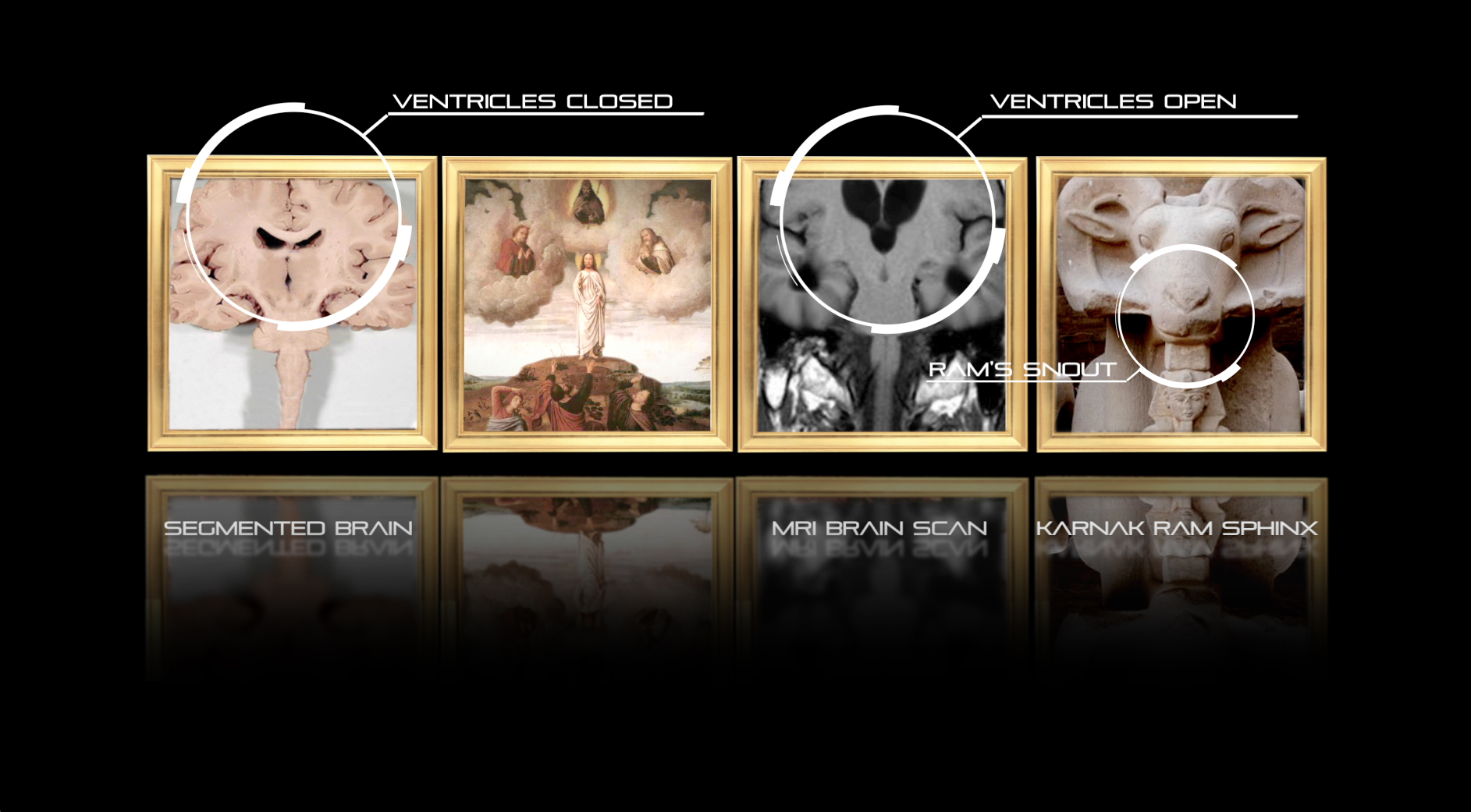
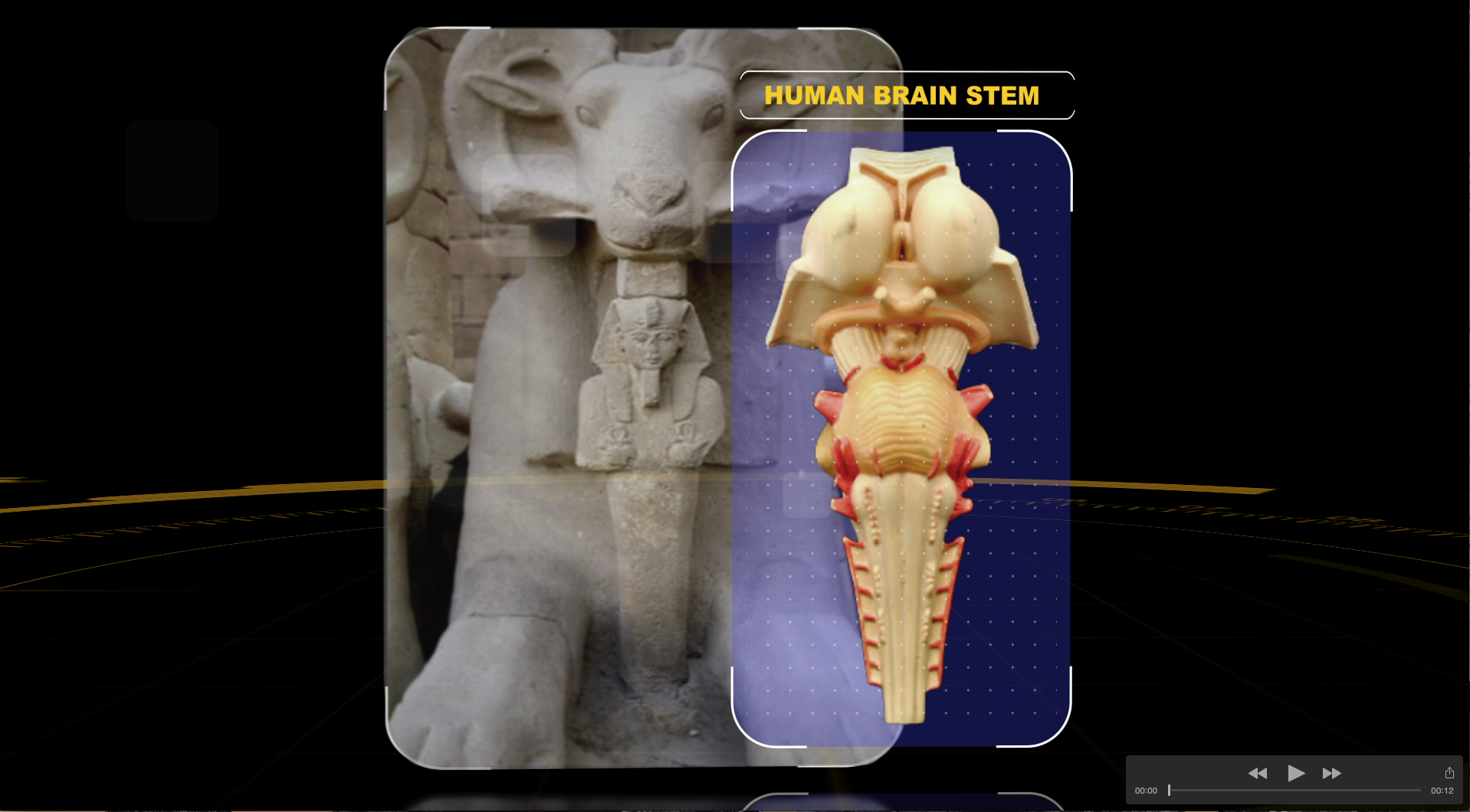
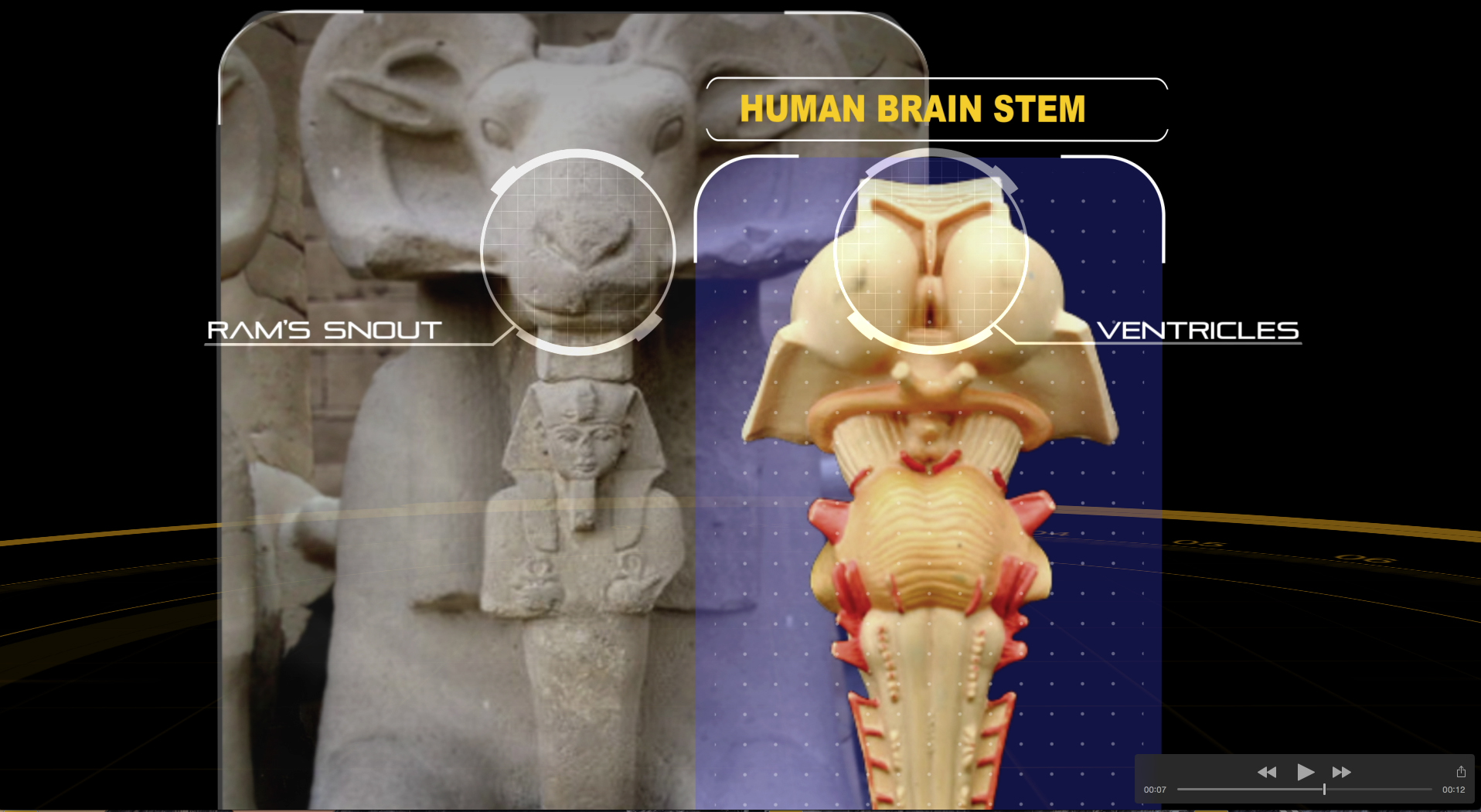
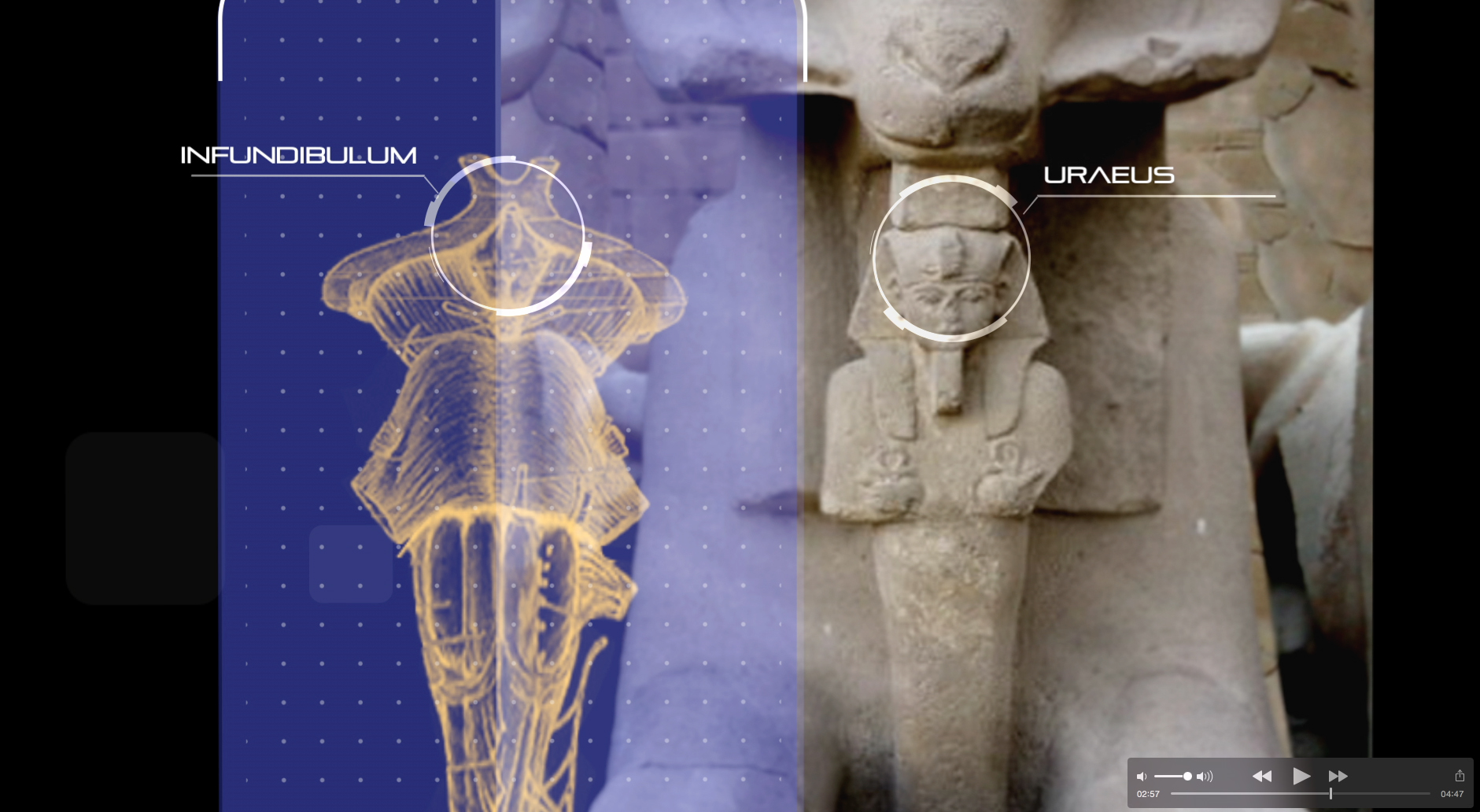
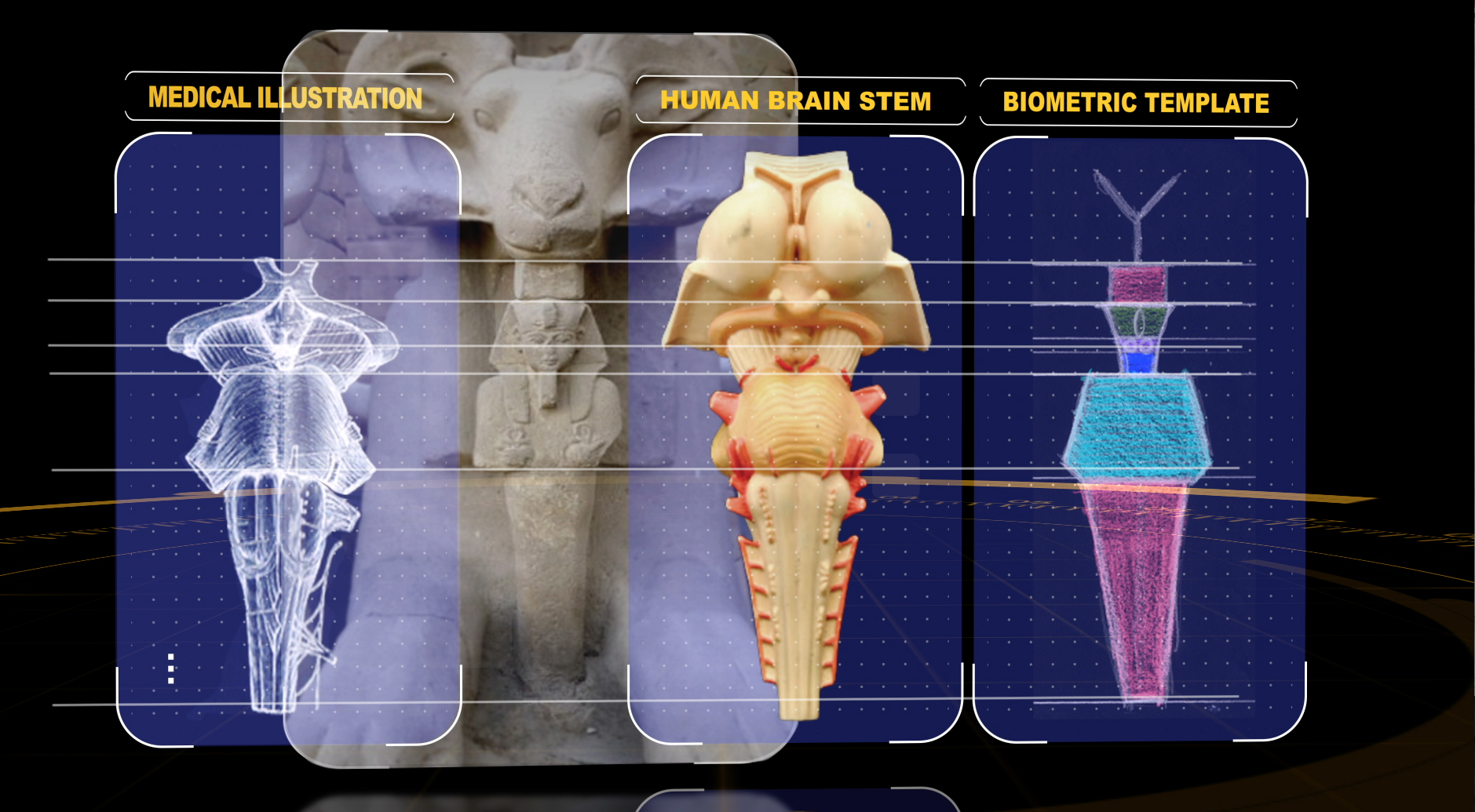
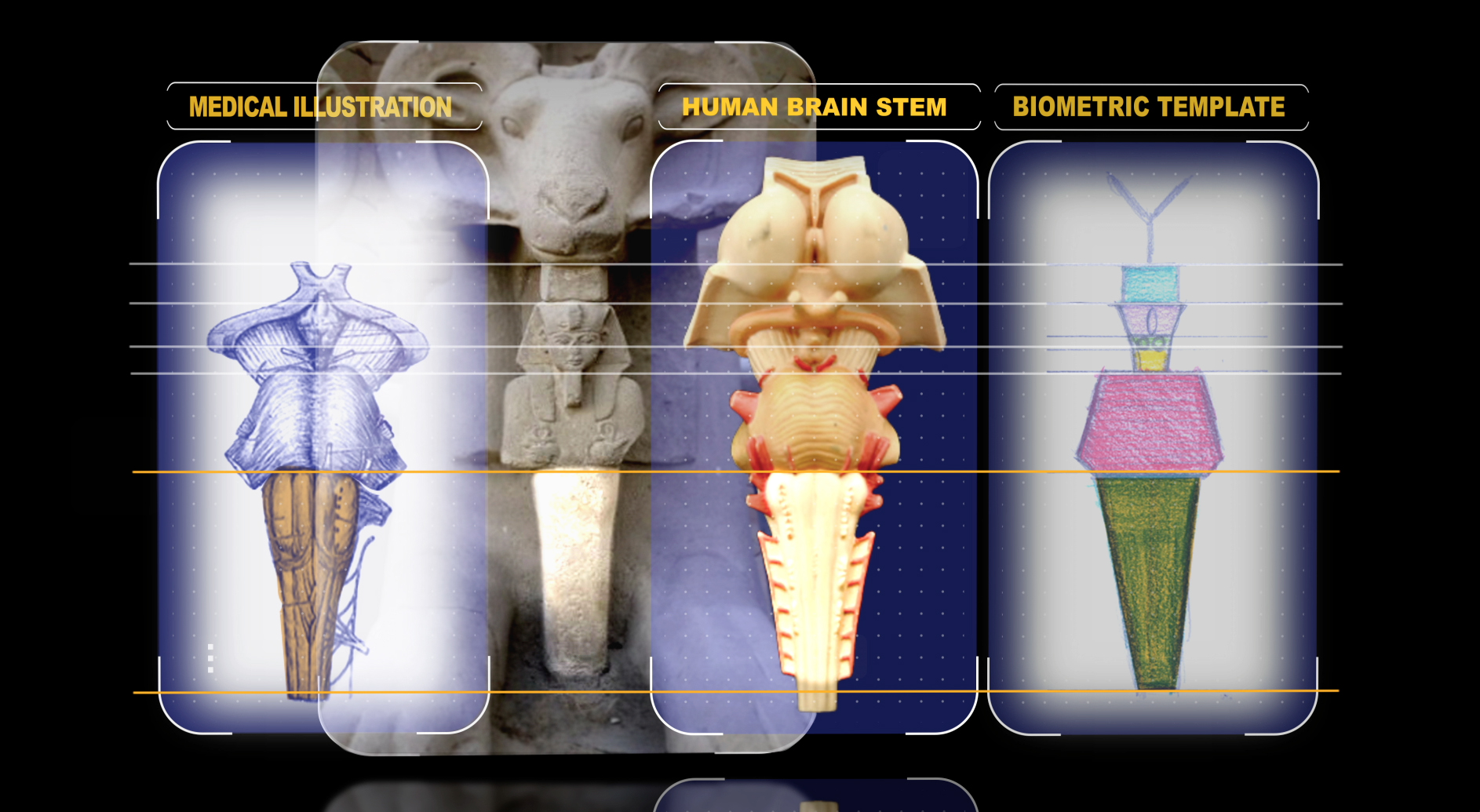
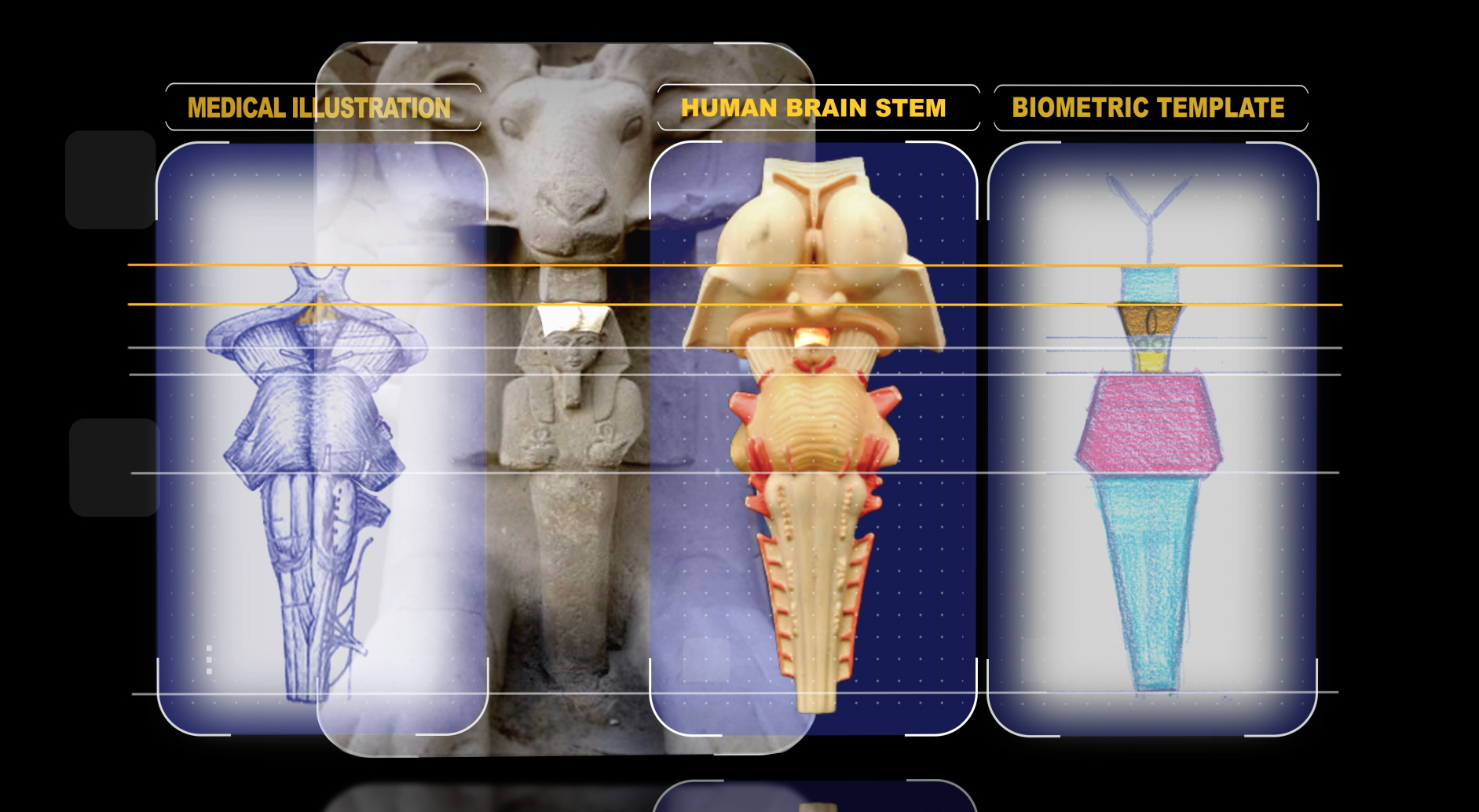
Brad Klausen found a direct representational correspondence between the Ram Sphinx statuary at Luxor and Karnak and the “coronal” or “front-facing” view of the human brain stem. Each aesthetic feature that makes up the ram sphinx and terminal has a direct correspondence to one of the articulations that make up the brain stem. Not only do the shapes and outlines correspond, but upon closer study, there is no detail in the statuary that is not directly representative of a key component of the human brain stem. Click below for an excerpt from Magical Egypt series 2 that demonstrates the morphological correspondences between the human brain stem and the ram sphinx statuary and terminals.
Discovery #3: Brainstem depicted in ancient Babylonian and Sumerian sacred art
The very distinctive shape, location, and positioning of the trigeminal nerves in relation to the pons and brainstem was the next clue. Note the uncanny similarity between the trigeminal nerves and the placement of the hands in the iconic Ishtar and Innana statues from Babylon and Sumeria. Also, note the obvious correlation between the pons of the brain stem and the torso of the statues. The merged legs and the articulations of the headwear are also direct correspondences, both in form and position.
click below to view a slideshow or watch a clip detailing the correspondences:
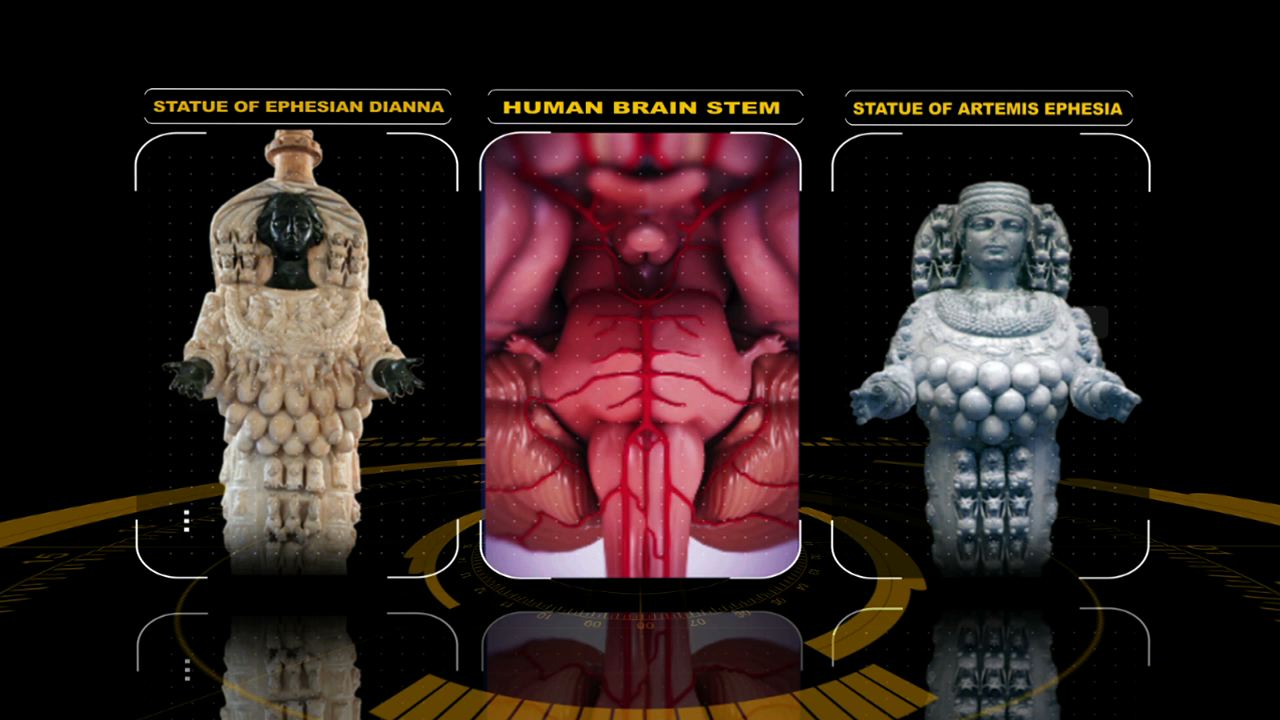
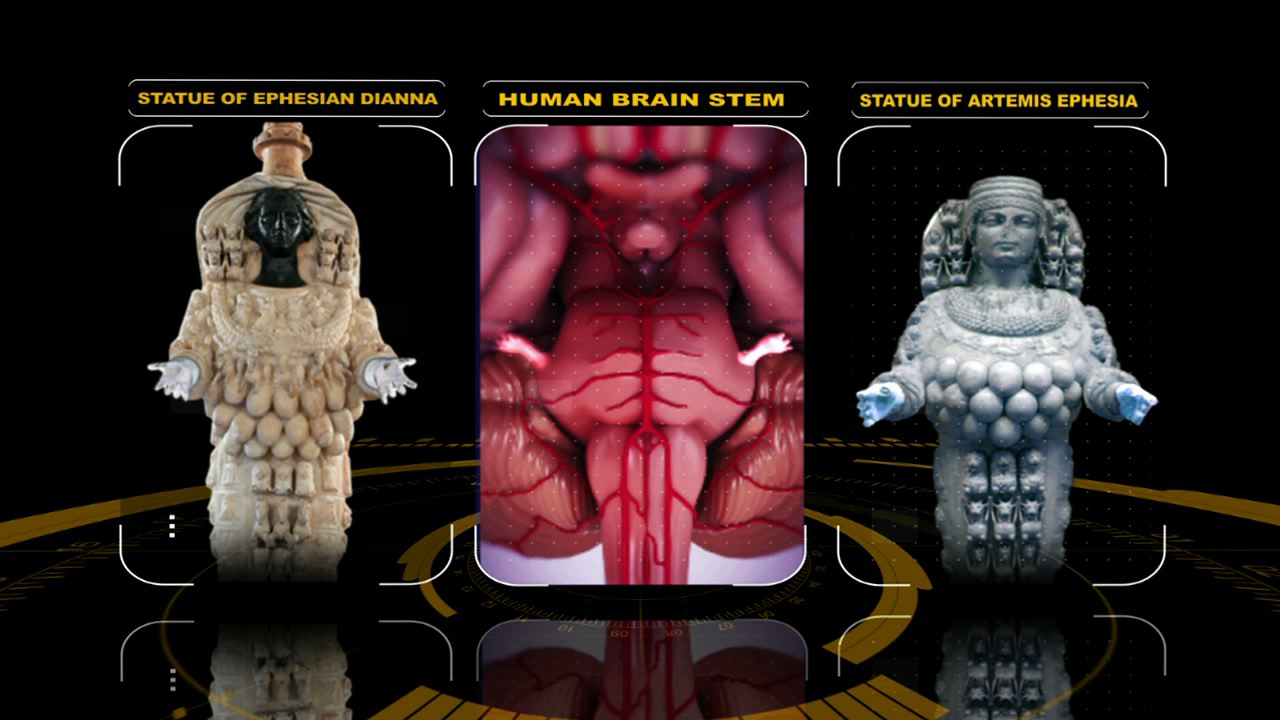
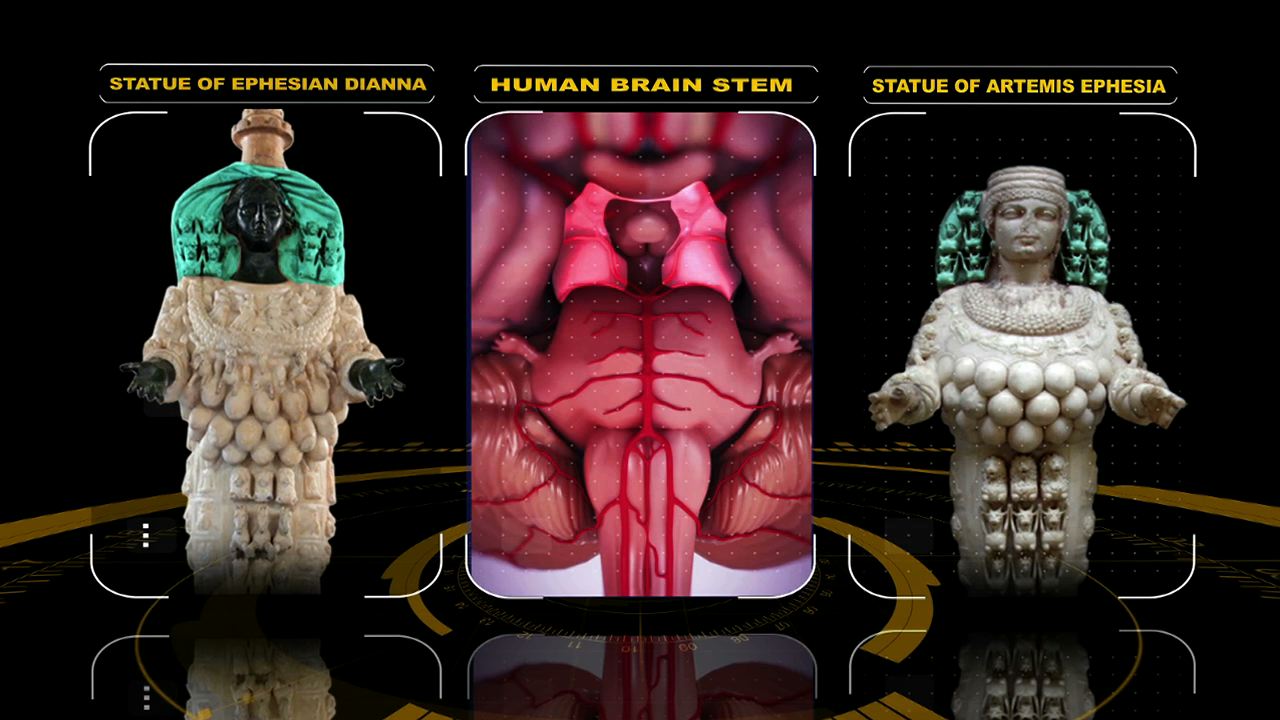


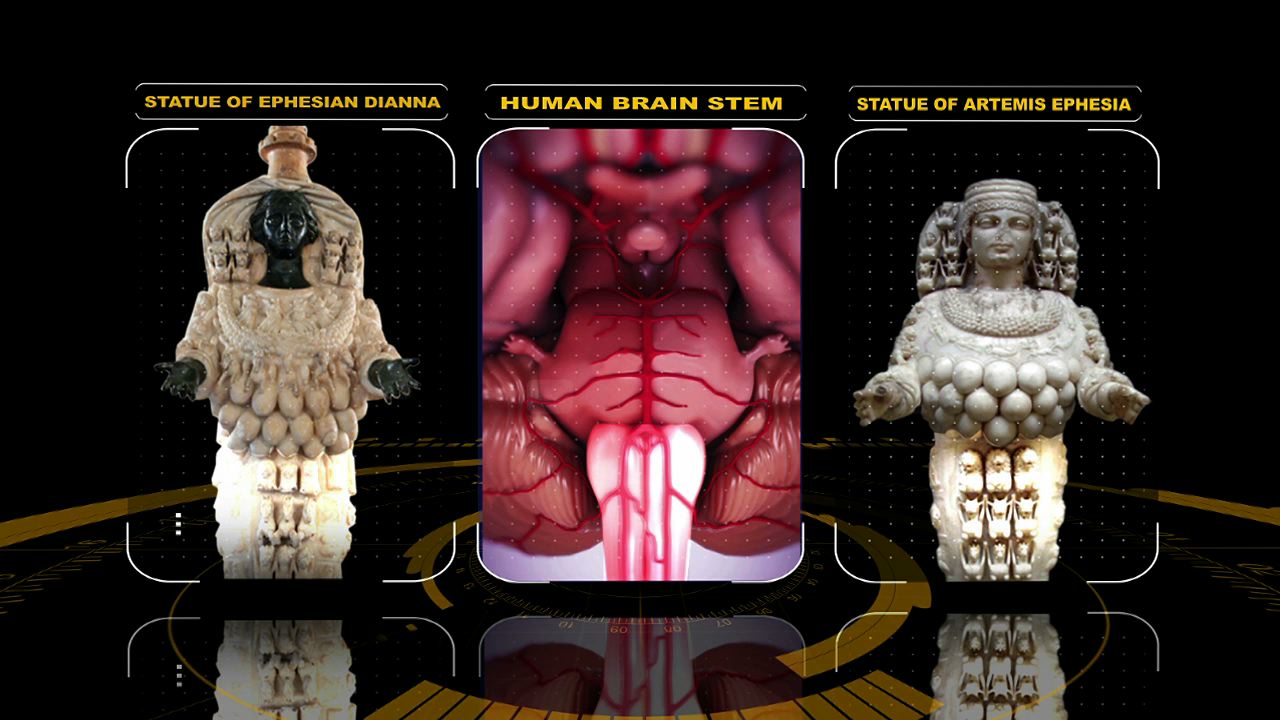
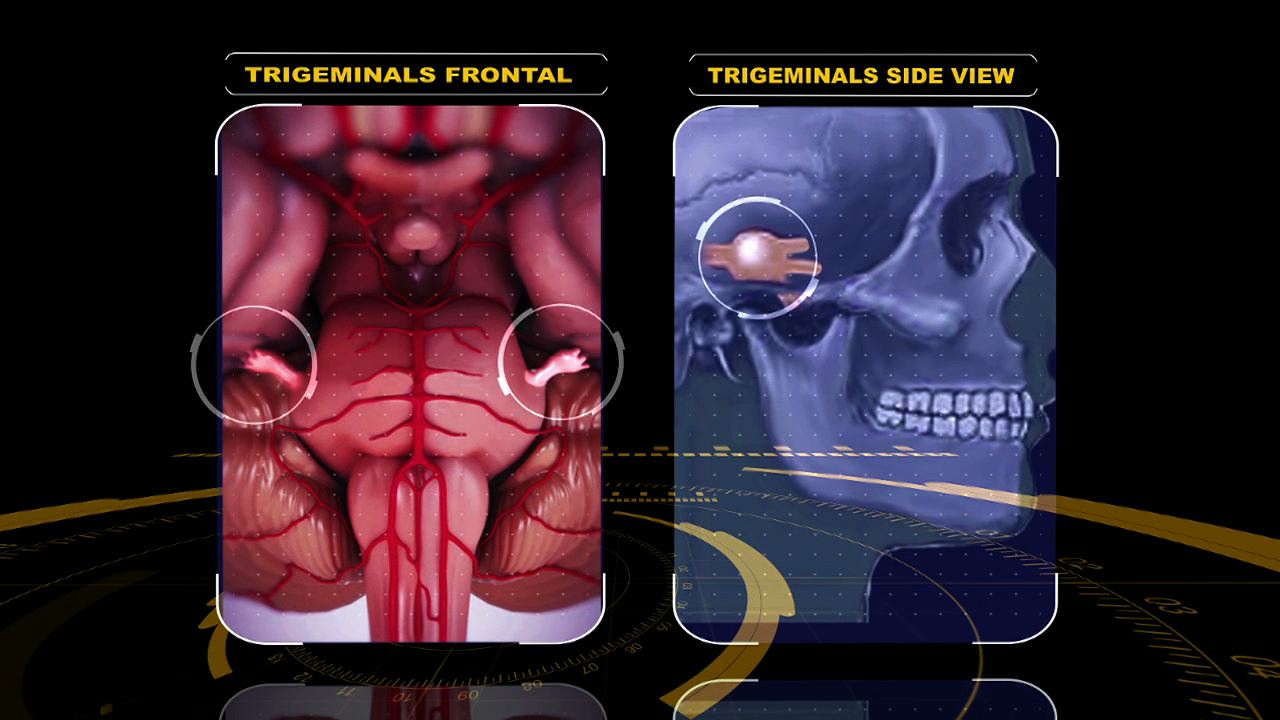

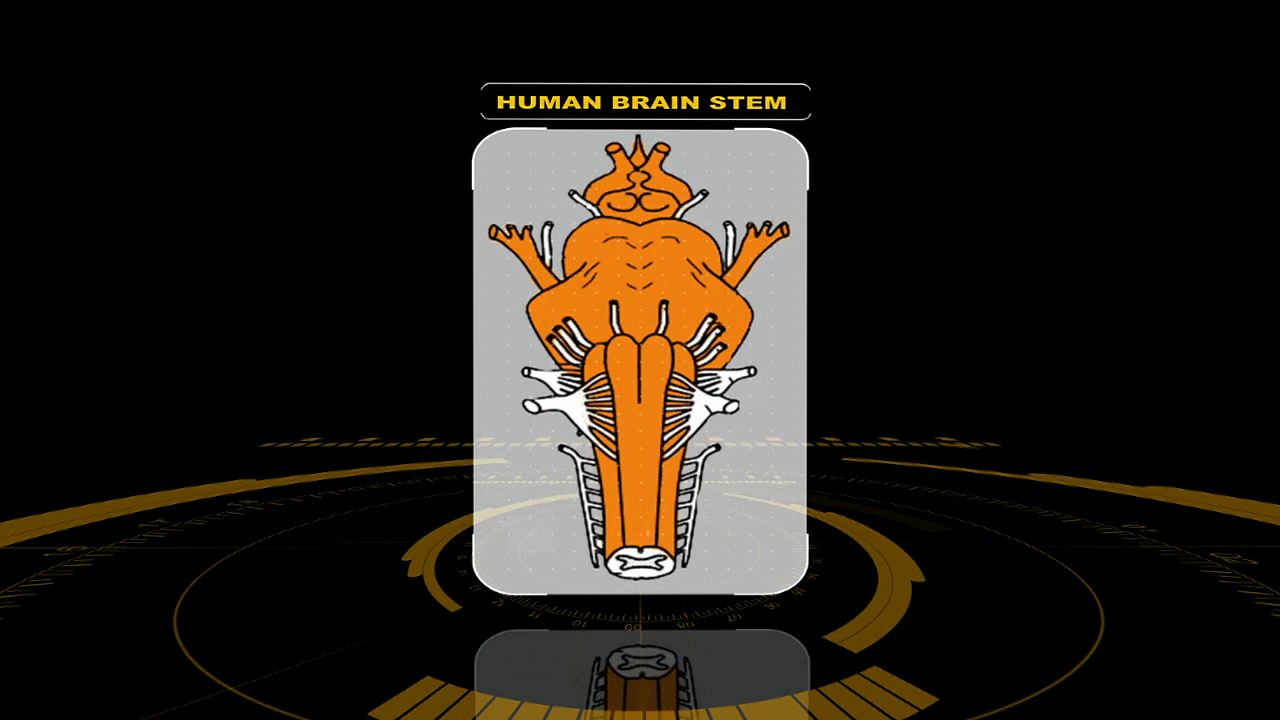
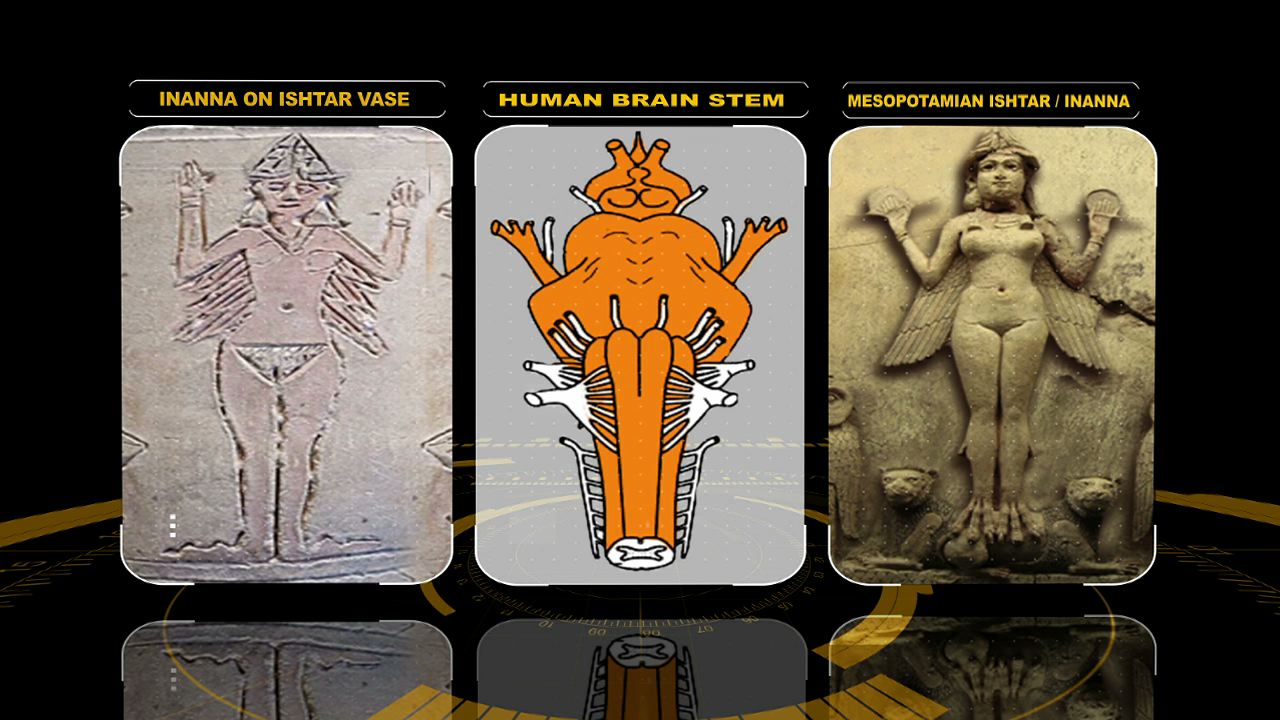
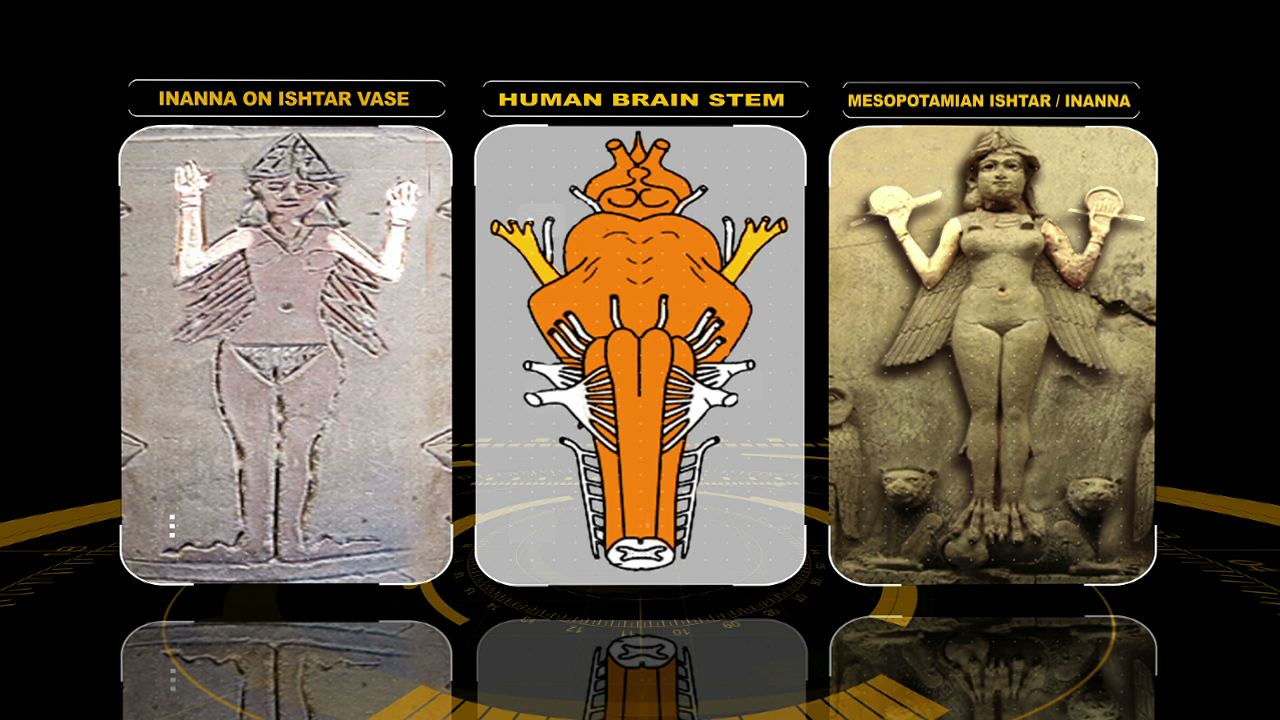
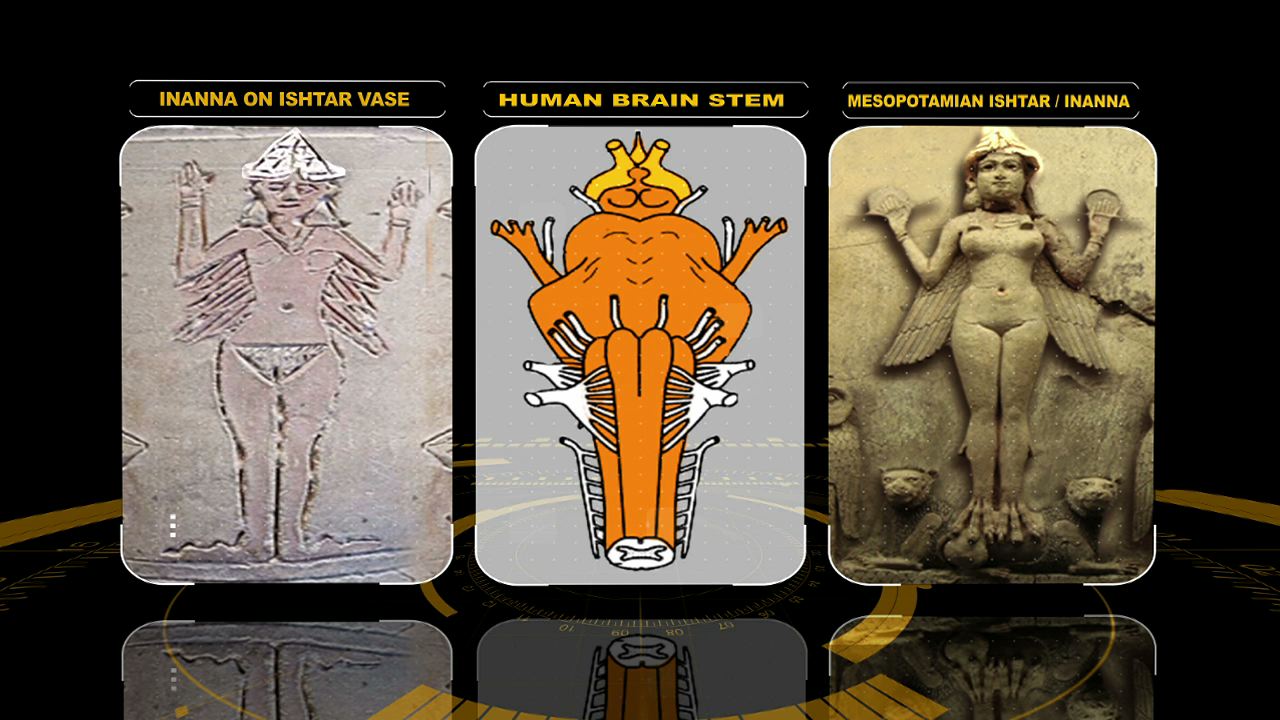
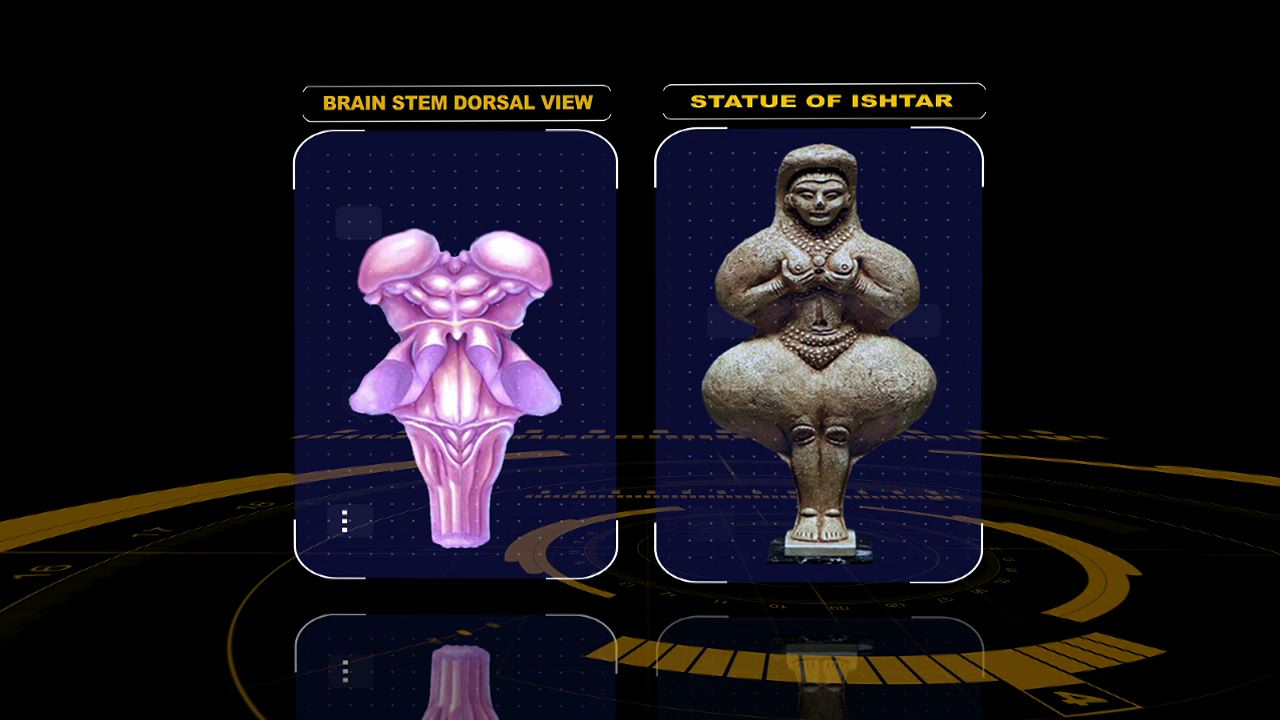
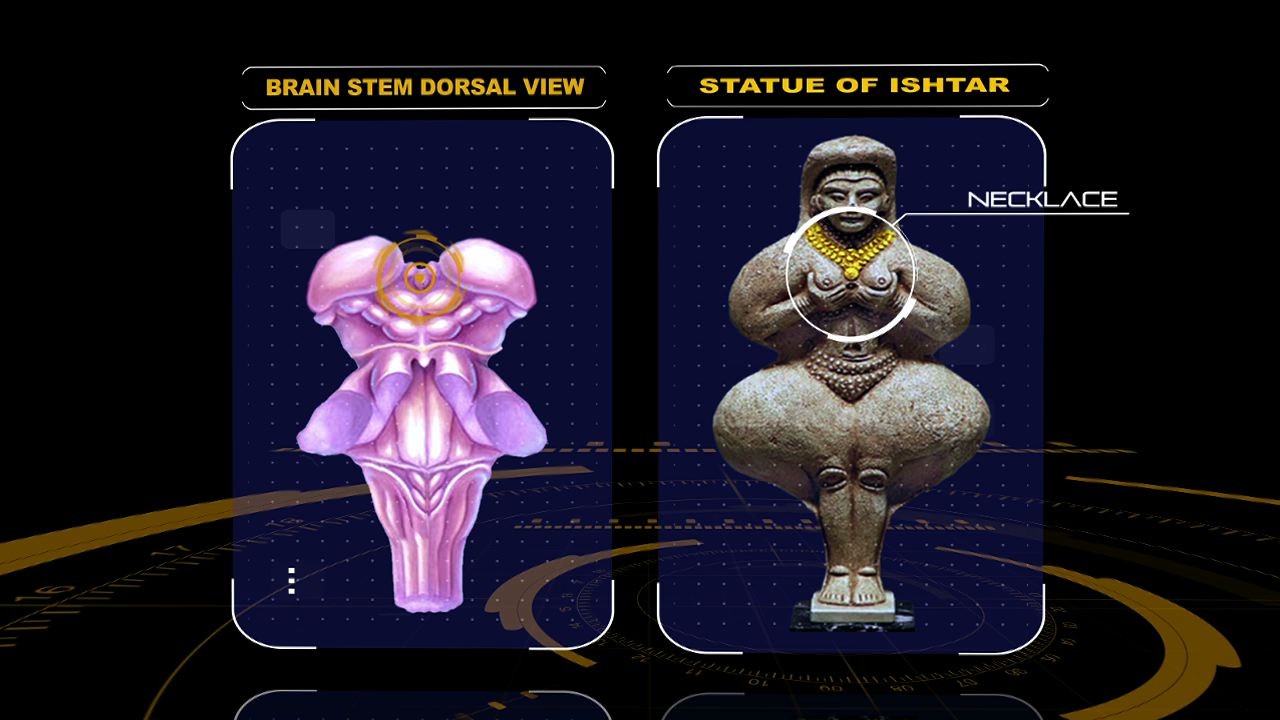
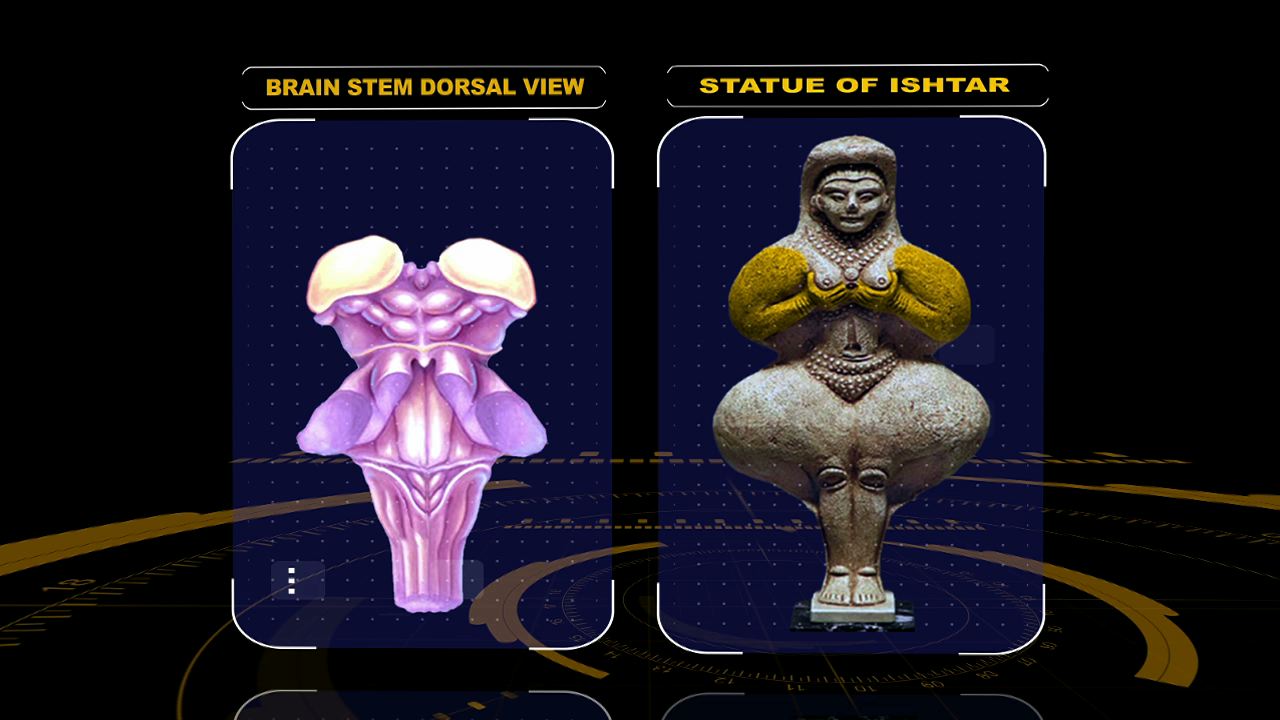
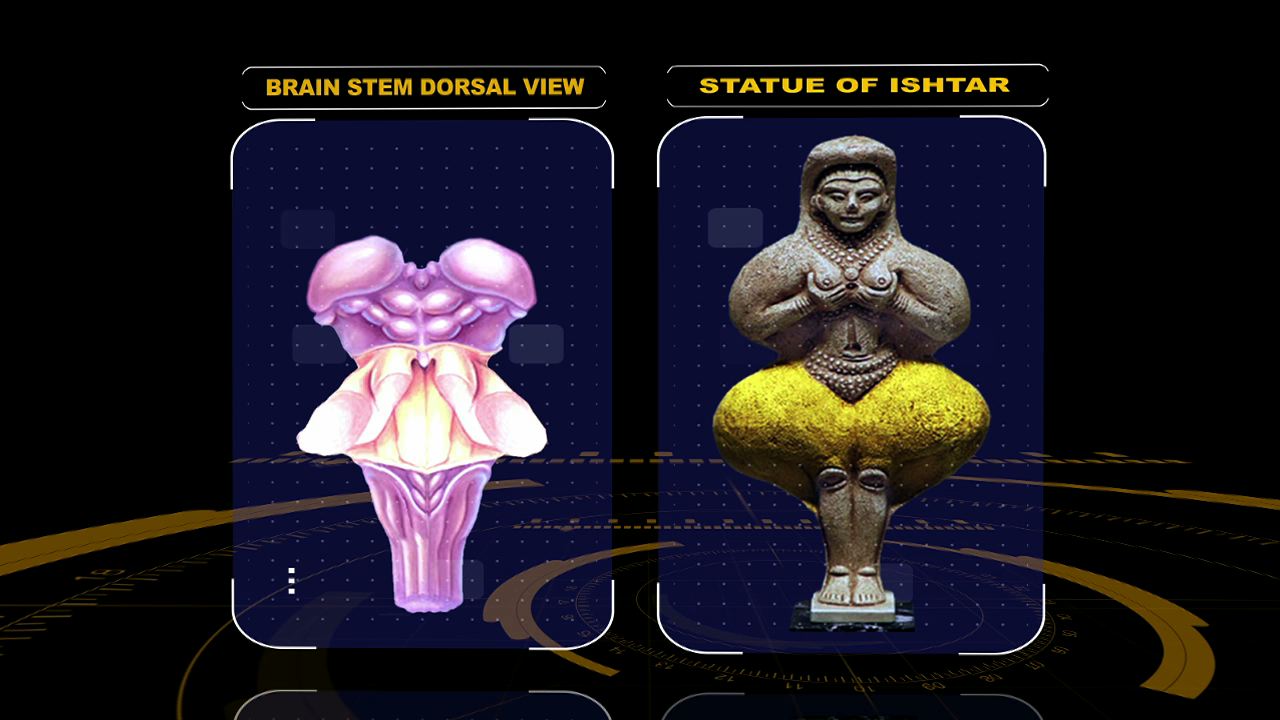

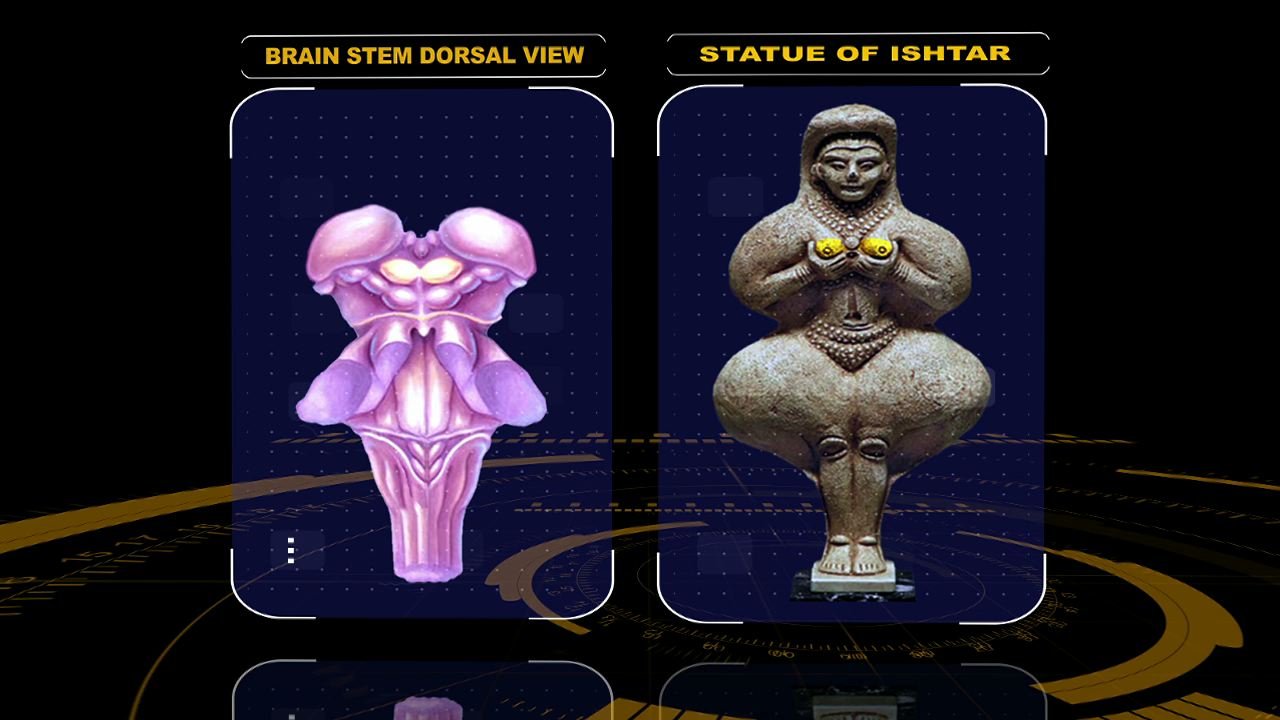
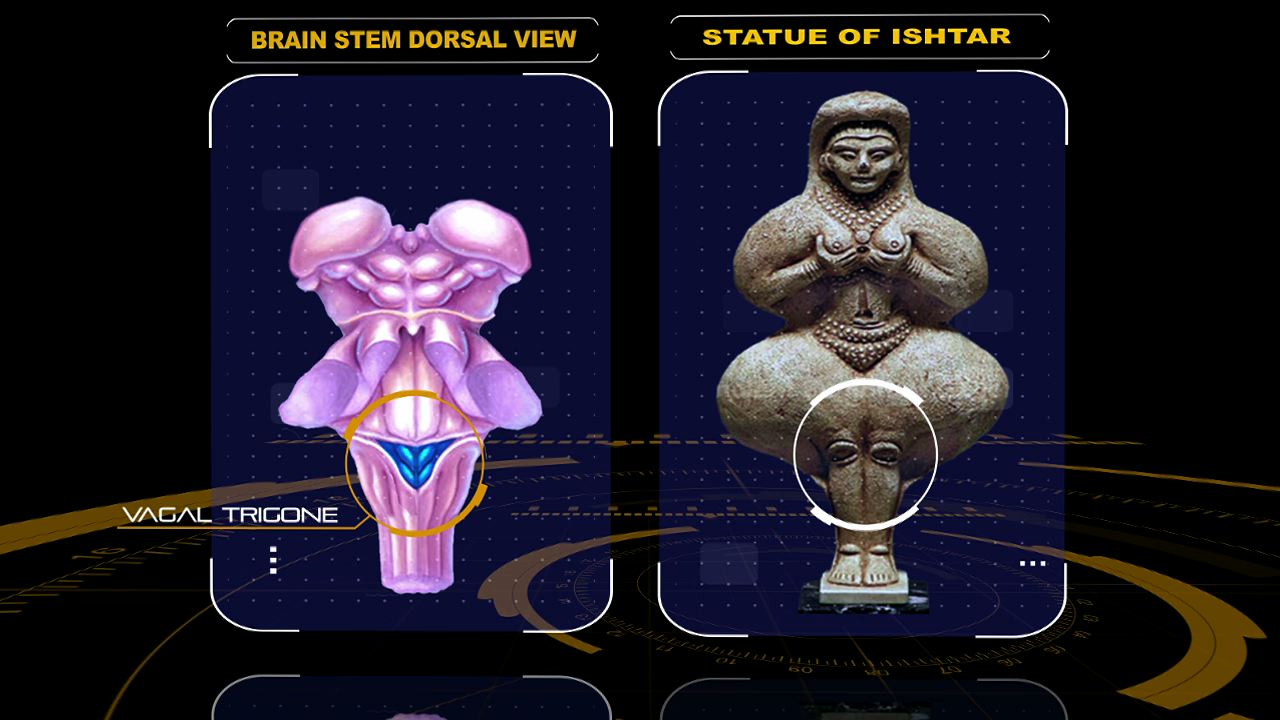
Discovery #4: The Venus of Willendorf
After tracing this visual technique of biological correspondence in ancient statuary back to Dynastic Egypt, Babylon, and Sumer, the next discovery was even more startling: The earliest example of ancient sculpture yet found is the Venus of Willendorf - a small figurine that is called a “fertility” icon. There are a number of very obvious deviations from normal human body attributes that indicate either an extremely poor understanding of anatomy and of basic sculptural techniques on the part of the ancients, or they signify something else. The same anatomical “mistakes” are repeated in versions of this statue found throughout Europe. These seemingly “mistaken” features, while deviating from a correct human form, are a remarkably close fit to another body - the brain stem and diencephalon.
Baffling features like the head with no face, and the horizontal stripes across the torso of the statue, the position and scale of the arms abound in this figurine. But while not reflective of an accurate human form, all these abnormalities correspond quite dramatically to the articulations that make up the human brain stem and thalamus. Note the correlation between the horizontal stripes across the pons and those on the torso of the Venus.
Click the slideshow below to see the correspondences or watch an excerpt from Magical Egypt episode 2:

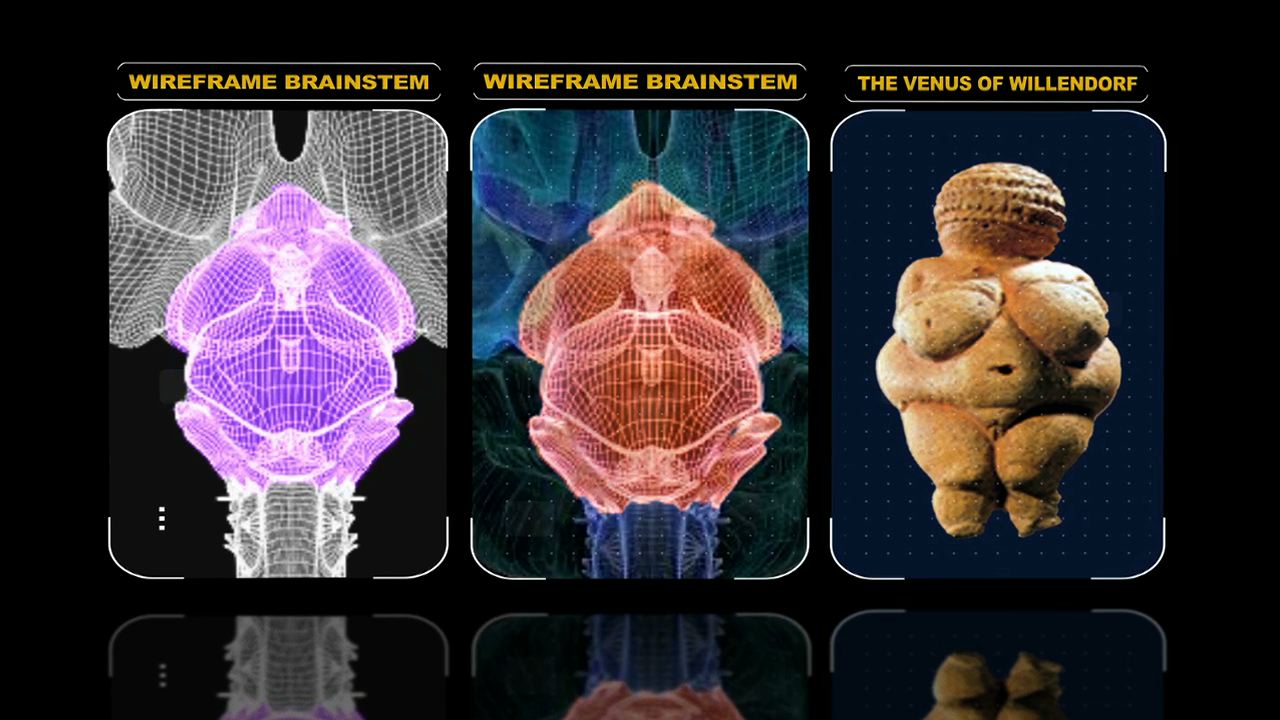

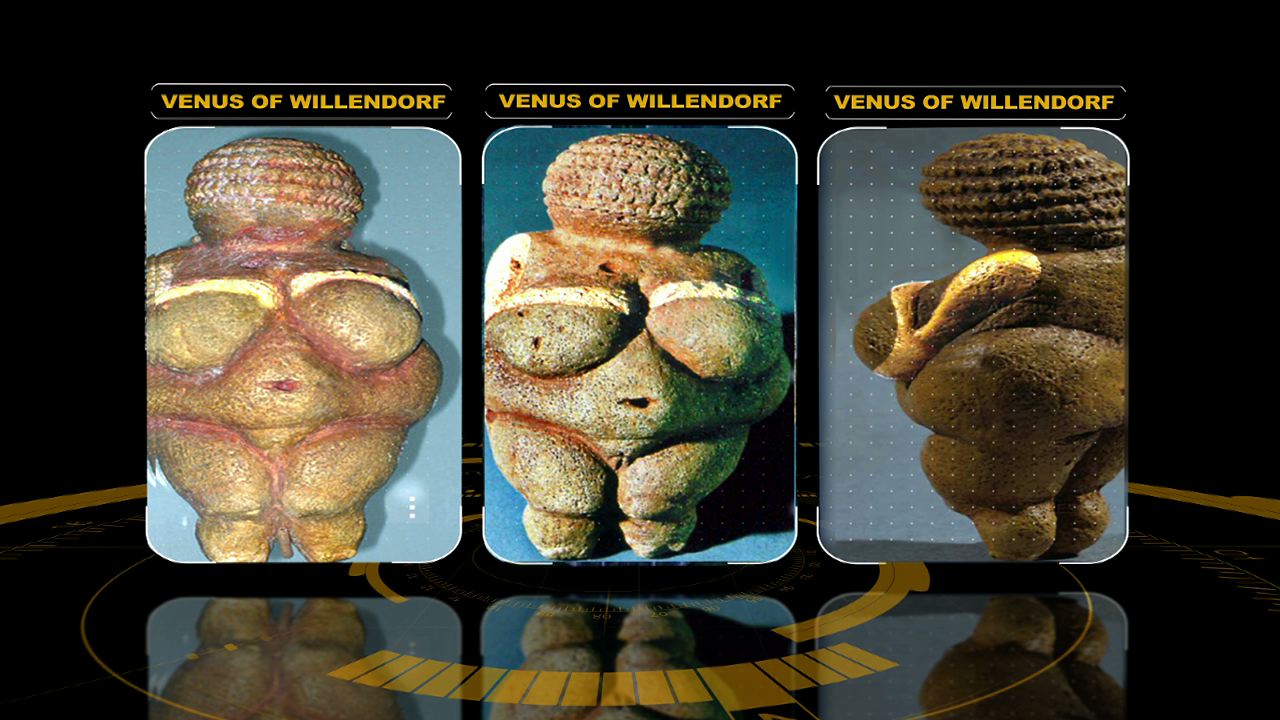
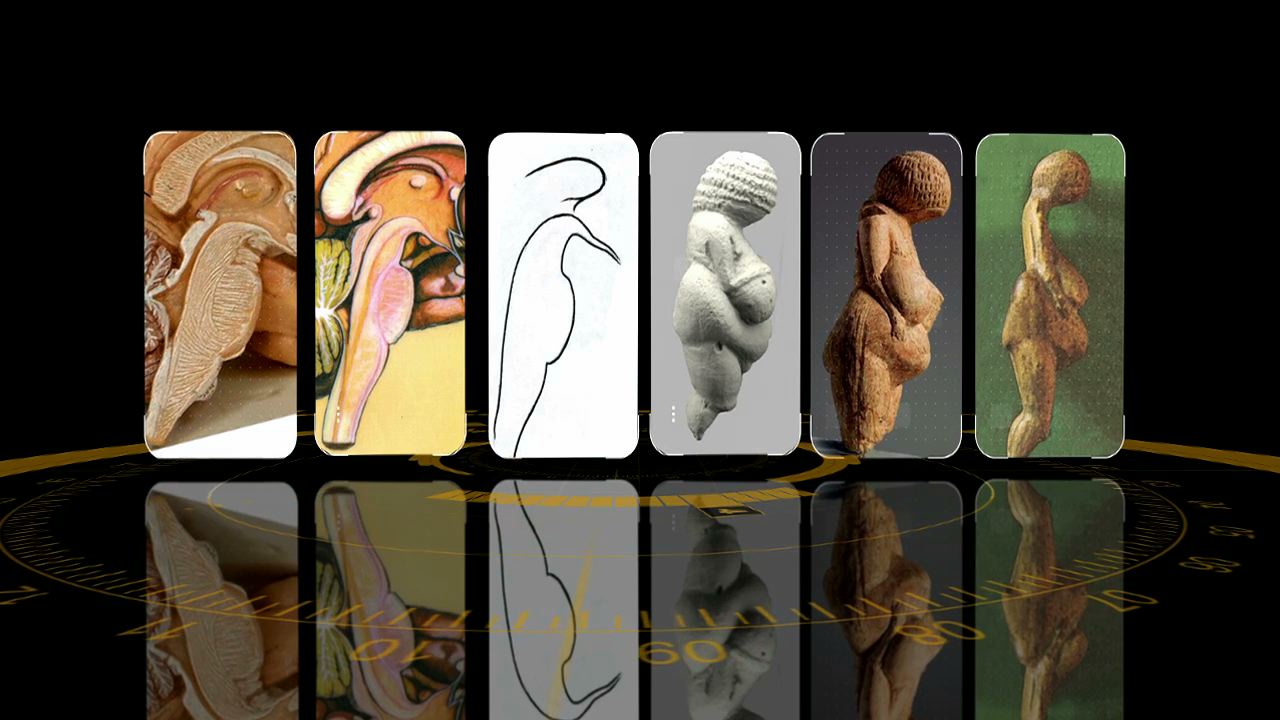
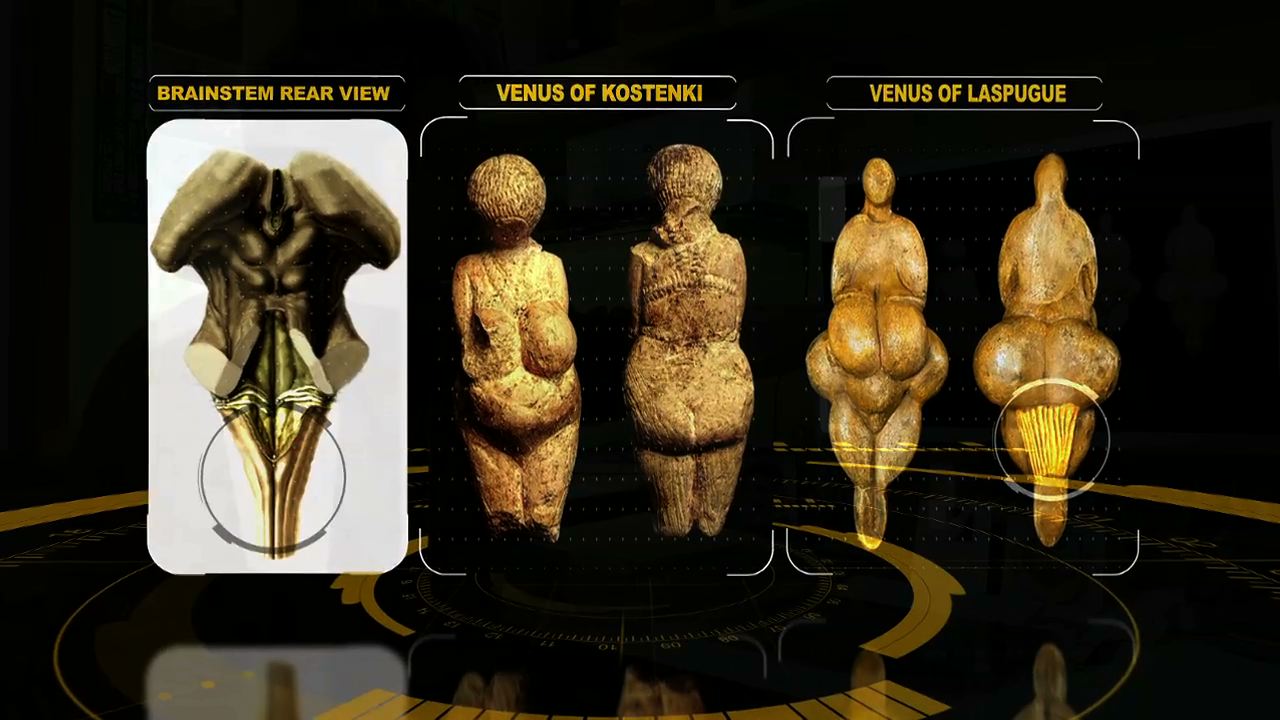

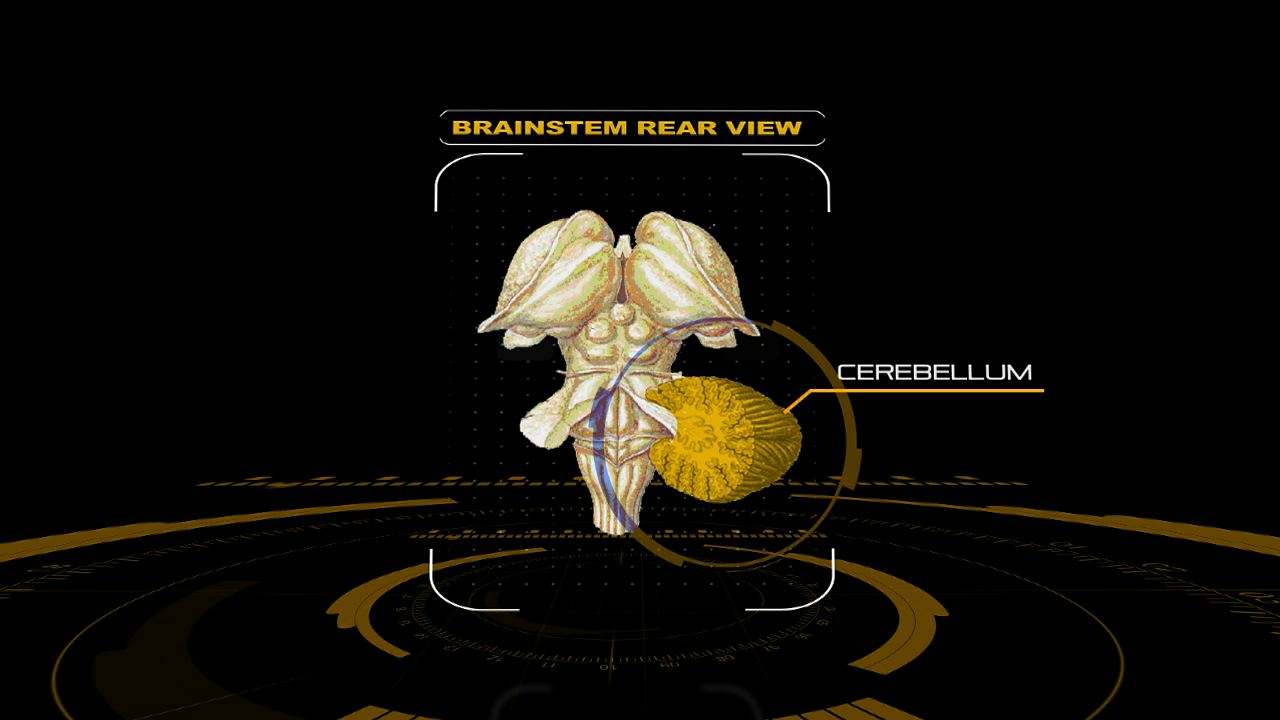
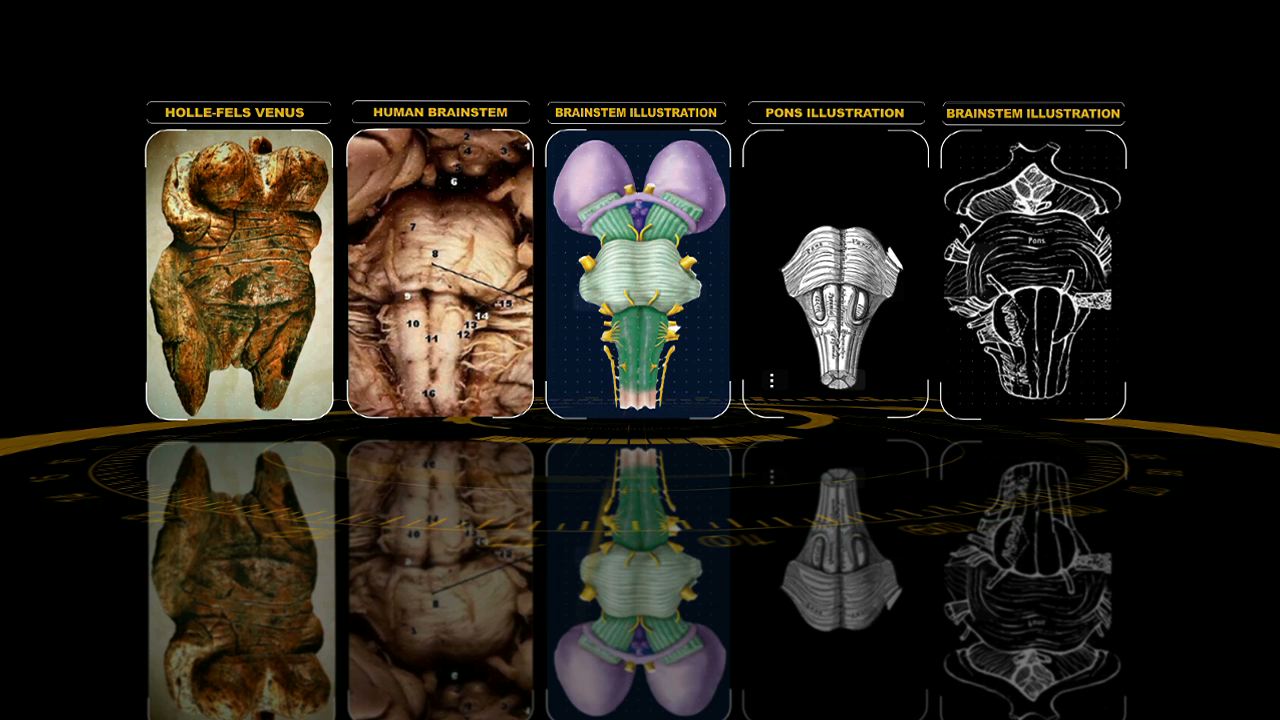
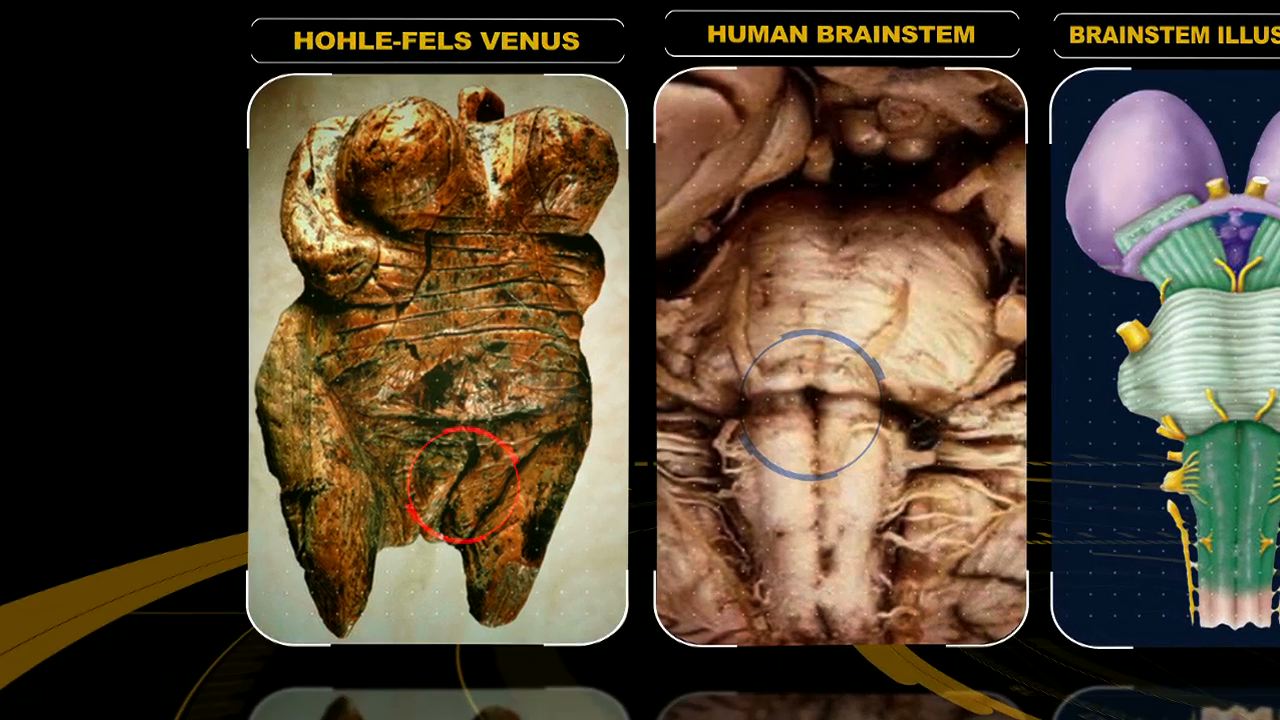
Discovery #5: Statues of mummiform Osiris conceal correspondences to brain stem
The horizontal ridges that sweep around the pons appear to be a “wrapping” of cloth, visually suggestive of the wrapping practice seen in Egyptian mummification. In light of Brad Klausen’s discovery of the ram sphinx statue correlations, the team discovered an even more iconic sacred statue that used the technique of biological correspondence to relate more information about the brain and brain stem. This time in axial view. The mummified appearance of the pons suggested another famous mummiform character in the Egyptian pantheon. The mummiform Osiris.
When these figures were directly compared to their biological counterpart, the correlations seem to be self-verifying.
Click through the images below to see the correspondences:
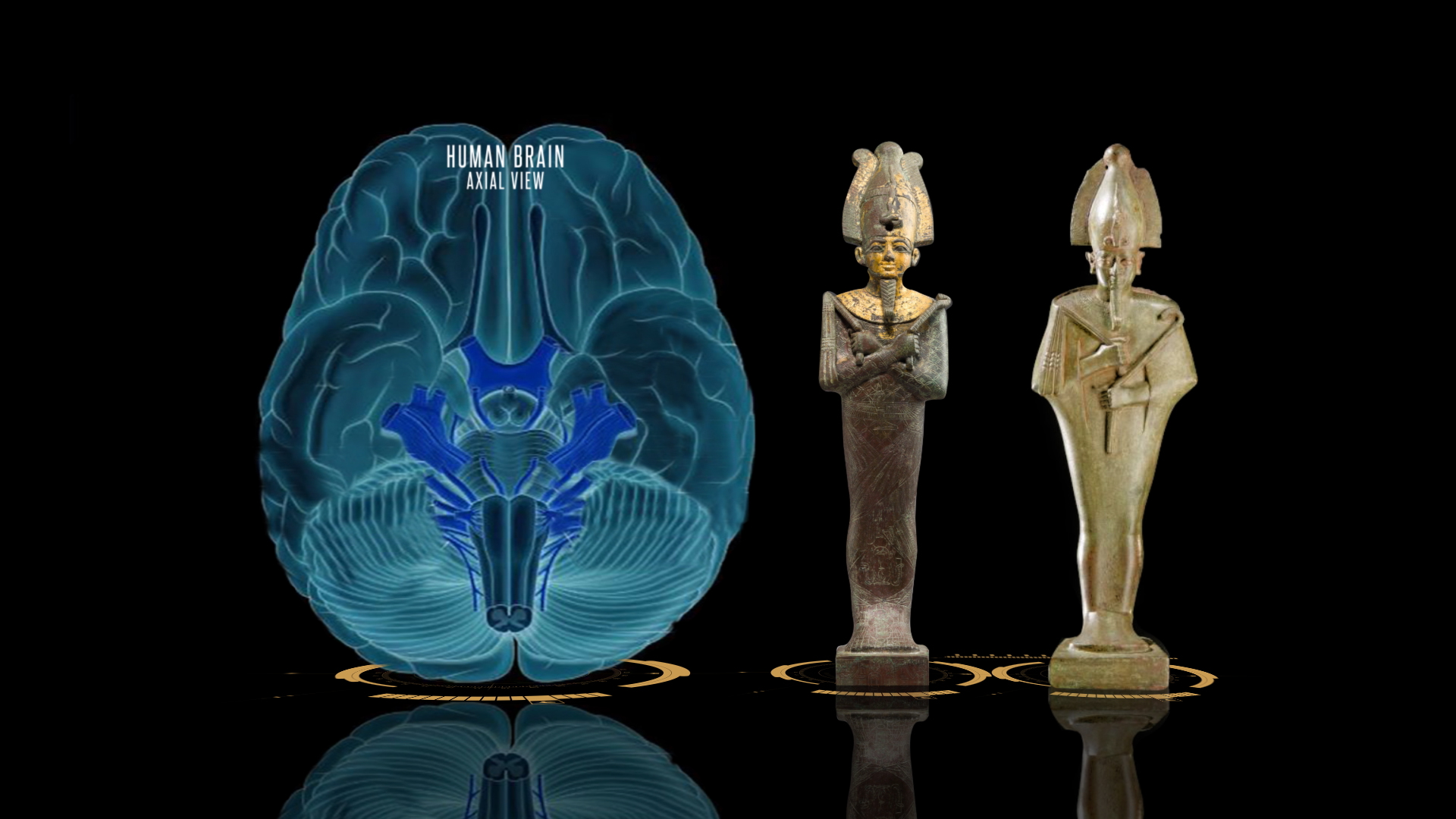
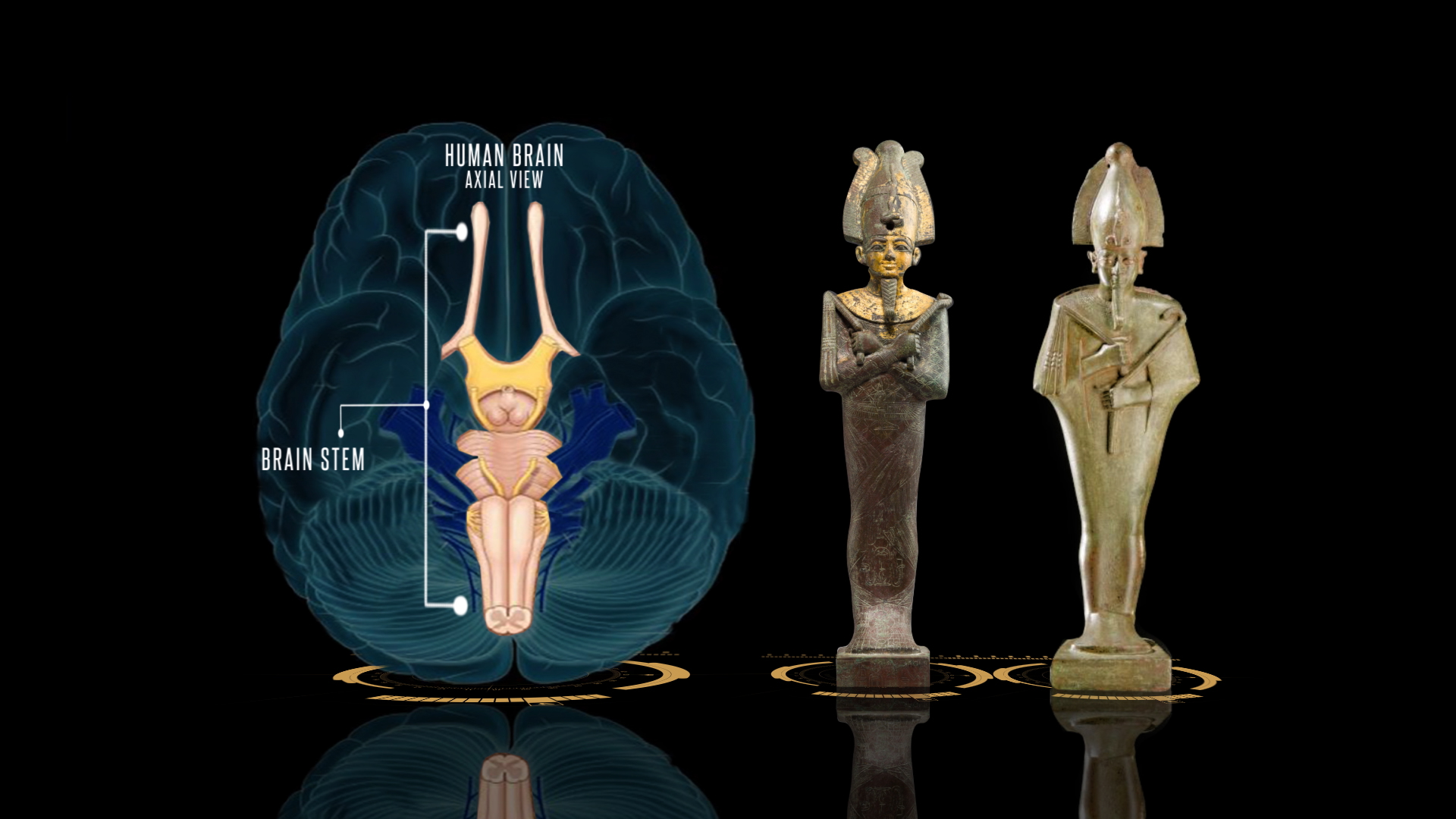
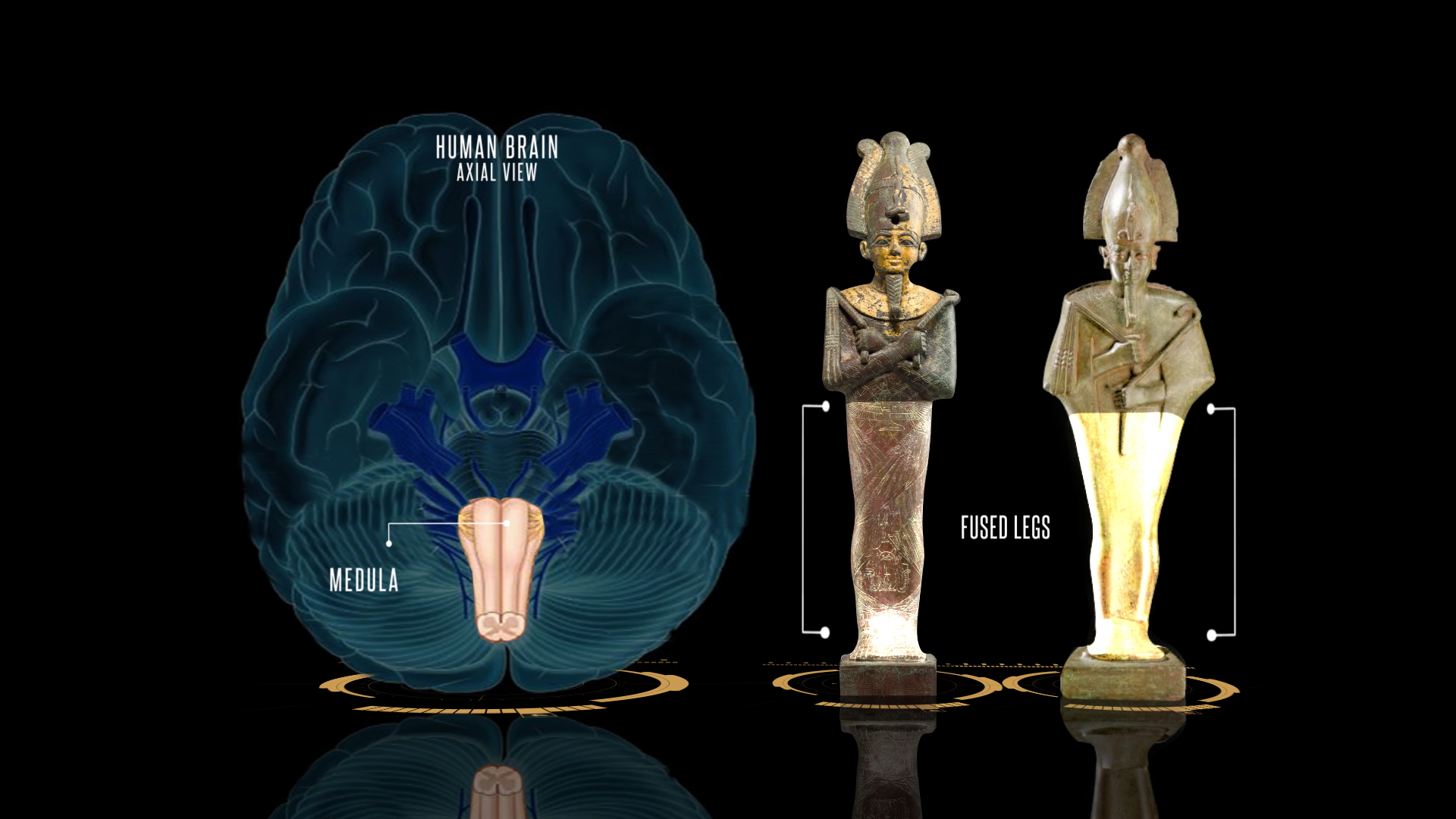

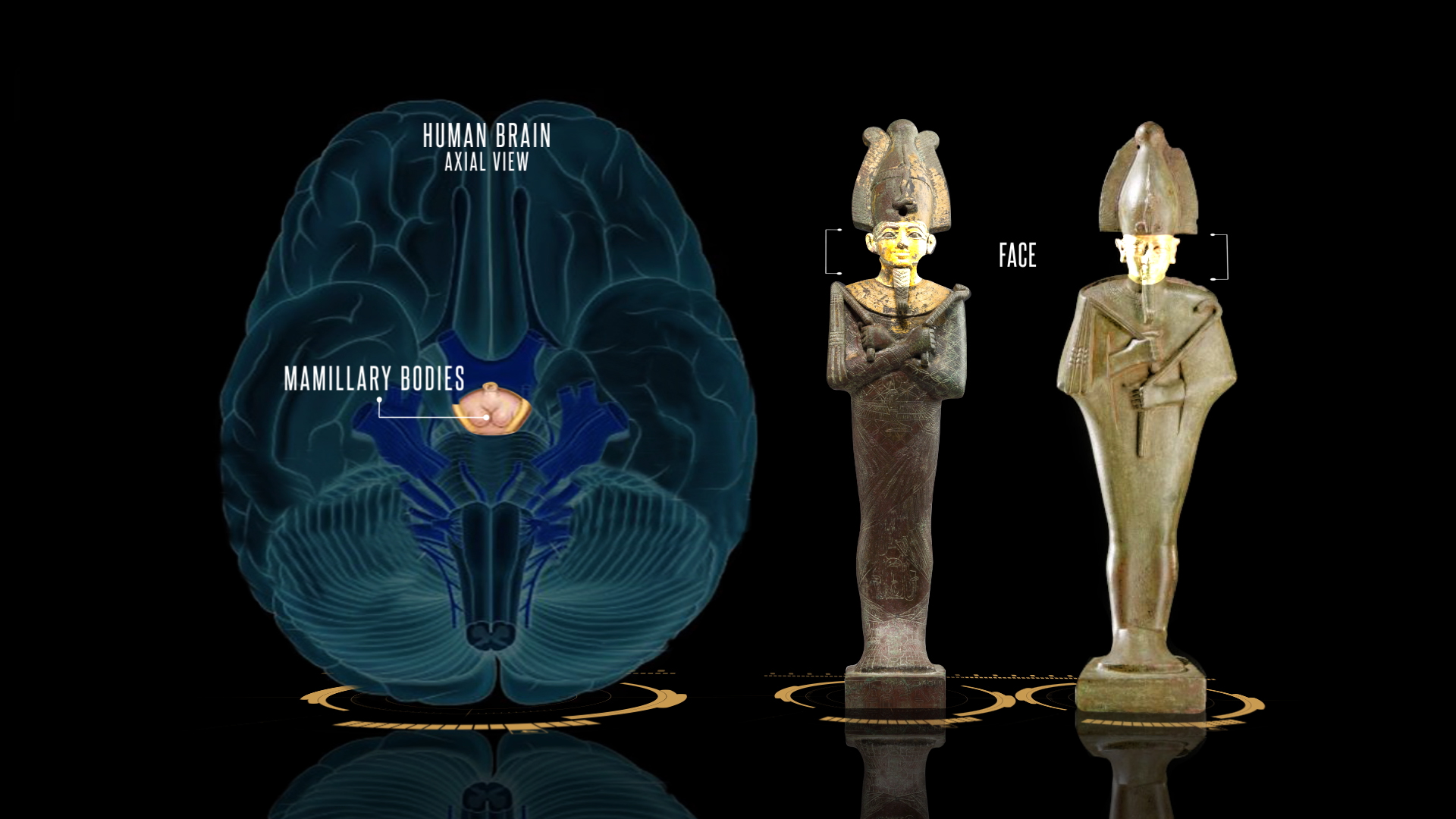
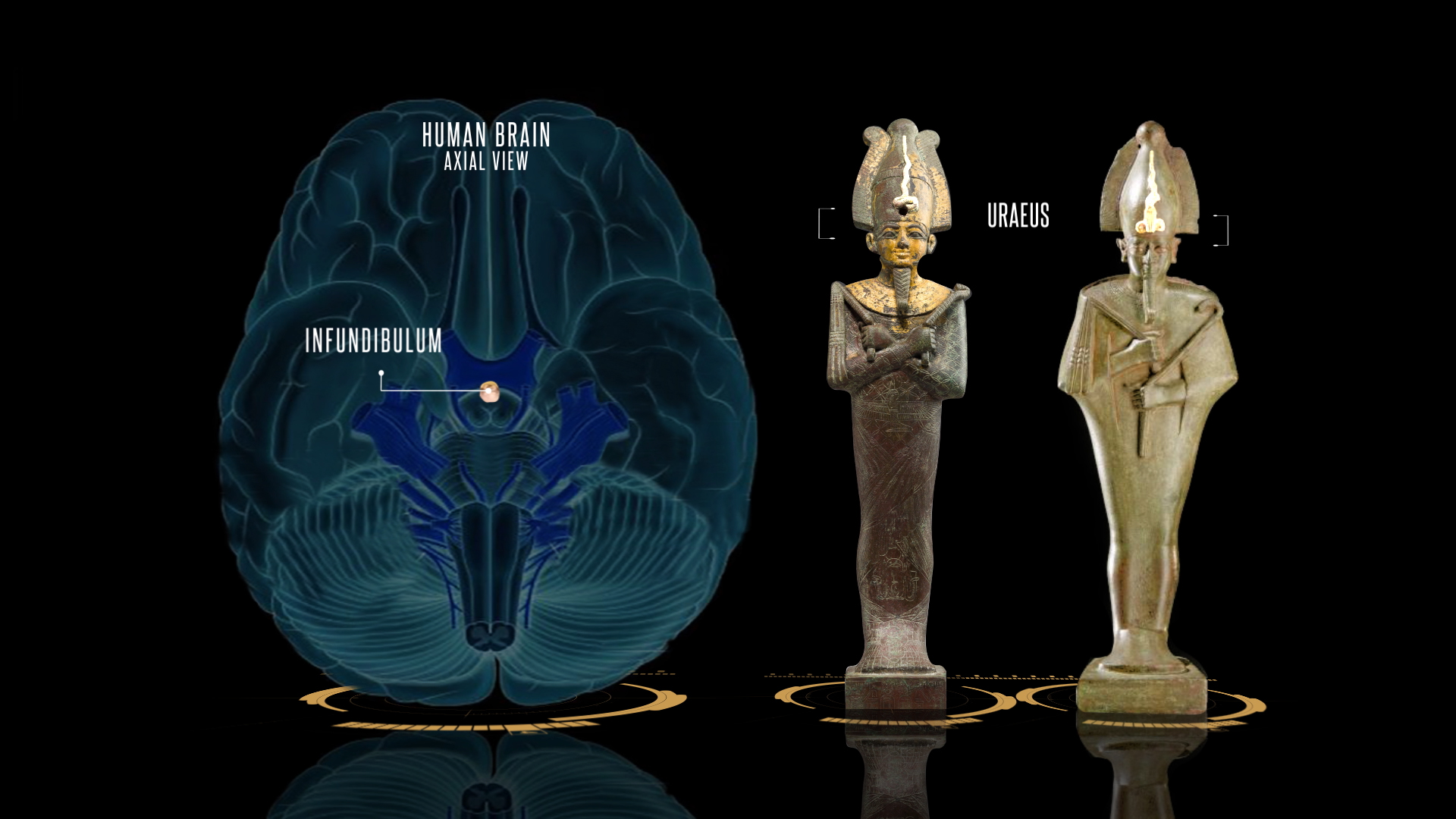

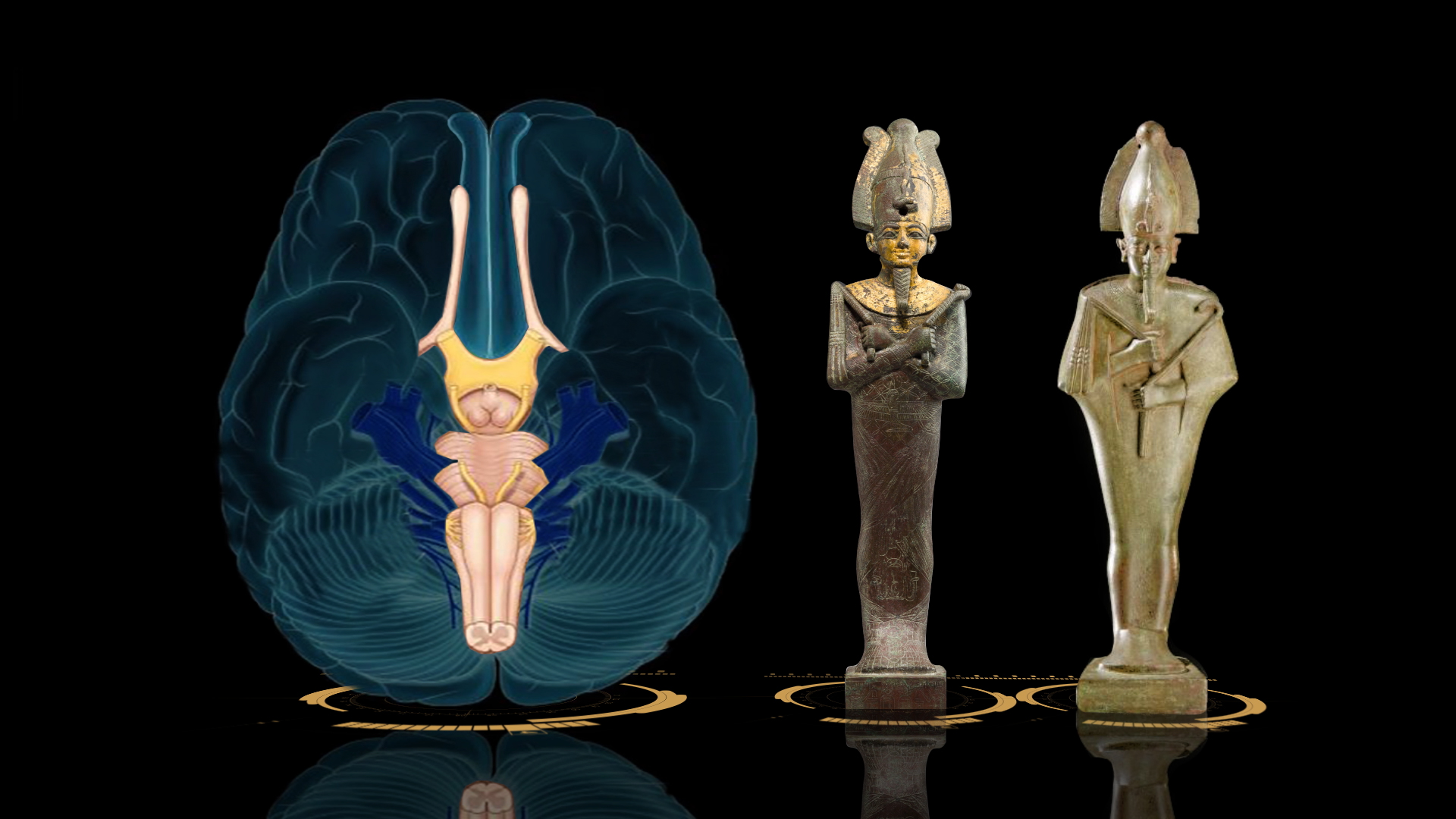
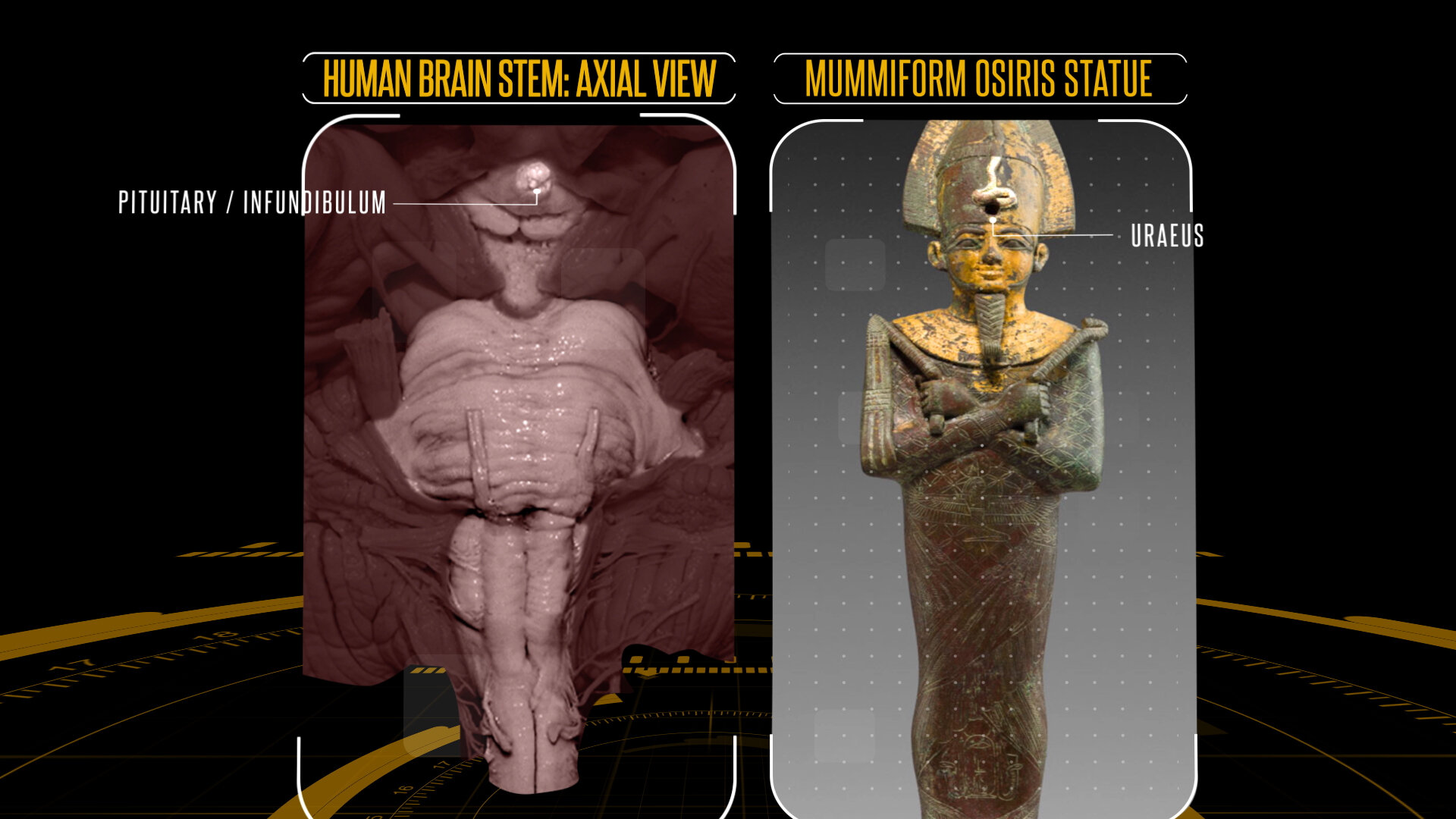

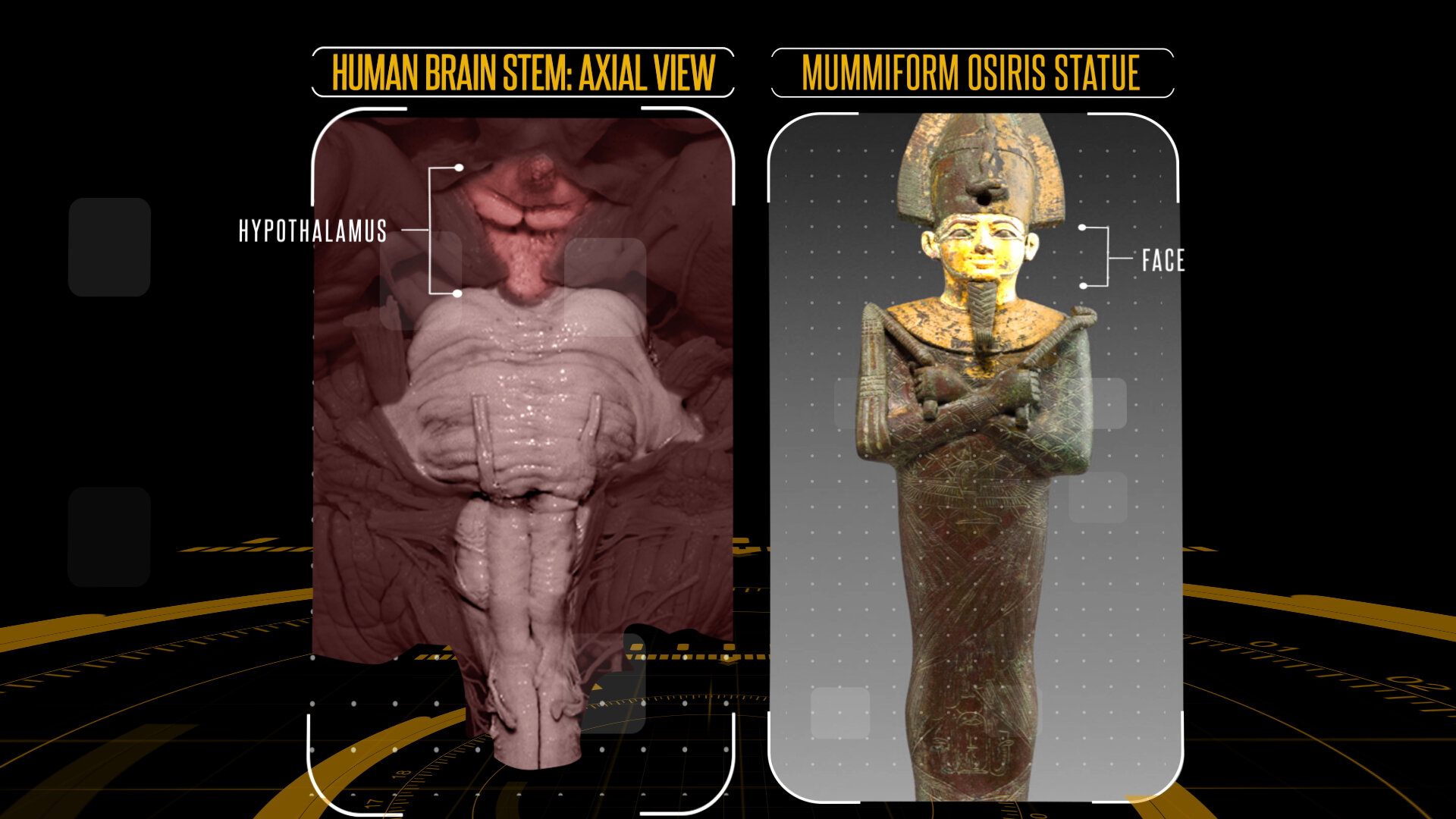
The Osiris correspondences were discovered by team researcher / show writer Chance Gardner, while studying the correspondences revealed in the ram sphinx terminals. The Osiris figurines show the same articulations, including the shape of the torso matching the shape of the pons, the unified legs that correspond to the medulla oblongata, and the many visual correspondences between the atef crown and the area described by the top of the brain stem and extension of the olfactory nerves, outlining the ventricles. Figurines of the god Osiris show the arms drawn up to create the shape of the pons. Note the correspondence between the face and the area above the pons where the mammillary glands are located. Also, note the exact correspondence between the placing of the uraeus and the location of the infundibulum. This correspondence was also present in the Ram Sphinx statuary.
Once again, there is a layer of mythos that may hold some information about the function of the areas modelled. Curiously, the brain stem, thalamus, and pineal gland are all active during REM and dreaming states, symbolically associating them with the “underworld” of sleep and dream states. The association of Osiris with the underworld and the afterlife might indicate that important information about the brainstem’s role in the dream state has been encrypted into the Osiris mythos.
Discovery #6: Diencephalon and Amygdala schematics hidden in sacred symbolic art
The next series of correspondences that came to light was discovered by researcher/author Gary Osborn. The visual technique is the same, but in this case, represents a view of the brain from the axial view, ie. underneath, looking up. At this cross-sectional view of the human brain, we can see the diencephalon, hippocampus, amygdala, corpus callosum, pineal and pituitary glands and the lobes of the thalamus, each creating a very distinctive complex of outlines. This is the mechanism that connects the brainstem and the hemispheres, as well as the conjunction point of the nervous and circulatory systems and the ventricles. This distinctive complex of discreet recognisable shapes is seen mimicked in the ceremonial motifs of the Atef crown and in the stylised Atef crown worn by the God Khnum. The point for point correspondences make it difficult to attribute to imagination or confirmation bias. As either motif could be used as a totally functional reference model for this centrally important area of the brain, and these components that all contribute critically to the experience of consciousness.
The brain schematic depicted in ceremonial Atef crown motifs was first discovered by Gary Osborn. Read more about Gary’s groundbreaking research at http://garyosborn.moonfruit.com/eye-of-horus/4573273634
Click below for a slide show of the correspondences, or to view an excerpt from Magical Egypt series 2:


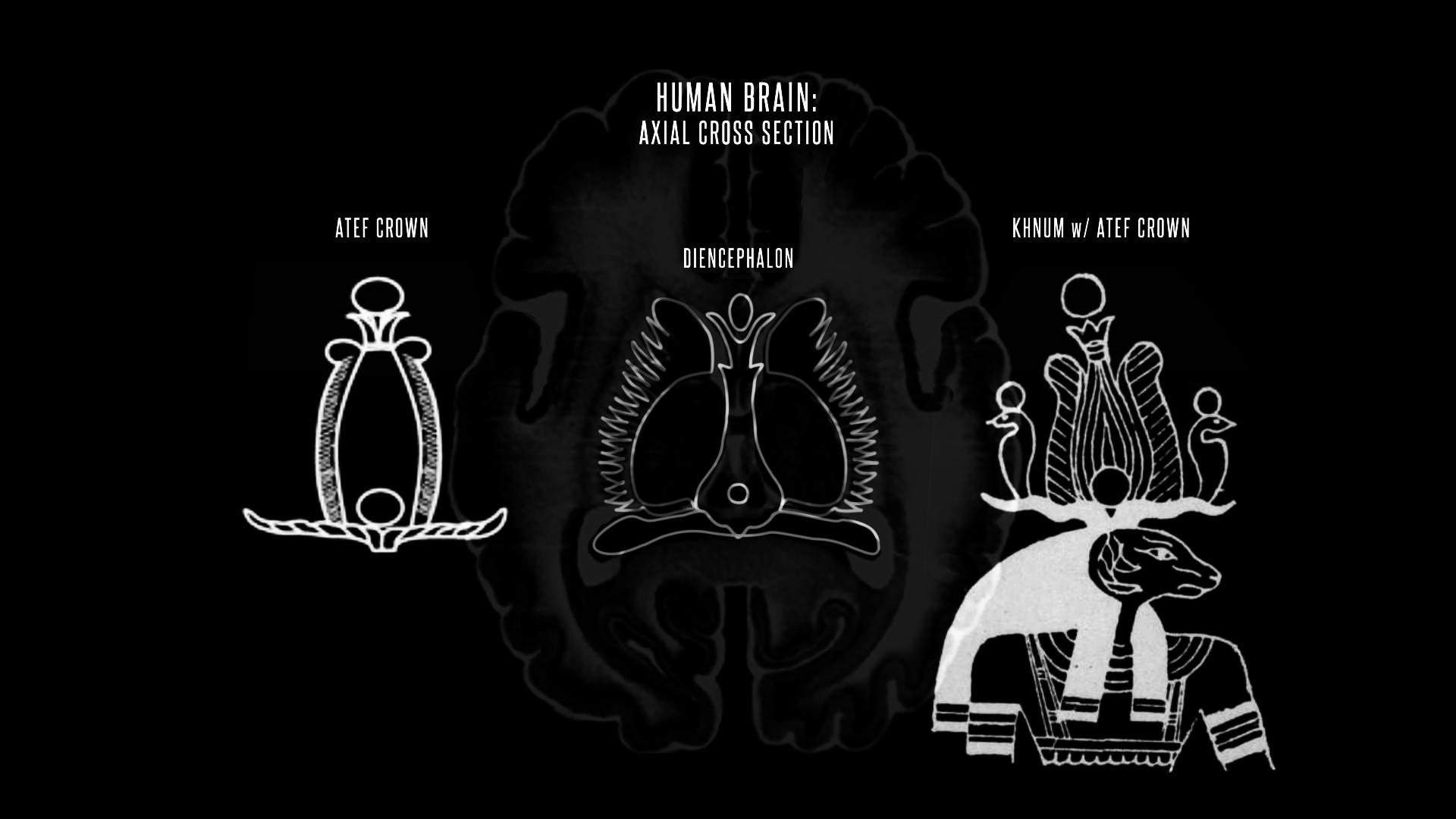
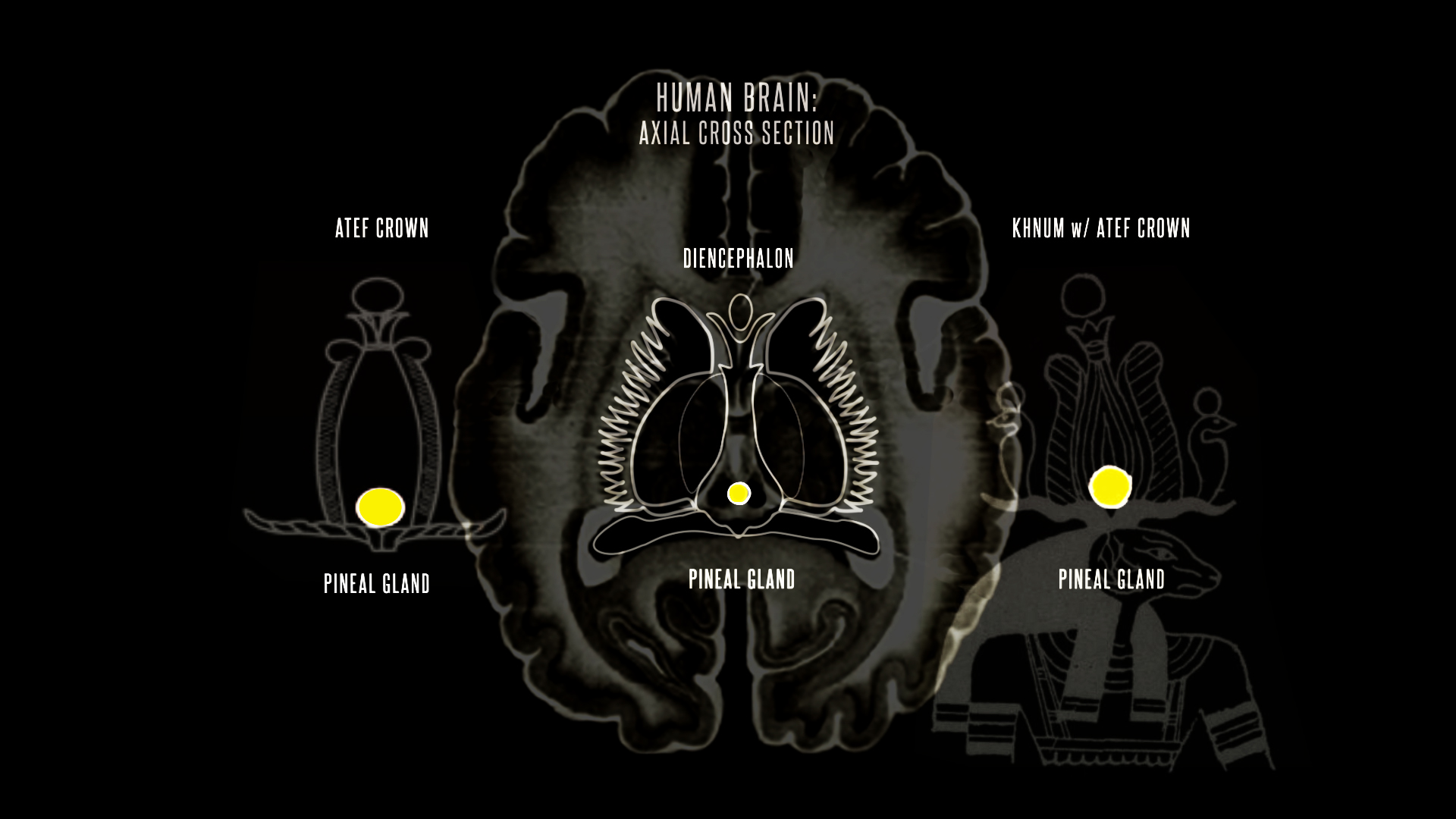
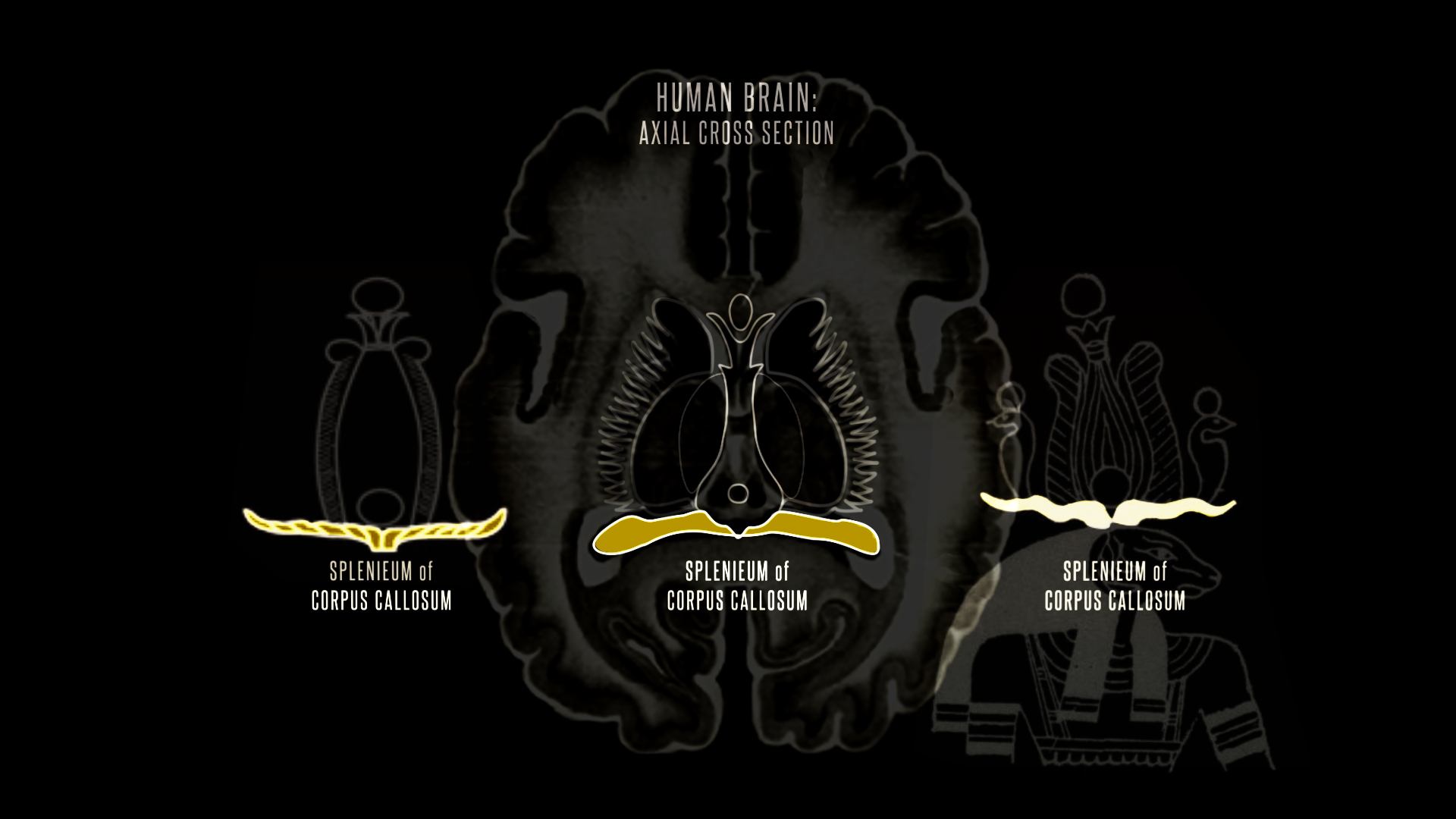
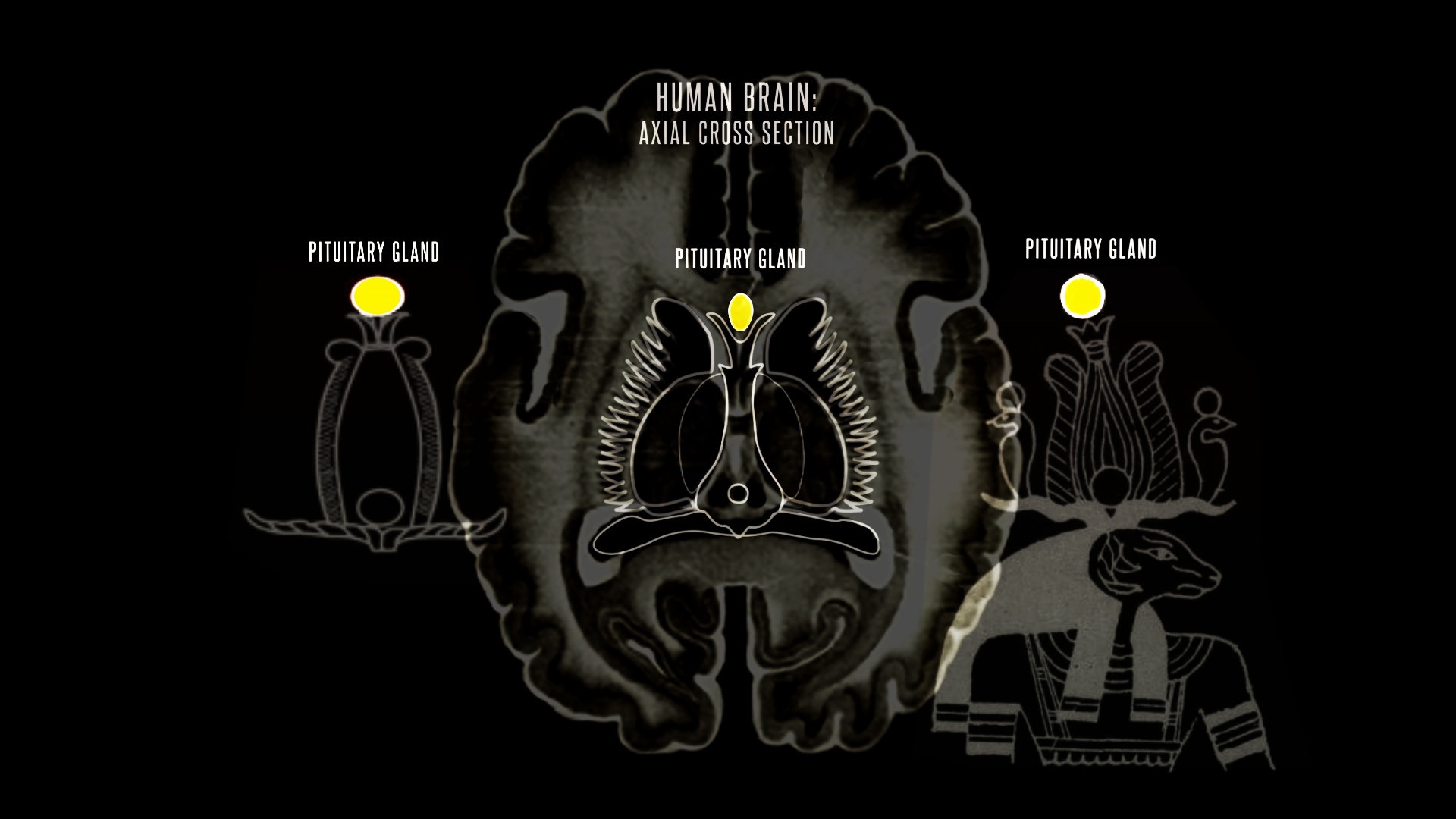
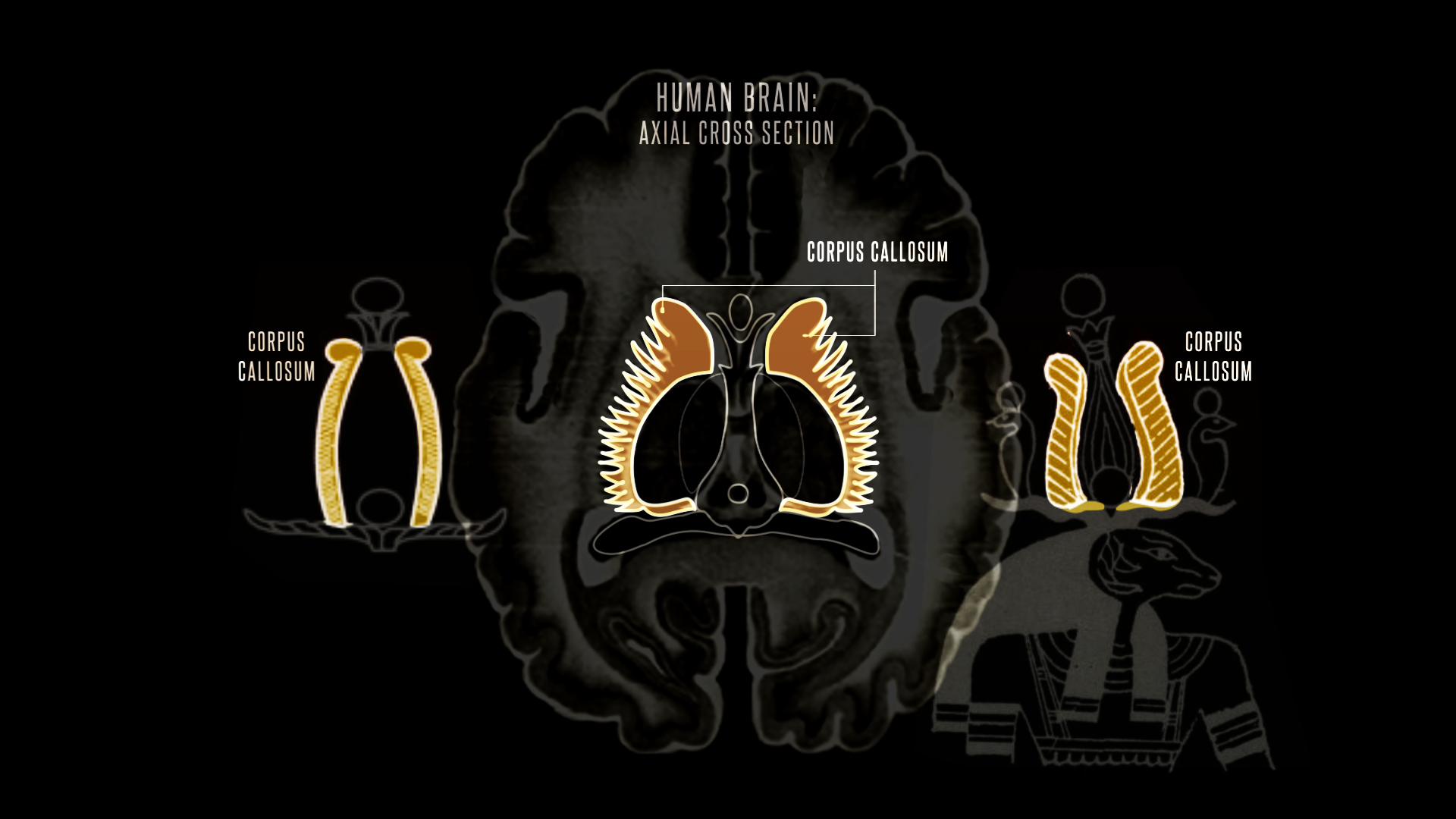
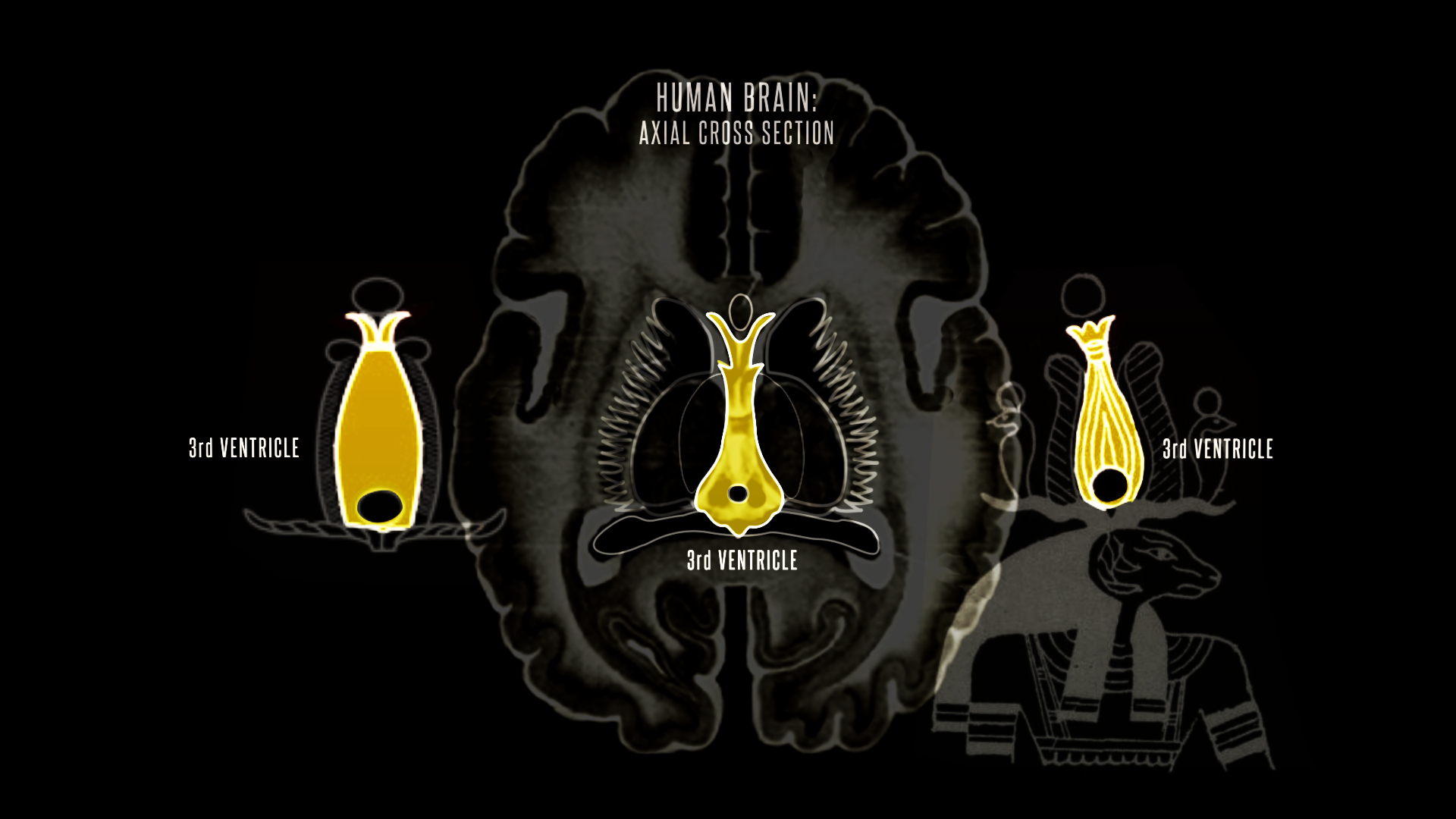
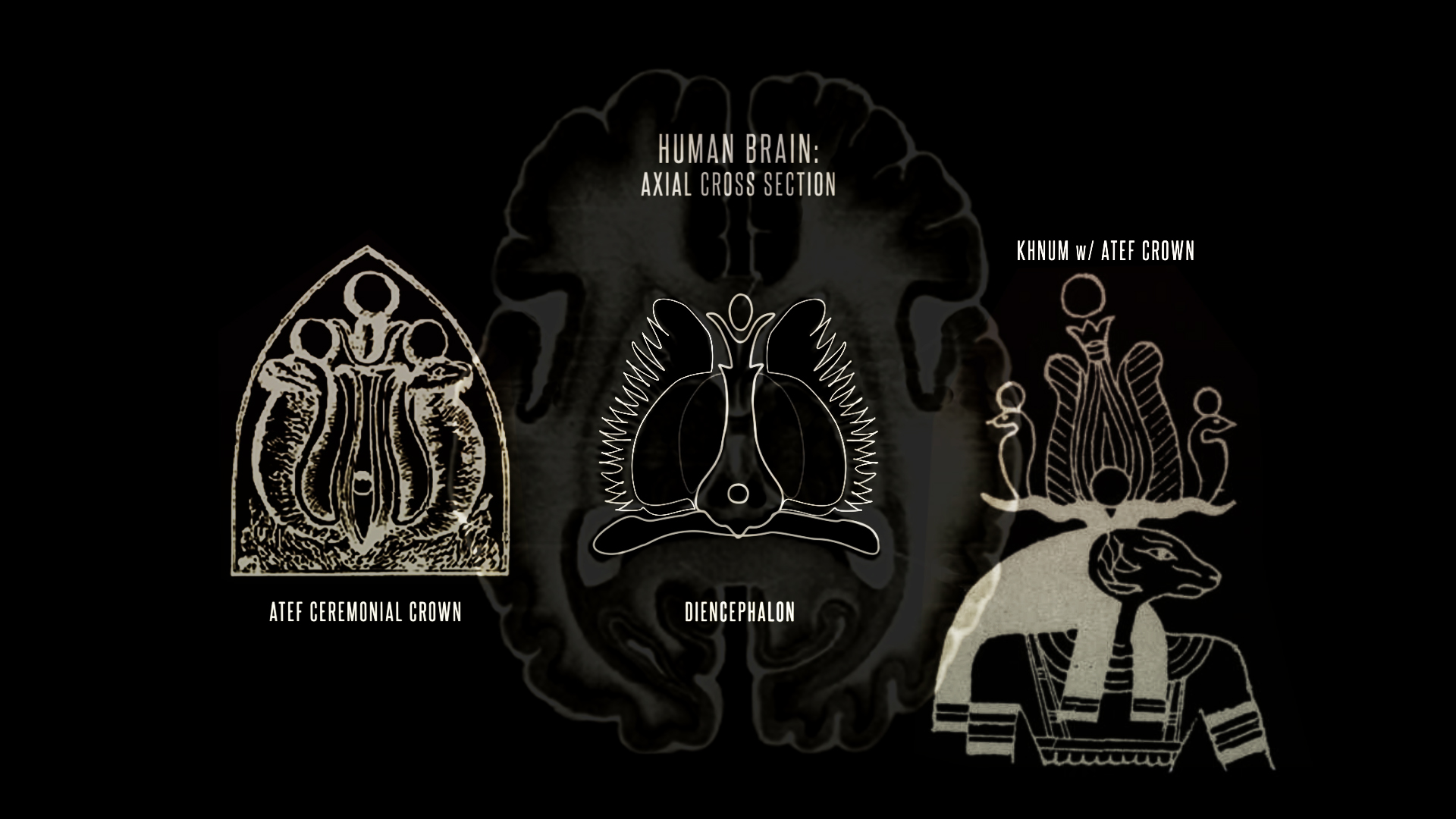
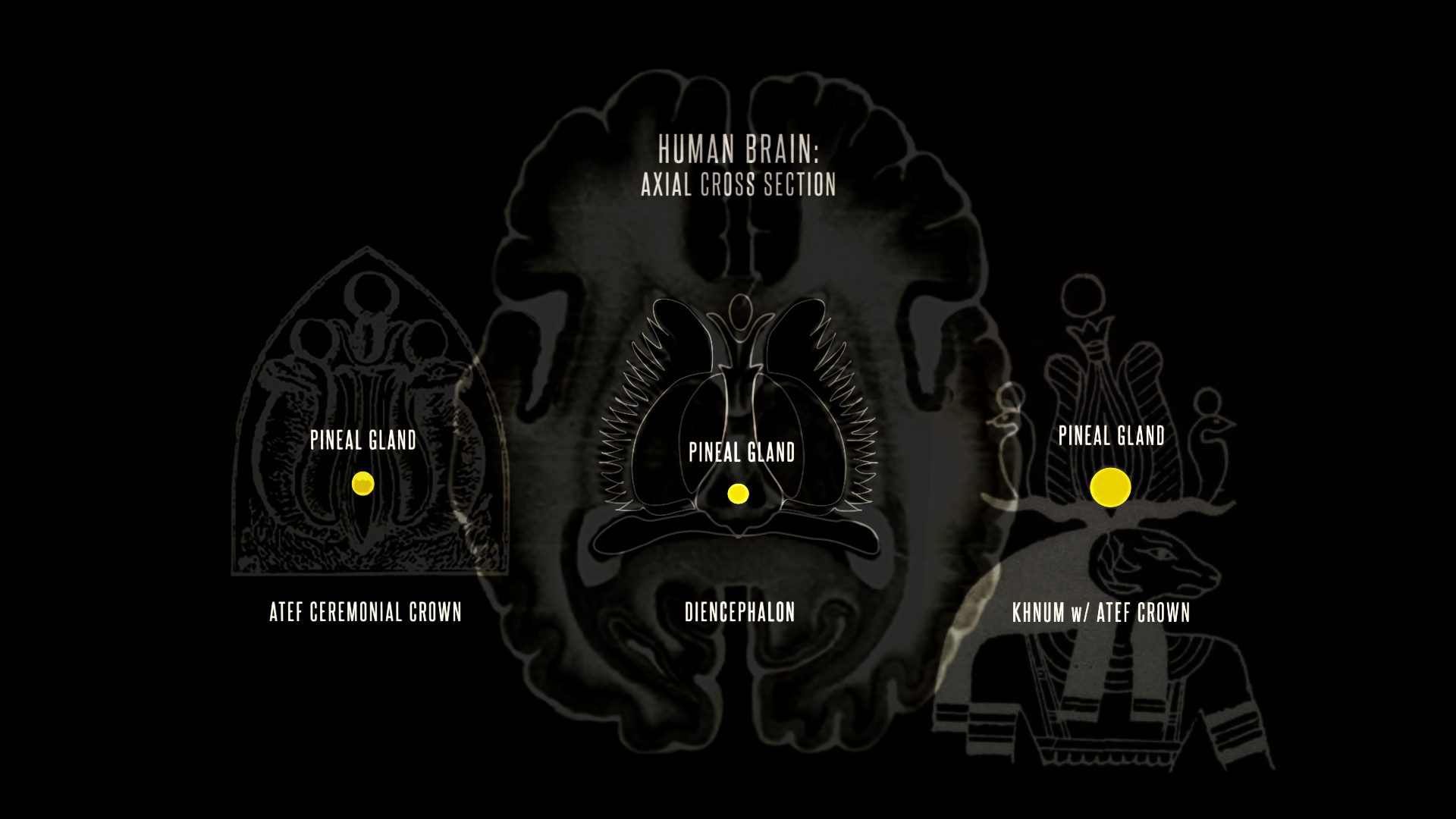
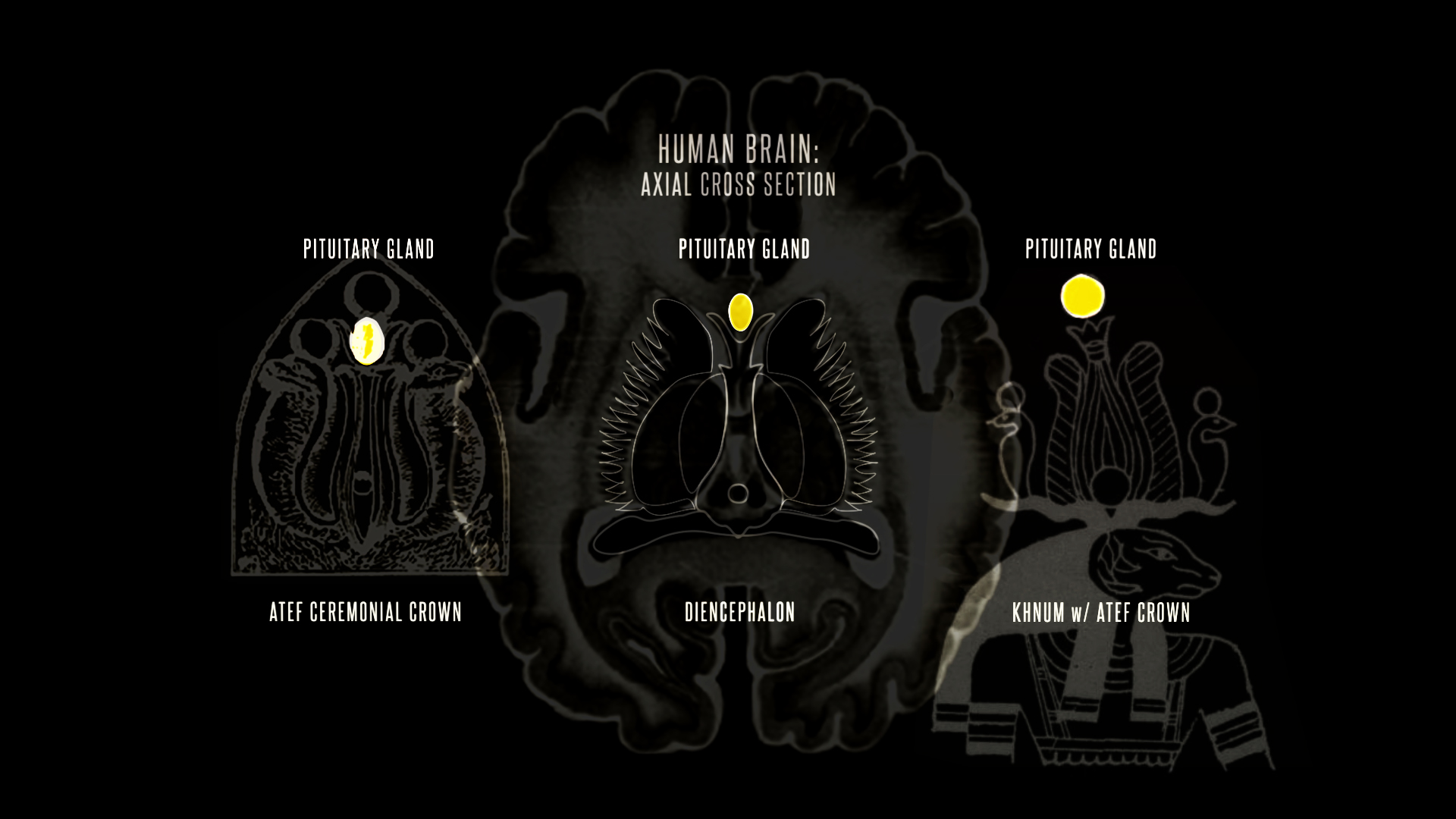


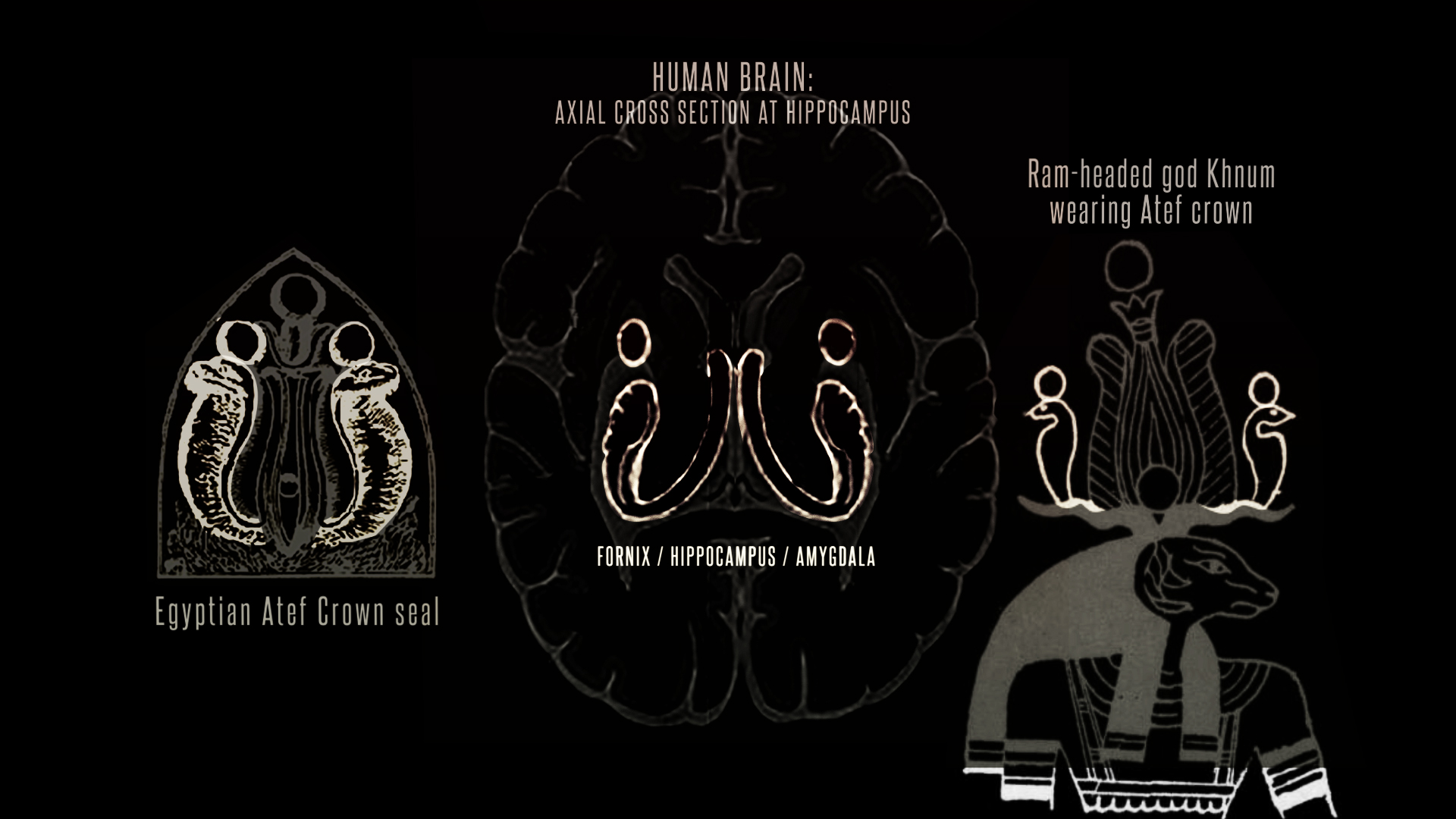
Discovery #7: Brain Schematics in 3D hidden in classic Egyptian temple pylon architecture
Another example of encrypted biological schematics hidden in the aesthetic canons of ancient Egypt. The classic Egyptian temple pylon was itself revealed to be another ingenious schematic that depicts the brain structures central to consciousness. In this case, the view of the brain is the “coronal” or front view.
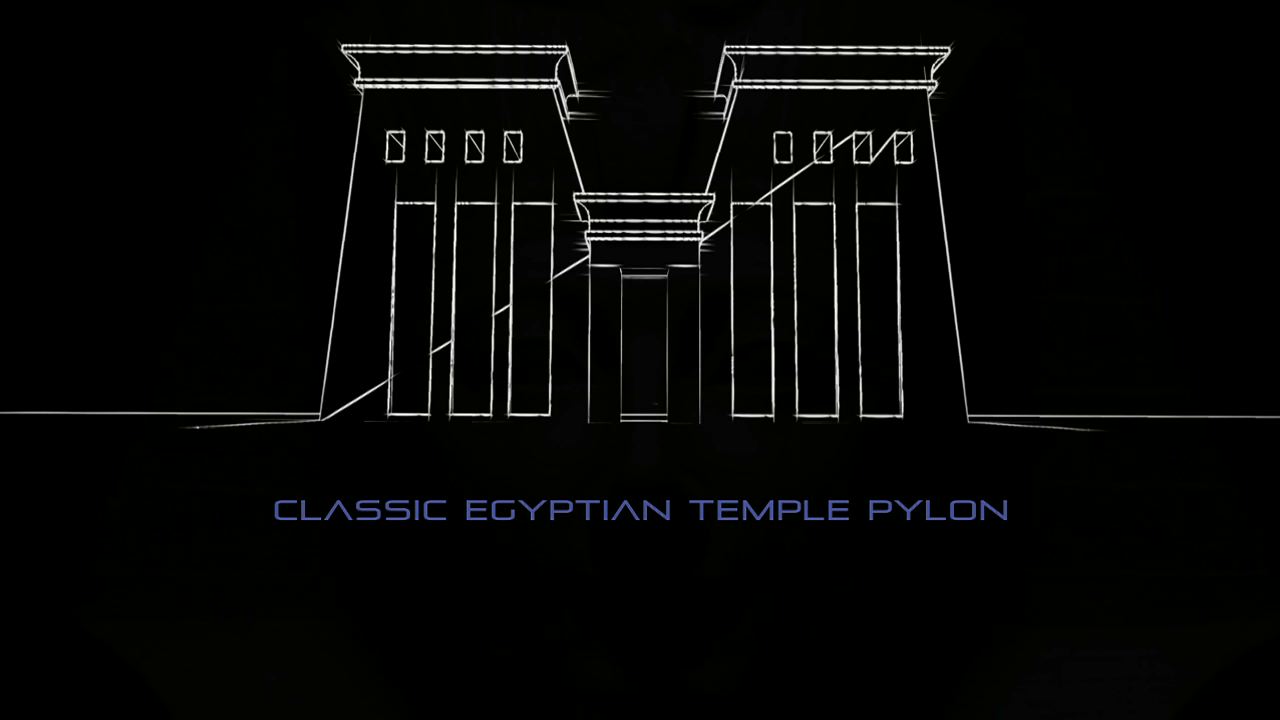

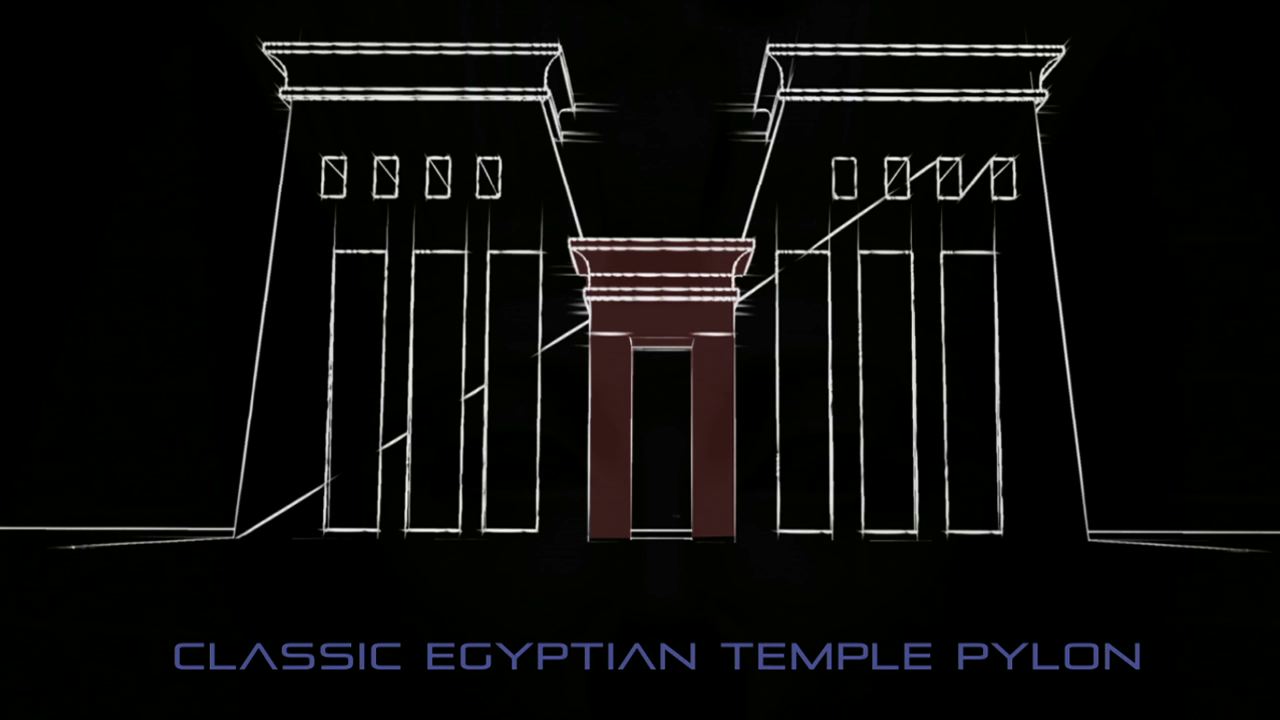
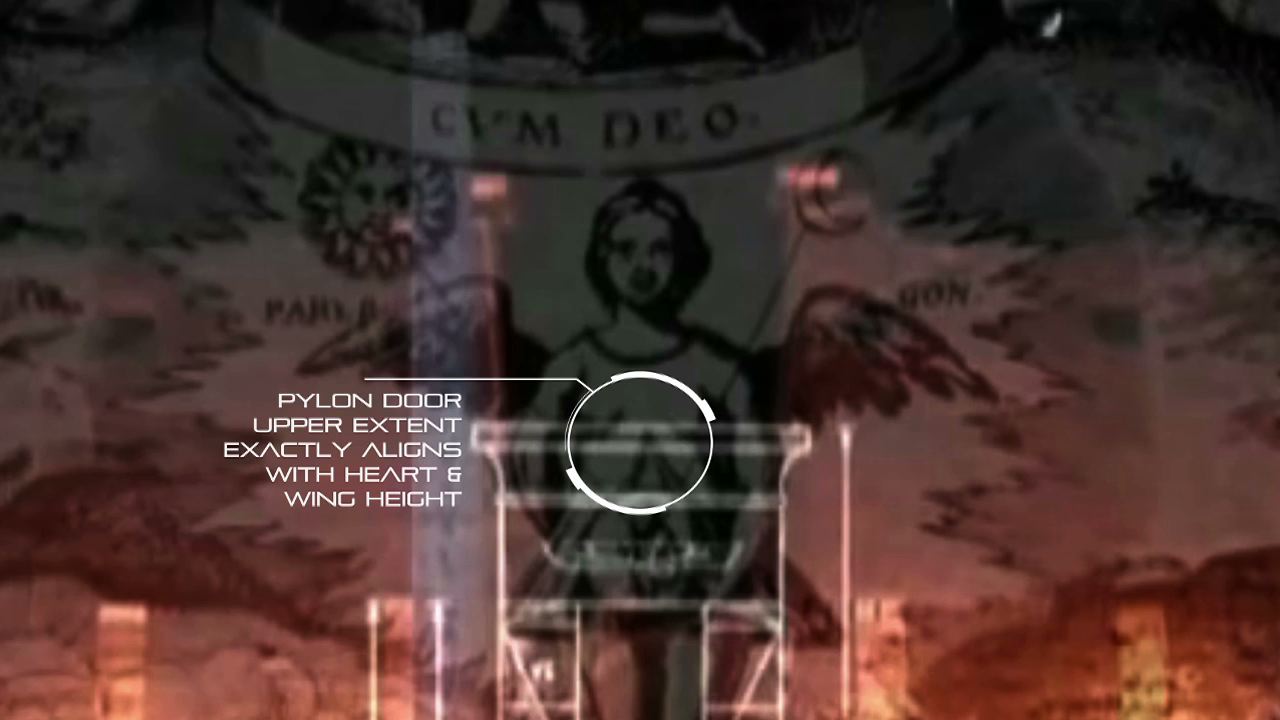
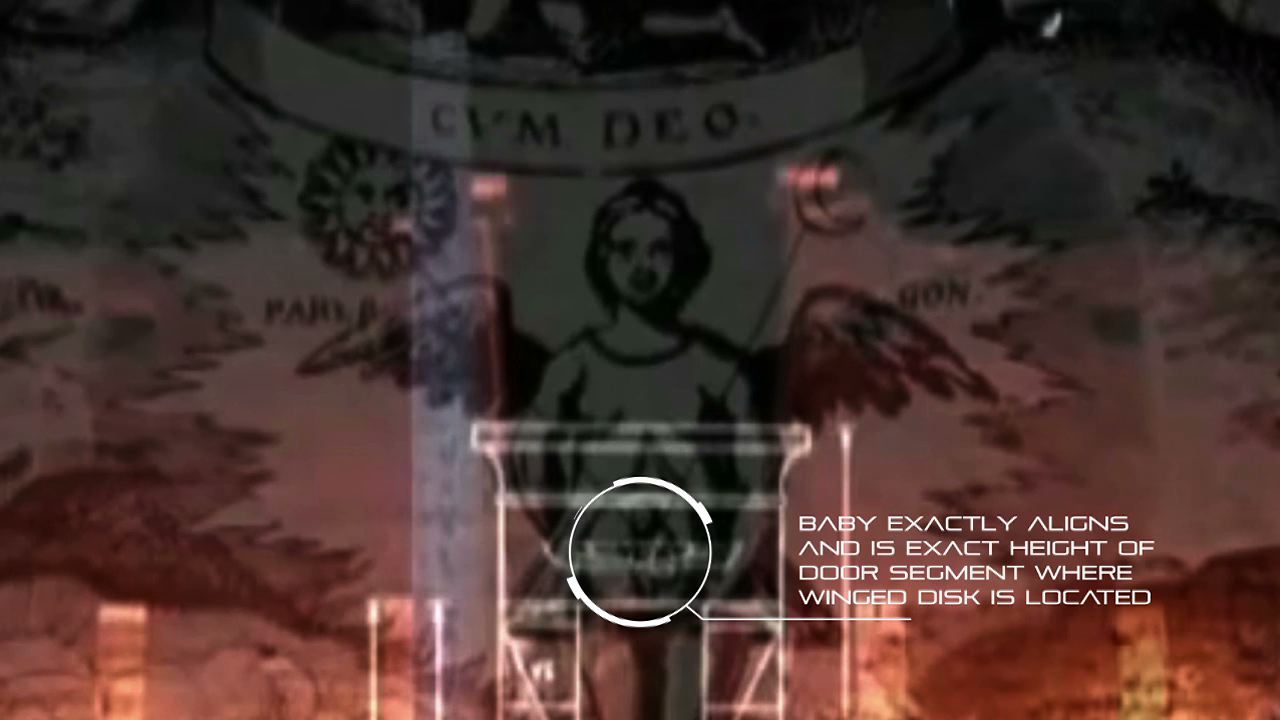
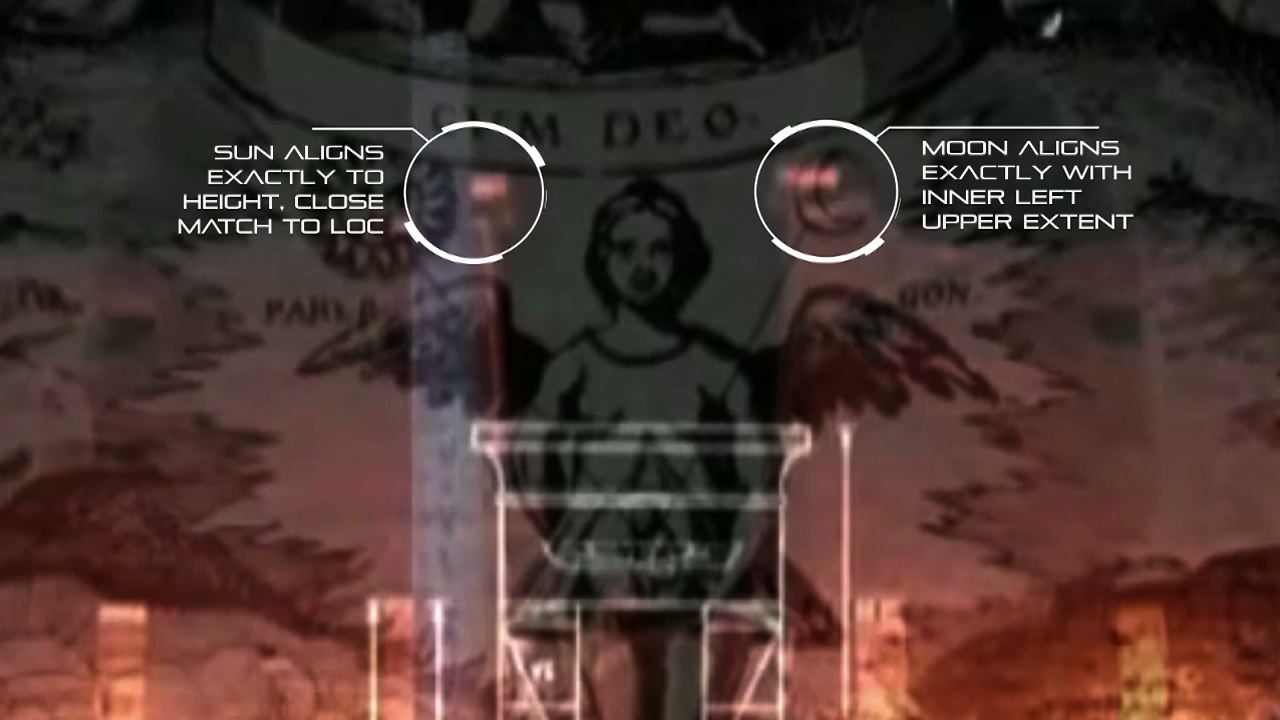

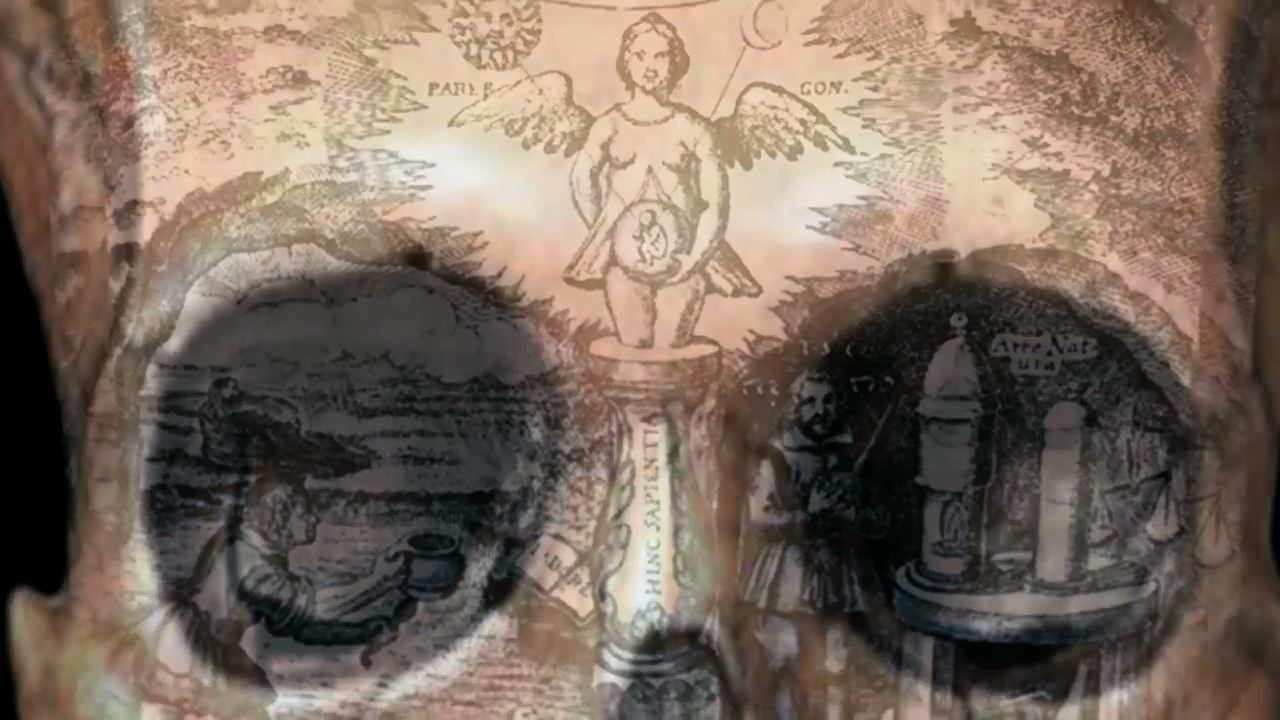
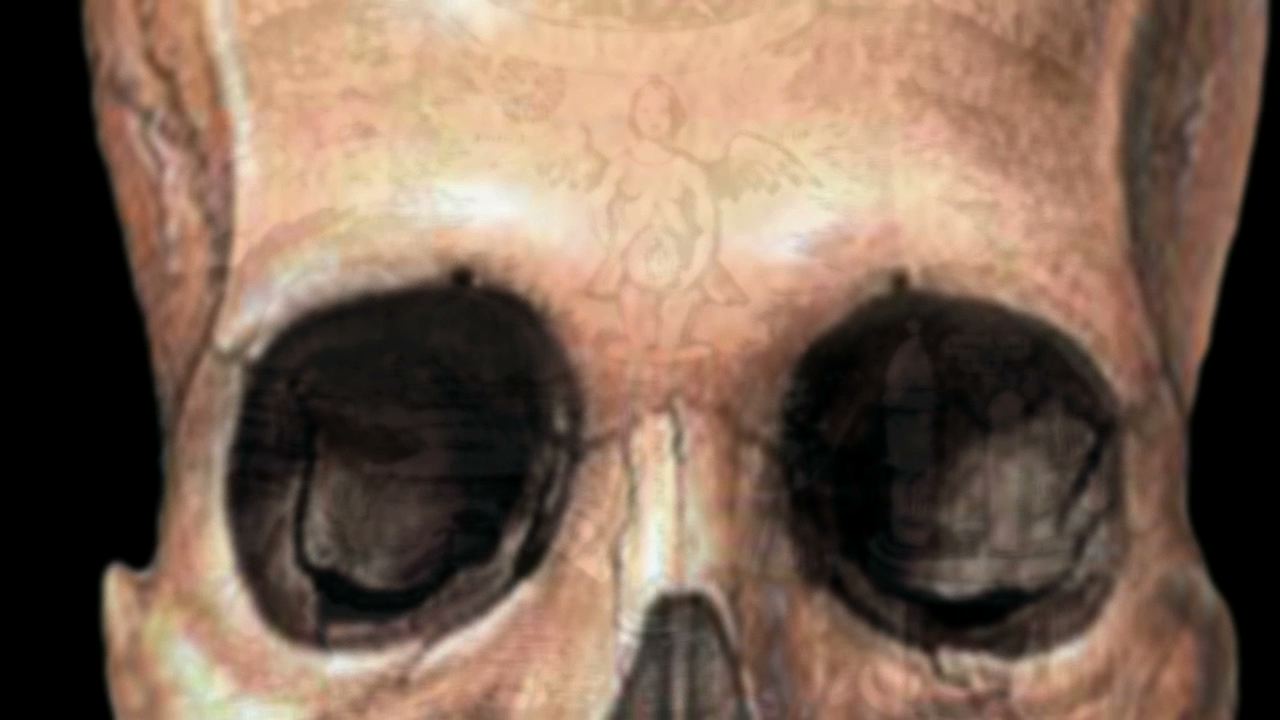
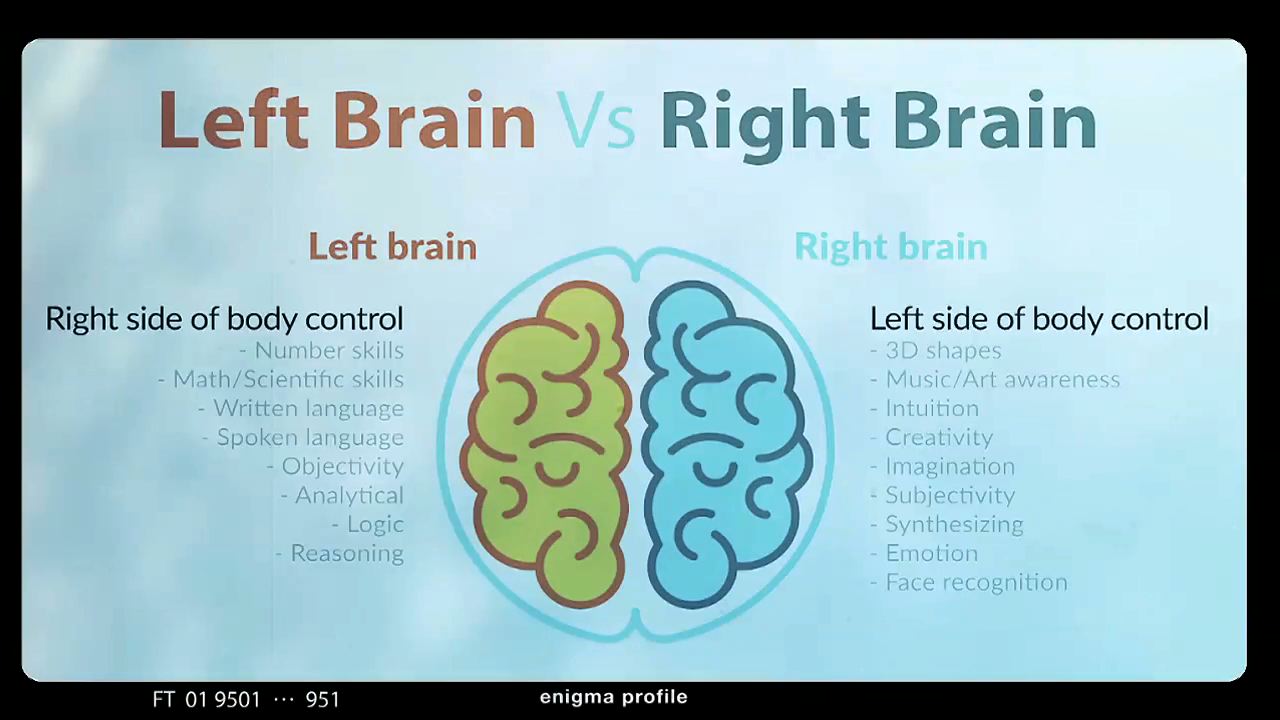

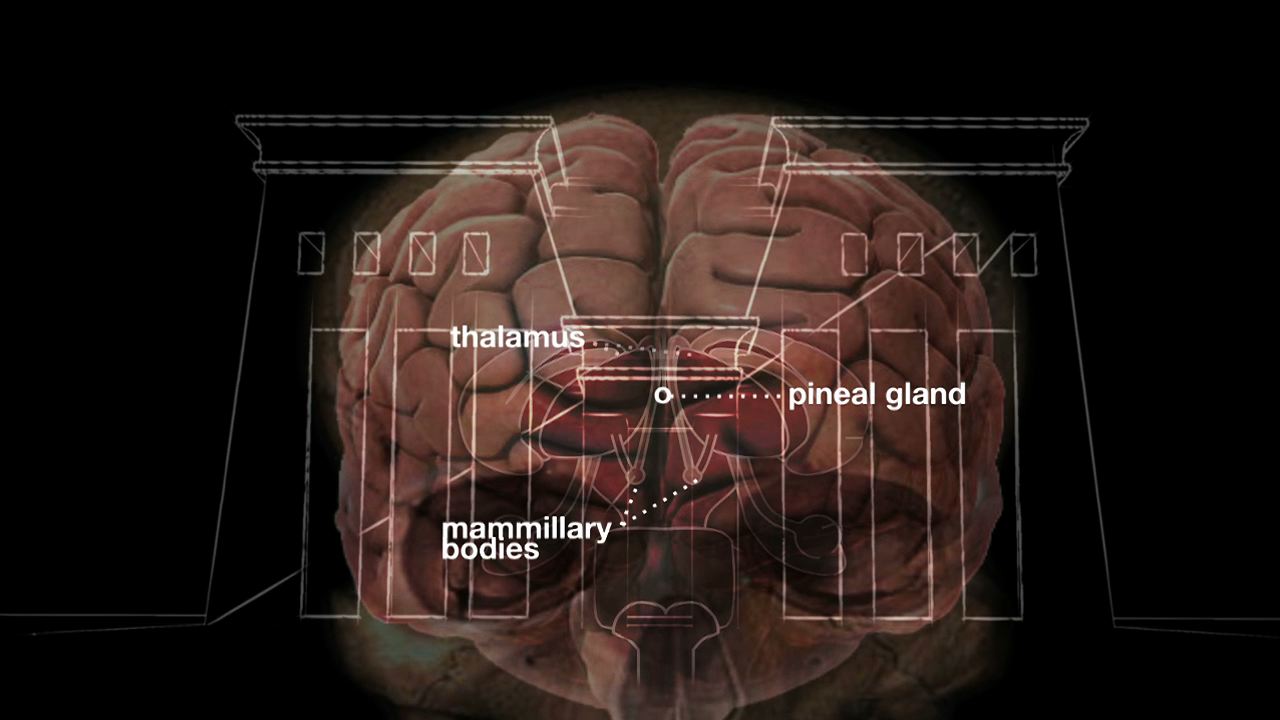
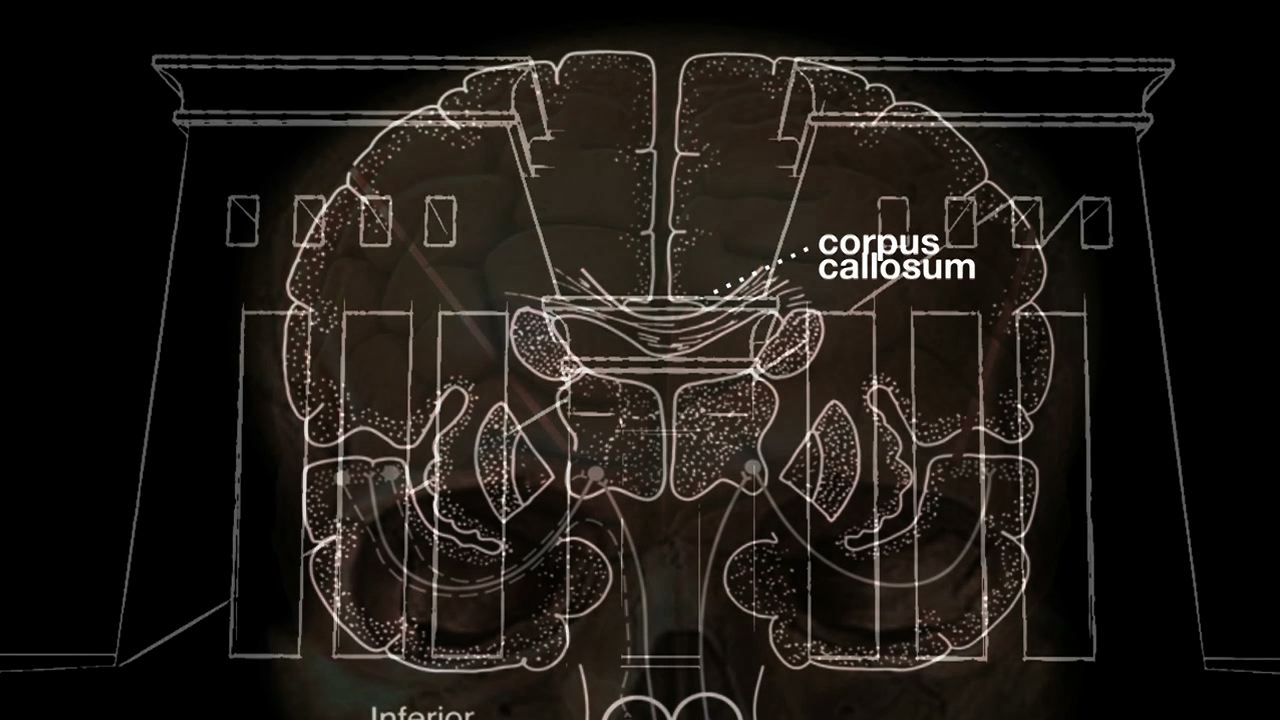
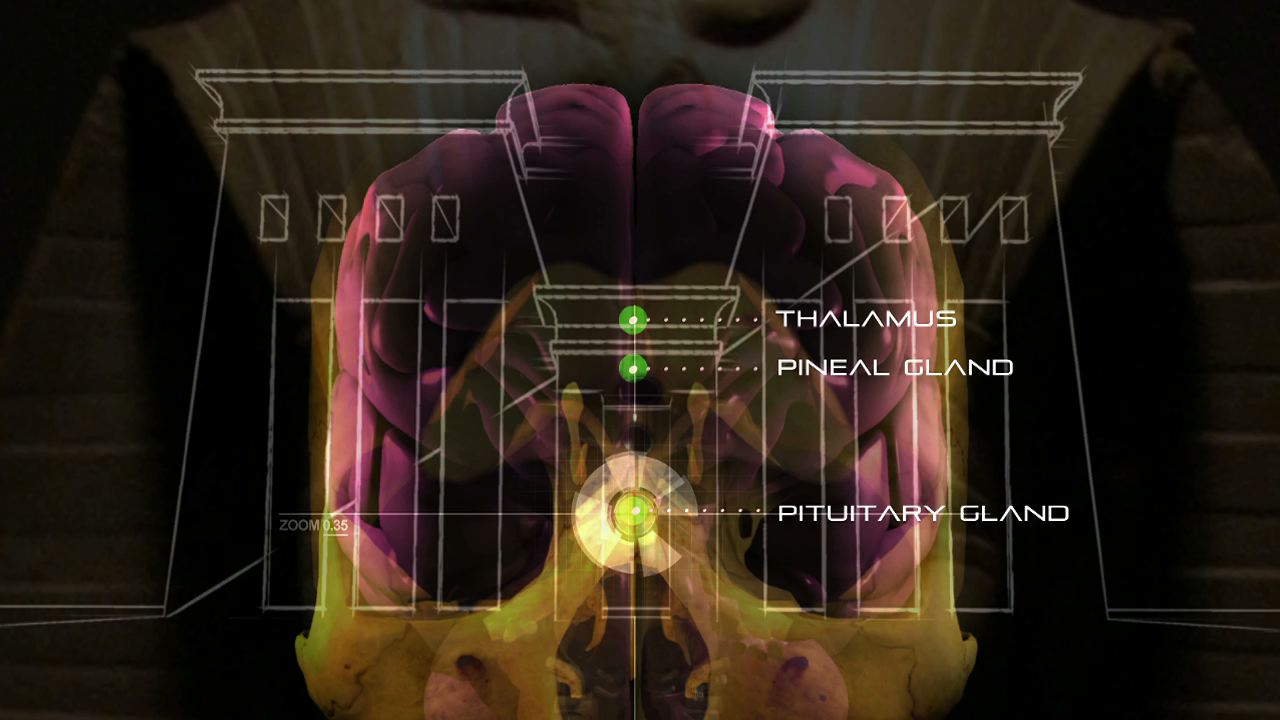
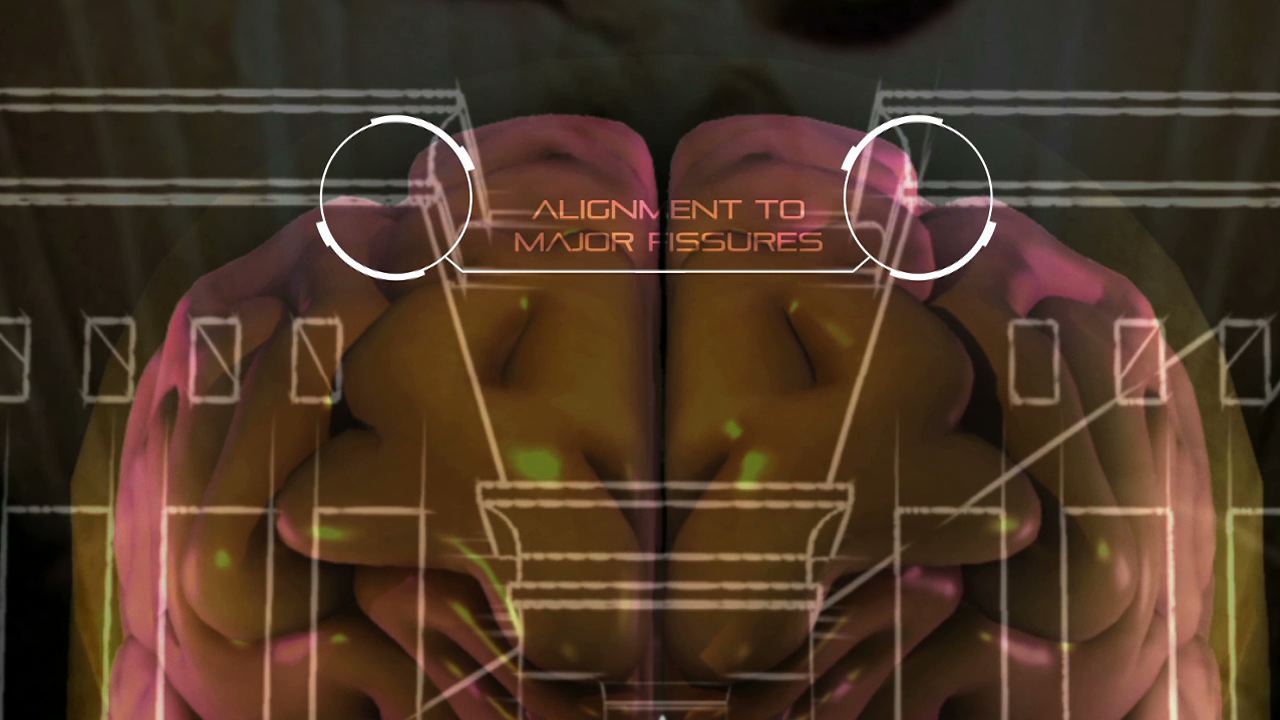
The pylon is a masterpiece of both symbolic and direct geometric correspondences with the coronal view of the left and right hemispheres of the cerebrum, the brain stem and diencephalon all matched or “templated” by the architecture of the temple and entrance door. The two rhomboidal “mounds” on either side are connected by a bridging architecture made up of the door and the symbolic corniche above the door. Ubiquitously located at the central focal point of every pylon temple is the hieroglyphic symbol of the winged disk. The entire pylon structure acts as a very sophisticated template or reference model of the structure of the hemispheres and brain stem, seen in the coronal view, with a special emphasis on the mirrored wing shapes made by the ventricles. The lines, positions, symbols, and underlying geometry all indicate the locations of important brain components when overlaid with one another.
Once again, we see mythos or legend associated with the various parts of the temple that may offer insight into the function of the part of the brain indicated, or into the overall operation of the subject of the schematic. This architecture symbolically associates with the timeless idea of the newly born sun, rising between the primordial mounds. A symbolic allegory for the arising of a certain kind of consciousness from the interaction of the two hemispheres, brought together, or unified, or accessed, in the case of door symbolism, by passing through a threshold of sorts - the central door that unites the two hemispheres.
Not only do the position and proportions of the door correspond to significant parts of the brainstem, but when a cross-section of the brain is seen at the right depth, we can even see that the ventricles, which are of central importance to brain function and consciousness, are the morphological inspiration for the icon of the winged disk, itself a symbolically rich symbol associated with higher, or unified consciousness and with the continuity of consciousness after physical death.
This method of encrypting a kind of “meta-message” into temple architecture, once this MODE OF EXPRESSION was understood, eventually led to recognizing the same technique, and presumably the same ancient science in the earliest Eastern temples. In a case very similar to Egyptology’s reluctance to acknowledge the idea of biological correspondence, the meta-message of the ancient Taoist temples expresses the same centrally important information, in the same way - through biological correspondence. And although it would seem that this discovery could represent an important new expansion of our understanding of ancient history and ancient intellect, this meta visual language is not officially acknowledged by Eastern historians as it is not currently acknowledged by orthodox Egyptology.
This series of discoveries was made by series writer/animator Chance Gardner, in the process of researching material for the new ME2 series.

Morsels
Morsels
Morsels are a snippets of discussions about an episode of Magical Egypt featuring a guest from the show. Bite Sized for your pleasure!
ME2EP5 - Chance Gardner and Brad Klausen
Ancient Egyptian Art and the New Rosetta Stone
Kundalini and Alchemy
The Great Pyramid - The Question Machine
Egyptian Mysteries and Accessing Other States of Consciousness
ME2EP5 - CHANCE GARDNER AND AARON CHEAK
Alchemy and transmutation of energy, and the primordial being
The Organ of Perception on the Imaginal Realm
Religion of Ancients vs Science, Hermes Trismegistus Hermetic Science.







